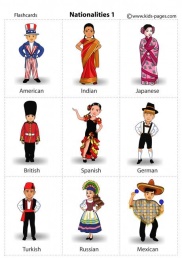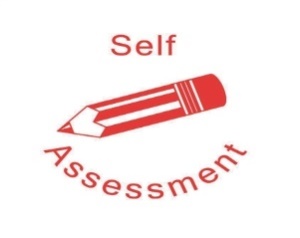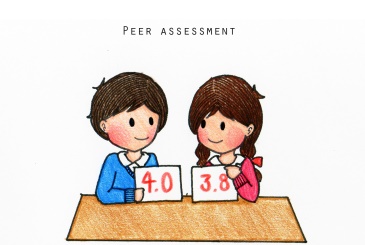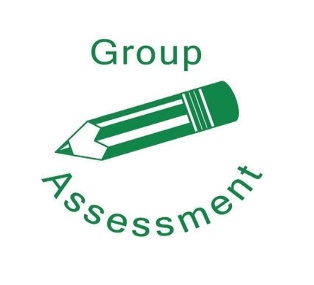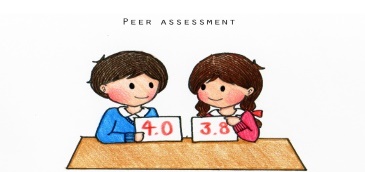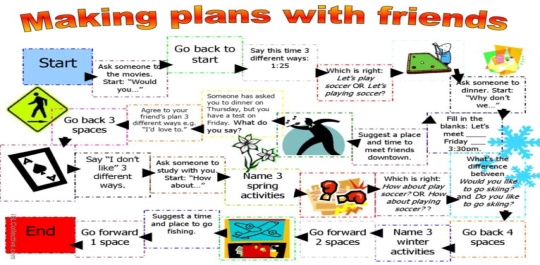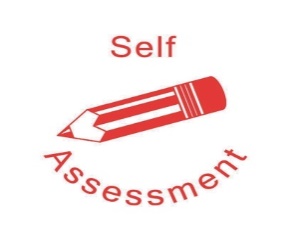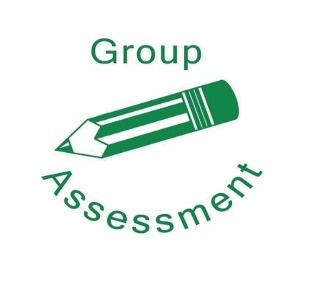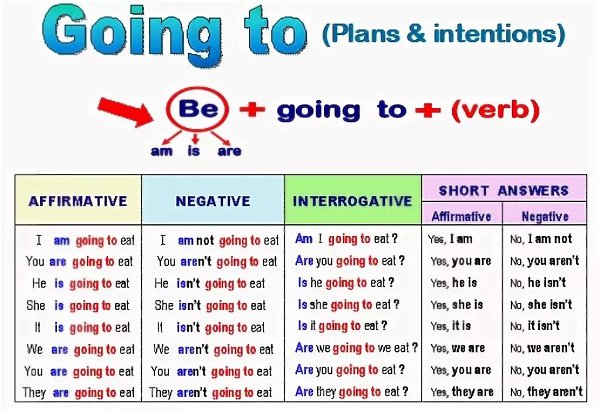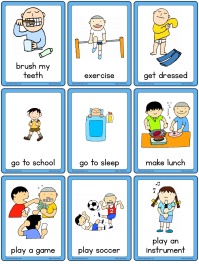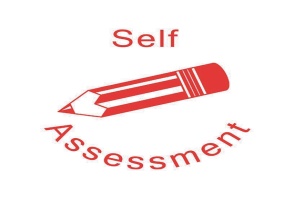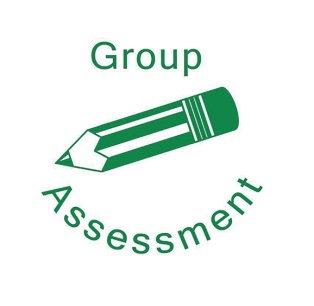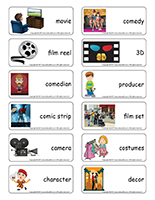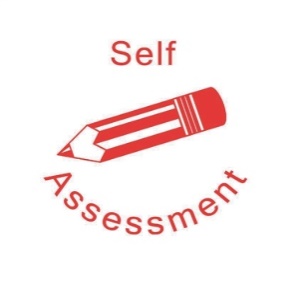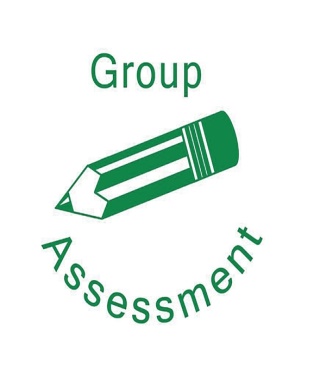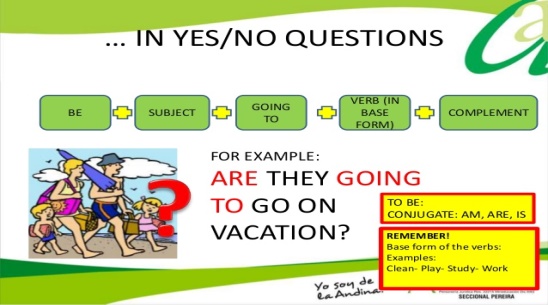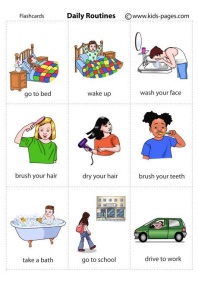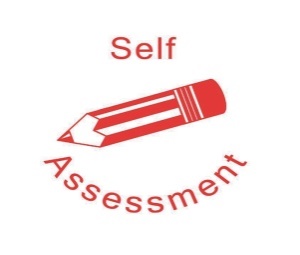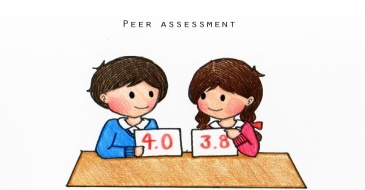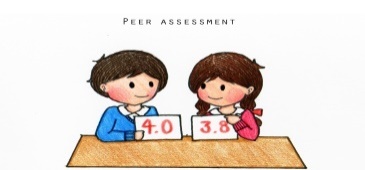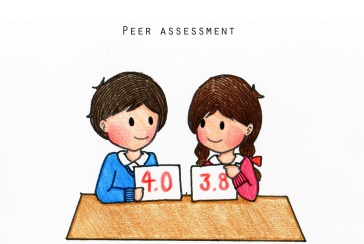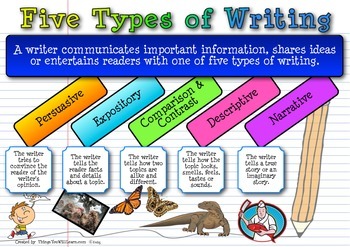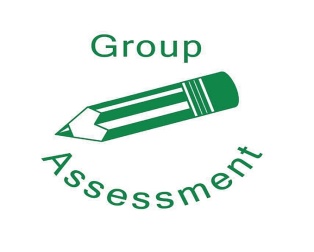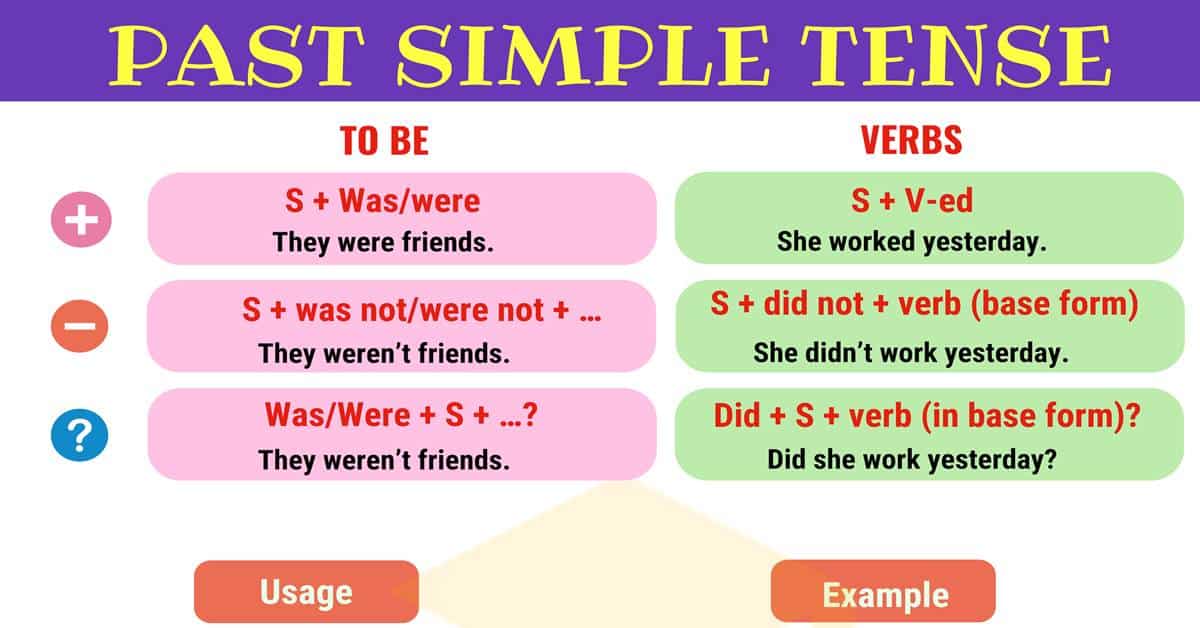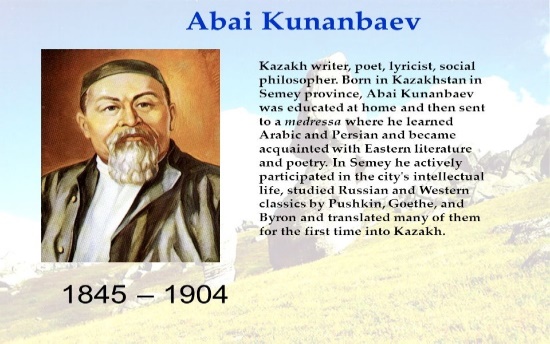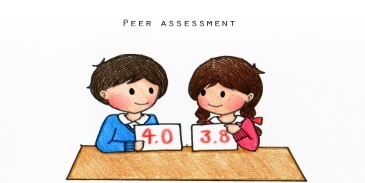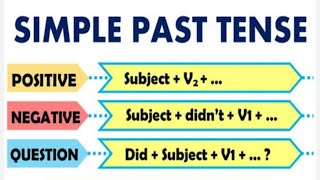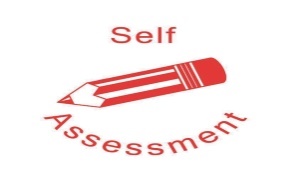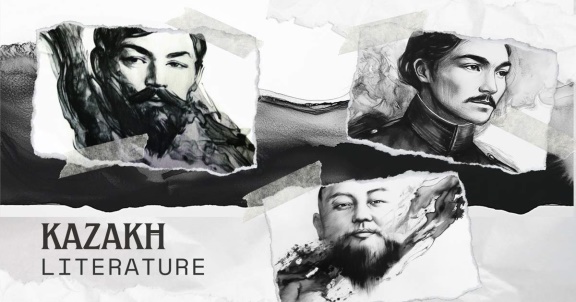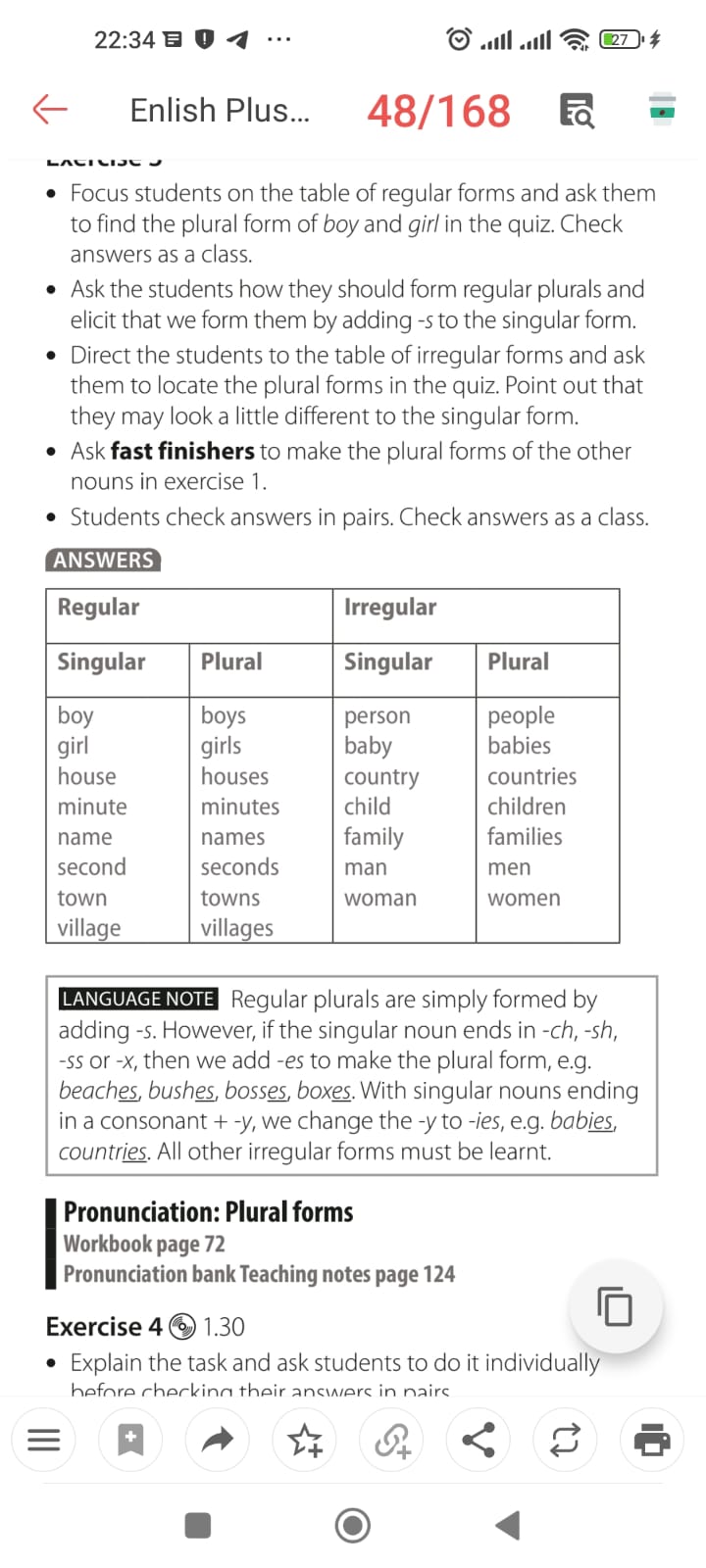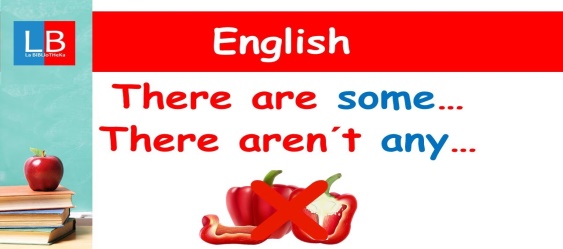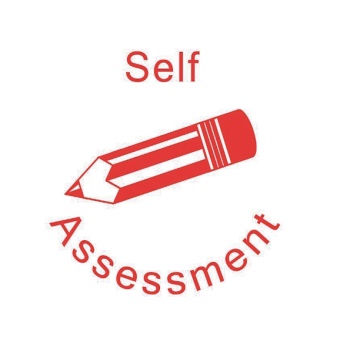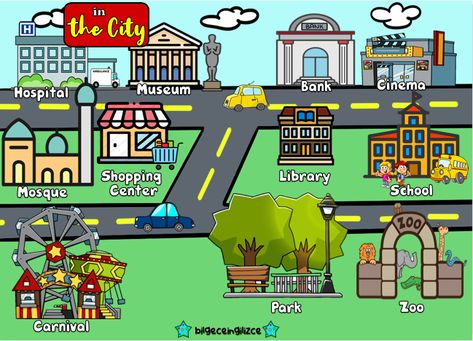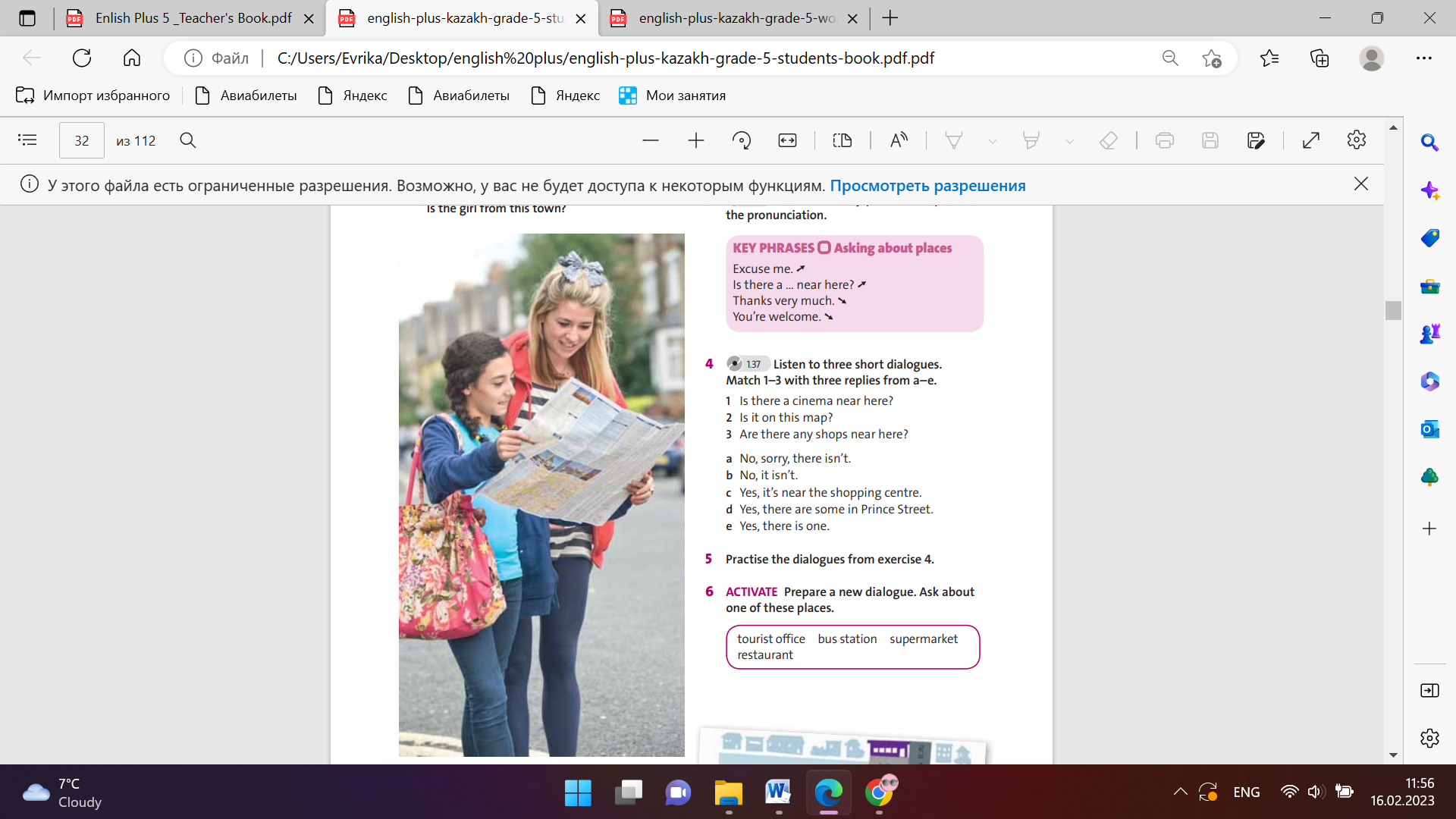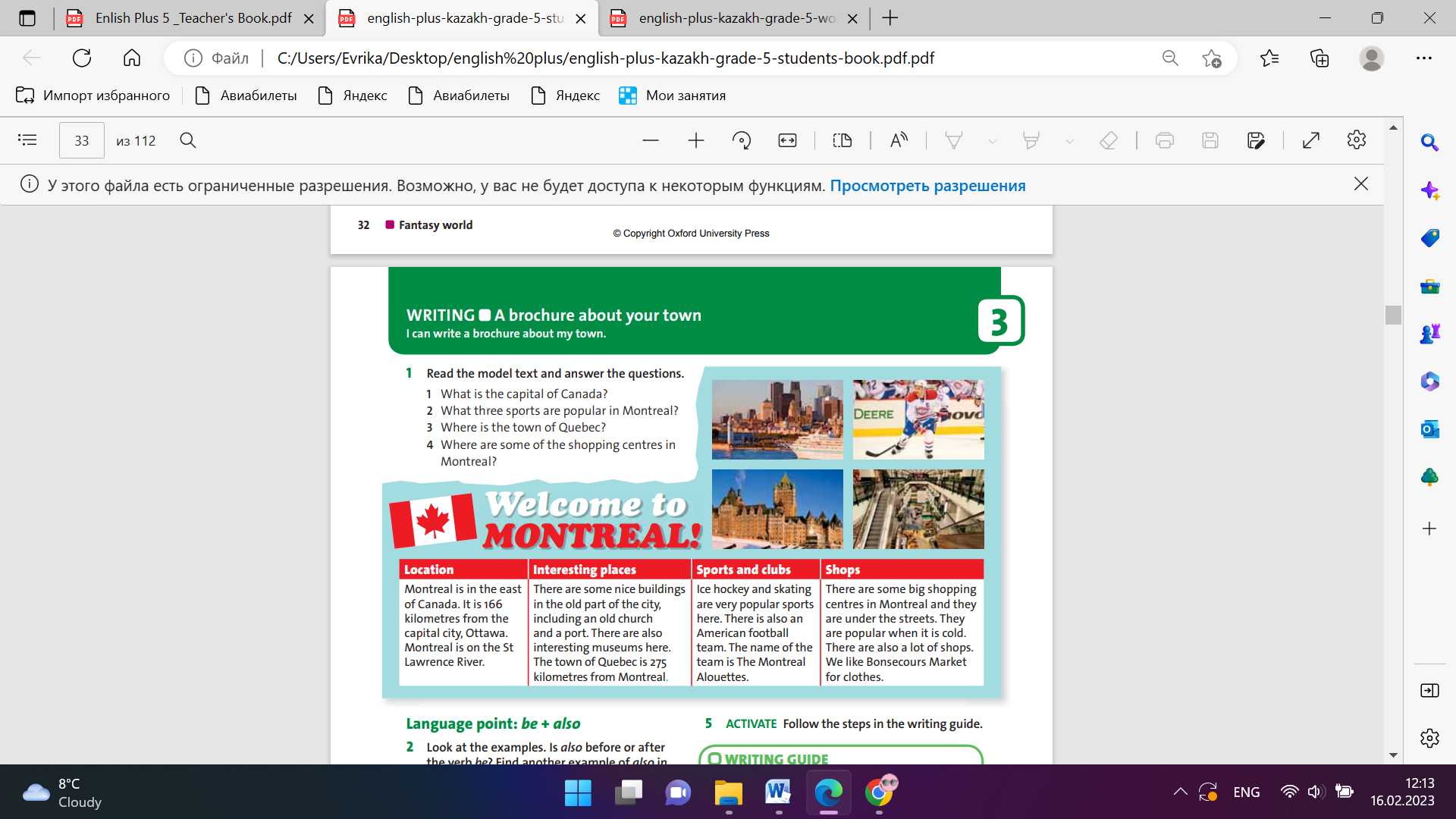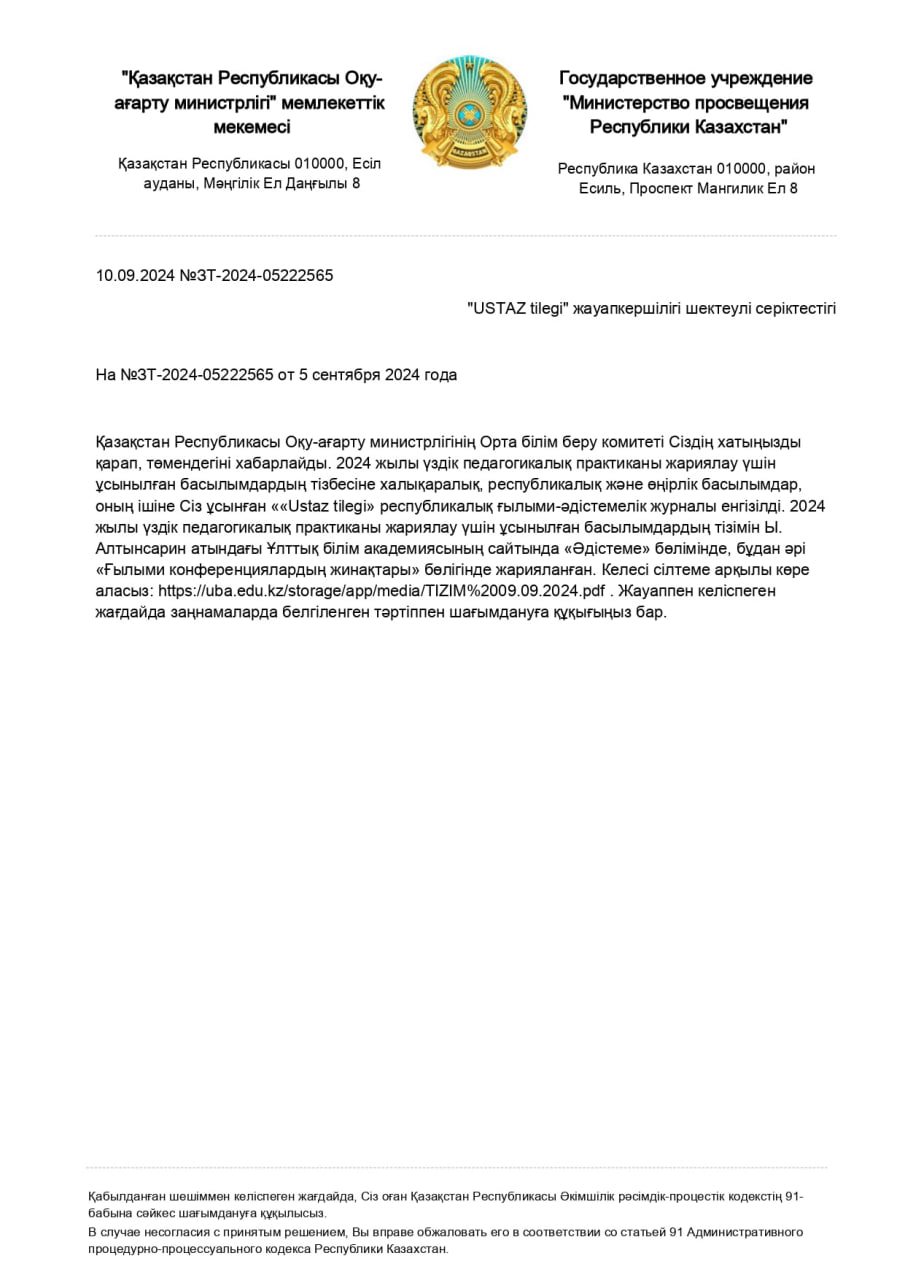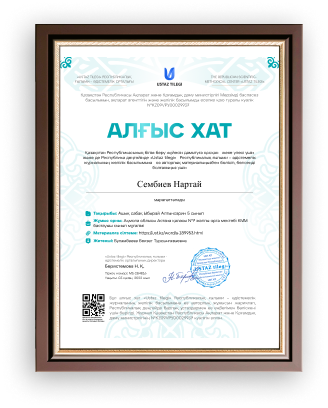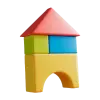
Short term plan
|
Unit 8 Creativity |
lesson 49 |
||
|
School: |
|
||
|
Teacher name: |
|
||
|
Date: |
|
||
|
Grade: 5 |
Number present: |
absent: |
|
|
Lesson title |
Culture |
||
|
Learning objectives |
5. 2. 4. 1 to understand general and educational topics in a long conversation with the support of the main ideas; 5. 3. 7. 1 using subject-specific vocabulary and syntax within a range of general topics 5. 5. 1. 1 plan, write, correct and check text-level works on some general and academic topics; |
||
|
Lesson objectives (assessment criteria) |
Learners will be able to: - Learn and practise nouns to talk about public places connected with culture. - Practise talking about artists especially from Kazakhstan. |
||
|
Value links |
"Law and Order" Know the basics of the legal system and human rights |
||
|
Stages/ Time |
Teachers actions |
Students actions |
Assessment |
Resources |
|
Beginning 5 min |
Greeting. (Whole class, Individually) T tells the class to make groups of 2. Warm up: Books closed. Ask students to work in pairs to think of places in Kazakhstan connected with culture. Do an example with the whole class, e.g. the Academic Opera and Ballet Theatre in Almaty. After about two minutes, stop the students. Get feedback from a few pairs by asking a few students to describe one of the places they thought of Setting the aim of the lesson.
|
Learners read the given sentences on the board and guess the topic and share with their ideas. Remember and recognize the main vocabulary. |
Teacher controles the process, gives feedback and asks additional questions if it’s nessasery. Teacher evaluate pupils with phrases like: “Good job! Well done!” Formative Assessment |
Flashcards
|
|
Middle 35 min |
Task. I (Wh, I) (pair dicsussion) Ex: 1 P:96 Focus students’ attention on the quiz on page 97. Allow students a couple of minutes to look at the different buildings and ask them to answer the questions. Encourage them to use the clues in the picture and their own knowledge of Astana. When students have finished, ask for a show of hands for answer a or answer b in each case. |
Students do the quiz about buildings in Astana ANSWERS: 1 b 2 b 3 b 4 a 5 b 6 a |
Descriptor: - do the quiz about buildings in Astana Total: 2 point |
Student’s book |
|
|
Task. II (Wh, I) (Task for location) Ex: 2 P:96 Explain the task and do an example together to make sure students know what they have to do, pointing out that only one of the words on the left matches a word on the right. In a stronger class, ask students to do the activity individually before checking their answers in pairs. In a weaker class, check their understanding of the vocabulary and ask them to do the task in pairs. |
Learners match the places with the things ANSWERS: 1 c 2 e 3 f 4 b 5 a 6 d |
Descriptor: - match the places with the things Total: 2 point |
Stickers
|
|
|
Task. III (Task for understanding) Ex: 3 P:96 Explain the task and do an example with the class. Make sure the whole class understand the word sightseeing. Check the answers as a class. A learner with individual needs: will be supported by teacher and by helpers from his class. |
Learners put the verbs with the correct noun to make a collocation ANSWERS: 1 borrow 2 look at 3 watch 4 study 5 listen to 6 go |
Descriptor: - put the verbs with the correct noun - make a collocation Total: 2 point |
Pictures |
|
|
Task. IV (Task for understanding) Ex: 4 P:96 With the whole class look again at the quiz and ask students where they can do the activities in the exercise |
Learners look again at the quiz and answer the question ANSWERS look at some paintings Peace Palace watch a film – Khan Shatyr study history – Museum of the First President listen to live music – Peace Palace go sightseeing – Bayterek Tower |
Descriptor: - look at the quiz - answer the question Total: 2 point |
|
|
|
Task V Ex 5 P:96 Look at the words in the box with the Class and check they understand what each type of creative person does, e.g. a film director makes films. Give students a few minutes to think of the answers. Let them check in pairs if they are not sure of the answers. |
Learners complete the sentences with the names for creative people. ANSWERS 1 poet 2 artist 3 film director 4 playwright 5 pop band |
- complete the sentences - identify each type of creative person Total: 2 point |
|
|
End 5 min |
The Ladder method was used as a reflection. T asks Ss to stick their stickers to the Success Ladder. Green- I understood Yellow-I have some questions Red-I need a help. Ex: P: Home task |
What worked well for you in today’s class? What could we have done differently to make today’s class better for you? What are you wondering about after today’s lesson? What did you find difficult about today’s lesson? |
Poster Success Ladder |
|
Short term plan
|
Unit 8 Creativity |
lesson 50 |
||
|
School: |
|
||
|
Teacher name: |
|
||
|
Date: |
|
||
|
Grade: 5 |
Number present: |
absent: |
|
|
Lesson title |
Making plans |
||
|
Learning objectives |
5. 4. 2. 1 understand specific information in simple, short texts on a number of general and educational topics with little help from the teacher; 5. 5. 4. 1 write long sentences in paragraph size with the teacher's support to provide personal information; |
||
|
Lesson objectives (assessment criteria) |
Learners will be able to: - Learn and practise verbs to talk about plans. - Understand text messages about plans |
||
|
Value links |
"Law and Order" Observance of norms and rules of order and justice understand the need |
||
|
Stages/ Time |
Teachers actions |
Students actions |
Assessment |
Resources |
|
Beginning 5 min |
Greeting. (Whole class, Individually) T tells the class to make groups of 2. Warm up: Books closed. Ask the class what they like doing when they visit another city or country. Get students to think of two categories – things to do inside and outside. Make a list on the board. Ask students to give details about places they have visited and what they liked doing. Setting the aim of the lesson.
|
Learners read the given sentences on the board and guess the topic and share with their ideas. Remember and recognize the main vocabulary. |
Teacher controles the process, gives feedback and asks additional questions if it’s nessasery. Teacher evaluate pupils with phrases like: “Good job! Well done!” Formative Assessment |
Flashcards
|
|
Middle 35 min |
Task. I (Wh, I) (pair dicsussion) Ex: 1 P:98 Ask students to read the two text messages and the Tours of Astana text. Discuss the question with the class. Encourage students to also think about information from the quiz. |
Students read the text message and the text about places in Astana ANSWERS: Students’ own answer |
Descriptor: - read the text message - discuss the question Total: 2 point |
Student’s book |
|
|
Task. II (Wh, I) (Task for location) Ex: 2 P:98 Play the recording for students to check their answers and compare them with Samat’s ideas. In a weaker class, pause the recording after each place is mentioned. |
Learners listen and check your answers. Which places does Samat choose? ANSWERS: Bayterek Tower, Khan Shtyr and Hazret Sultan. |
- listen and check - compare them with Samat’s ideas. Total: 2 point |
Stickers
|
|
|
Task. III (Task for understanding) Ex: 3 P:98 Tell students to read all three texts again and answer the questions. Circulate and monitor. Check that weaker students can follow which text has the relevant information.
A learner with individual needs: will be supported by teacher and by helpers from his class. |
Learners read the text again write true or false ANSWERS: 1 true 2 false 3 false 4 true 5 false 6 true |
Feedback: “Thumbs up, thumbs down” After correct answer teacher shows thumbs up, if there are some mistakes thumbs down with comments Descriptor: - read the text - write true or false Total: 2 point |
Pictures |
|
|
Task. IV (Task for understanding) Ex: 4 P:98 Explain the task. Draw students’ attention to the fact that the words to not occur in the order they are in the exercise and students should look for the phrases in the text rather than read the text in detail. |
Learners find these words in the texts. ANSWERS 1 a river where you can row a boat. 2 a place that is high up where you can see a wide view. 3 a large room where people meet. 4 a place where people get together to present and discuss ideas. 5 a place with sand and sea where people can relax. 6 the place where a person can work, e.g. an office. |
Descriptor: - look for the phrases in the text - read the text in detail Total: 2 point |
Student’s book |
|
End 5 min |
The Ladder method was used as a reflection. T asks Ss to stick their stickers to the Success Ladder. Green- I understood Yellow-I have some questions Red-I need a help. Ex: P: Home task |
What worked well for you in today’s class? What could we have done differently to make today’s class better for you? What are you wondering about after today’s lesson? What did you find difficult about today’s lesson? |
Poster Success Ladder |
|
Short term plan
|
Unit 8 Creativity |
lesson 51 |
||
|
School: |
|
||
|
Teacher name: |
|
||
|
Date: |
|
||
|
Grade: 5 |
Number present: |
absent: |
|
|
Lesson title |
Language Focus: be going to affirmative and negative |
||
|
Learning objectives |
5. 3. 4. 1 respond in sentences with some flexibility to unexpected comments on a variety of general and academic topics; 5. 5. 3. 1 write specific details with the support of the teacher, describing people, places and objects at the text level; 5. 6. 10. 1 use of present and future continuous tense forms on limited familiar general and educational topics; |
||
|
Lesson objectives (assessment criteria) |
Learners will be able to: - Learn and practise be going to affirmative and negative forms. - Use be going to talk about plans and intentions. |
||
|
Value links |
"Law and Order" Ensuring the protection and safety of society understand the importance of law and order as |
||
|
Stages/ Time |
Teachers actions |
Students actions |
Assessment |
Resources |
|
Beginning 5 min |
Greeting. (Whole class, Individually) T tells the class to make groups of 2. Warm up: Books closed. Ask the class to imagine they have unlimited money and a week to spend it. Ask them to decide on three things they are going to do. Put some ideas on the board. Discuss with the class which are the most interesting plans Setting the aim of the lesson.
|
Learners read the given sentences on the board and guess the topic and share with their ideas. Remember and recognize the main vocabulary. |
Teacher controles the process, gives feedback and asks additional questions if it’s nessasery. Teacher evaluate pupils with phrases like: “Good job! Well done!” Formative Assessment |
Flashcards
|
|
Middle 35 min |
Task. I (Wh, I) (pair dicsussion) Ex: 1 P:99 Tell the class to read the text messages again and find the missing forms. |
Students find the forms in the text messages ANSWERS: 1 I’m going to 2 We’re not going |
Descriptor: - read the text - find the missing forms. Total: 2 point |
Student’s book |
|
|
Task. II (Wh, I) (Task for location) Ex: 2 P:99 Draw students’ attention to the photo of the food. Ask them what it is and if they like it. Explain the task. Tell students to read the whole text once before choosing the verbs. Check answers as a class. |
Learners read and complete the text with the verbs. ANSWERS: 1 take 2 walk 3 eat 4 visit 5 watch |
- read and complete the text Total: 2 point |
Stickers
|
|
|
Task. III (Task for understanding) Ex: 3 P:99 Explain the task. Students complete the activity individually and check their answers in pairs. Remind students to use the table in exercise 1 to help them. Check answers as a class. |
Learners complete the sentences with the correct words. ANSWERS: 1 to go 2 ’m 3 ’re going 4 ’re, have 5 ’s 6 ’s going, watch |
Descriptor: - complete the sentences - use the table Total: 2 point |
Pictures |
|
|
Task. IV (Task for understanding) Ex: 4 P:99 Tell the students to look at the notice board. Ask who the notice board is for (Answer: tourists), and how many activities there are (Answer: four). Explain the task. Make sure students Write complete sentences using be going to. When they are ready, ask students to read out one sentence each. Differentiation: A learner with individual needs: will be supported by teacher and by helpers from his class. |
Learners look at the tourist notice board and write three sentences about the activity. ANSWERS 2 On Wednesday we’re going to visit the Peace Palace. 3 On Thursday we’re going to walk round the city centre. 4 On Friday morning we’re going to go up the Bayterek Tower. |
Descriptor: - look at the notice board - write three sentences Total: 2 point |
|
|
End 5 min |
The Ladder method was used as a reflection. T asks Ss to stick their stickers to the Success Ladder. Green- I understood Yellow-I have some questions Red-I need a help. Ex: P: Home task |
What worked well for you in today’s class? What could we have done differently to make today’s class better for you? What are you wondering about after today’s lesson? What did you find difficult about today’s lesson? |
Poster Success Ladder |
|
Short term plan
|
Unit 8 Creativity |
lesson 52 |
||
|
School: |
|
||
|
Teacher name: |
|
||
|
Date: |
|
||
|
Grade: 5 |
Number present: |
absent: |
|
|
Lesson title |
Films and stories |
||
|
Learning objectives |
5. 2. 4. 1 to understand general and educational topics in a long conversation with the support of the main ideas; 5. 3. 3. 1 express an opinion in a sentence within the framework of a number of general and educational topics; |
||
|
Lesson objectives (assessment criteria) |
Learners will be able to: - Learn and practise vocabulary to talk about films and stories. - Plan a film project. |
||
|
Value links |
"Law and Order" Know the basics of the legal system and human rights |
||
|
Stages/ Time |
Teachers actions |
Students actions |
Assessment |
Resources |
|
Beginning 5 min |
Greeting. (Whole class, Individually) T tells the class to make groups of 2. Warm up: Books closed. Ask the class to think of as many films as they can in one minute. After a minute ask for contributions and write them on the board. Ask the class to talk briefly about the type of films they are and which countries they are from. Setting the aim of the lesson.
|
Learners read the given sentences on the board and guess the topic and share with their ideas.
Remember and recognize the main vocabulary. |
Teacher controles the process, gives feedback and asks additional questions if it’s nessasery. Teacher evaluate pupils with phrases like: “Good job! Well done!” Formative Assessment |
Flashcards
|
|
Middle 35 min |
Task. I (Wh, I) (pair dicsussion) Ex: 1 P:100 Explain the task. Make sure students understand the meaning of alien, ghost, monster, knight and wizard. Circulate and monitor. Check answers as a class.
|
Students match the types of films ANSWERS: 1 h 2 e 3 f 4 a 5 g 6 c 7 d 8 b |
Descriptor: - understand the meaning of the words - match the types of films Total: 2 point |
Student’s book |
|
|
Task. II (Wh, I) (Task for location) Ex: 2 P:100 Tell students to work individually and think of an example of a film for types 1-8. When they are ready, put them in pairs to test each other. One student says the name of the film and the other student guesses the type of film. Circulate and monitor.
|
Learners work individually and think of an example of a film for types ANSWERS: Student’s own answer |
- read and complete the text Total: 2 point |
Stickers
|
|
|
Task. III (Task for understanding) Ex: 3 P:100 In pairs, students do the quiz. Give them a time limit. When time is up, ask pairs for answers and write them on the board. Do not say if they are right or wrong. Play the recording. Students check if their answers were correct. Count up the correct scores and nominate a winner.
|
Learners do the film Quiz. Then listen and check your answers. ANSWERS: 1 Finding Nemo 2 Harry Potter 3 Beauty and the Beast 4 Superman 5 Harmony Lessons |
- do the quiz - listen and check Total: 2 point |
Pictures |
|
|
Task. IV (Task for understanding) Ex: 4 P:100 In pairs, ask students to read out a question and answer for the rest of the class. The class guess which film it is. . Differentiation: A learner with individual needs: will be supported by teacher and by helpers from his class. |
Learners answer the question. Which films in the Film Quiz are these questions and answers connected to? ANSWERS: 1 Harmony Lessons 2 Harry Potter 3 Beauty and the Beast 4 Finding Nemo 5 Superman |
Descriptor: - read out a question - answer the question. Total: 2 point |
|
|
End 5 min |
The Ladder method was used as a reflection. T asks Ss to stick their stickers to the Success Ladder. Green- I understood Yellow-I have some questions Red-I need a help. Ex: P: Home task |
What worked well for you in today’s class? What could we have done differently to make today’s class better for you? What are you wondering about after today’s lesson? What did you find difficult about today’s lesson? |
Poster Success Ladder |
|
Short term plan
|
Unit 8 Creativity |
lesson 53 |
||
|
School: |
|
||
|
Teacher name: |
|
||
|
Date: |
|
||
|
Grade: 5 |
Number present: |
absent: |
|
|
Lesson title |
Be going to(questions) |
||
|
Learning objectives |
5. 3. 4. 1 respond in sentences with some flexibility to unexpected comments on a variety of general and academic topics; 5. 5. 7. 1 use a format appropriate to the level of the text in some written genres on a familiar general and a number of reading topics with some support 5. 6. 10. 1 use of present and future continuous tense forms on limited familiar general and educational topics; |
||
|
Lesson objectives (assessment criteria) |
Learners will be able to: - Learn and practise using be going to question forms. - Using be going to to ask about plans |
||
|
Value links |
"Law and Order" Observance of norms and rules of order and justice understand the need |
||
|
Stages/ Time |
Teachers actions |
Students actions |
Assessment |
Resources |
|
Beginning 5 min |
Greeting. (Whole class, Individually) T tells the class to make groups of 2. Warm up: Books closed. Ask the class to think of things they are going to do next week. Write them on the board, e.g. go to school, play football. Ask students to make affirmative and negative sentences using the ideas. Ask the class to suggest corrections if they hear a mistake. Setting the aim of the lesson.
|
Learners read the given sentences on the board and guess the topic and share with their ideas. Remember and recognize the main vocabulary. |
Teacher controles the process, gives feedback and asks additional questions if it’s nessasery. Teacher evaluate pupils with phrases like: “Good job! Well done!” Formative Assessment |
Flashcards
|
|
Middle 35 min |
Task. I (Wh, I) (pair dicsussion) Ex: 1 P:101 Explain the task. Give students a few minutes to work individually reading and filling in the table. Students check their answers in pairs. Check answers as a class.
|
Students complete the table with the words in the box. ANSWERS: 1 Are 2 am 3 isn’t 4 is |
Descriptor: - complete the table - use words in the box Total: 2 point |
Student’s book |
|
|
Task. II (Wh, I) (Task for location) Ex: 2 P:101 Put students in pairs. Explain the task. When the students have completed the sentences tell them to practise saying the sentences together. Monitor the students as they speak, making a note of any errors you would like to address later.
|
Learners complete the questions and answers ANSWERS: 1 am 2 Is, isn’t 3 are, ’re 4 we, aren’t 5 Is, is 6 ’m not 7 ’re 8 ’s, is |
- complete the questions - answer the question Total: 2 point |
Stickers
|
|
|
Task. III (Task for understanding) Ex: 3 P:101 Draw students’ attention to the example. Ask students to explain the rule for making questions with be going to (Answer: the correct form of be followed by the subject). Ask if we use the short form of be in short answers (Answer: no). Explain the task. Students work individually and then check their answers in pairs. Circulate and monitor. Make sure students make positive questions, e.g. ‘Are the criminals going to win?’, not ‘Aren’t the criminals going to win?’
|
Learners make the sentences into questions and short answers ANSWERS: 1 Is she going to save her friends? Yes, she is. 2 Are the princess and the beast going to fall in love? Yes, they are. 3 Are we going to find my sister? Yes, we are. 4 Are the criminals going to win? No, they aren’t. 5 Are you going to find your son? Yes, I am. 6 Is the evil wizard going to die? Yes, he is. 7 Is winter going to end soon? No, it isn’t. 8 Are the fish going to escape? Yes, they are. |
- make the sentences - give short answers Total: 2 point |
Pictures |
|
|
Task. IV (Task for understanding) Ex: 4 P:101 Do the first sentence with the class. Write the sentence on the board as a model for weaker students. Make sure students write the sentences as they will need them in the next exercise. Get the students to read out their Questions when they are ready. Differentiation: A learner with individual needs: will be supported by teacher and by helpers from his class. |
Learners make questions with be going to ANSWERS: 1 Are you going to watch a film this week? 2 Where are you going to go on holiday this year? 3 How many books are you going to read this month? 4 Are you going to play football tomorrow? 5 What are you going to eat for supper tonight? 6 Are you going to do your homework on time? |
Descriptor: - make questions - write the sentences Total: 2 point |
|
|
End 5 min |
The Ladder method was used as a reflection. T asks Ss to stick their stickers to the Success Ladder. Green- I understood Yellow-I have some questions Red-I need a help. Ex: P: Home task |
What worked well for you in today’s class? What could we have done differently to make today’s class better for you? What are you wondering about after today’s lesson? What did you find difficult about today’s lesson? |
Poster Success Ladder |
|
Short term plan
|
Unit 8 Creativity |
lesson 54 |
||
|
School: |
|
||
|
Teacher name: |
|
||
|
Date: |
|
||
|
Grade: 5 |
Number present: |
absent: |
|
|
Lesson title |
Unit Review Summative assessment for the unit ” Creativity”p102 |
||
|
Learning objectives |
5. 5. 6. 1 logically combine sentences into paragraphs with some support using basic connectives on some common topics; 5. 6. 10. 1 use of present and future continuous tense forms on limited familiar general and educational topics; |
||
|
Lesson objectives (assessment criteria) |
Learners will be able to: - Learn and practise nouns - Learn and practise verbs to talk about plans. - Learn and practise vocabulary to talk about films |
||
|
Value links |
"Law and Order" Ensuring the protection and safety of society understand the importance of law and order as |
||
|
Stages/ Time |
Teachers actions |
Students actions |
Assessment |
Resources |
|
Beginning 5 min |
Greeting. (Whole class, Individually) T tells the class to make groups of 2. Warm up: Books closed. Ask the class to think of as many films as they can in one minute. After a minute ask for contributions and write them on the board. Ask the class to talk briefly about the type of films they are an Setting the aim of the lesson. |
Learners read the given sentences on the board and guess the topic and share with their ideas. Remember and recognize the main vocabulary. |
Teacher controles the process, gives feedback and asks additional questions if it’s nessasery. Teacher evaluate pupils with phrases like: “Good job! Well done!” Formative Assessment |
|
|
Middle 35 min |
Task. I (Wh, I) (pair dicsussion) Ex: 1 P:102 Explain the task and do an example Together to make sure students know what they have to do, pointing out that only one of the words on the left matches a word on the right.
|
Students match the things with the places ANSWERS: 1 painting 2 show 3 book 4 film 5 play 6 exhibit |
Descriptor: - match the things - complete the task Total: 2 point |
Student’s book |
|
|
Task. II (Wh, I) (Task for location) Ex: 2 P:102 Explain the task. Students complete the activity individually and check their answers in pairs
|
Learners choose the correct words. ANSWERS: 1 borrow 2 look at 3 watch 4 study 5 listen to 6 go |
- choose the correct words - complete the task Total: 2 point |
Stickers
|
|
|
Task. III (Task for understanding) Ex: 3 P:102 Explain the task and do an example together to make sure students know what they have to do, pointing out that only one of the words on the left matches a word on the right. Explain the task and do an example with the class. Make sure the whole class understand the word sightseeing. |
Learners match the two part of the phrase ANSWERS: 1 river 2 hall 3 deck 4 resort 5 hall 6 gallery |
- match the two part of the phrase - complete the task Total: 2 point |
Pictures |
|
|
Task. IV (Task for understanding) Ex: 4 P:101 Do the first sentence with the class. Write the sentence on the board as a model for weaker students. Make sure students write the sentences as they will need them in the next exercise. Get the students to read out their Questions when they are ready. Differentiation: A learner with individual needs: will be supported by teacher and by helpers from his class. |
Learners match the films with the things ANSWERS: 1 a 2 d 3 f 4 e 5 c 6 g 7 h 8 b |
Descriptor: - match the films - complete the task Total: 2 point |
|
|
End 5 min |
The Ladder method was used as a reflection. T asks Ss to stick their stickers to the Success Ladder. Green- I understood Yellow-I have some questions Red-I need a help. Ex: P: Home task |
What worked well for you in today’s class? What could we have done differently to make today’s class better for you? What are you wondering about after today’s lesson? What did you find difficult about today’s lesson? |
Poster Success Ladder |
|
Short term plan
|
Unit 8 Creativity |
lesson 55 |
||
|
School: |
|
||
|
Teacher name: |
|
||
|
Date: |
|
||
|
Grade: 5 |
Number present: |
absent: |
|
|
Lesson title |
Reading for pleasure: The President’s story. |
||
|
Learning objectives |
5. 2. 6. 1 to determine a number of general and educational topics with the support of meaning from the context of a short conversation; 5. 3. 1. 1 provide basic information about oneself and others at the sentence level within a number of general topics; |
||
|
Lesson objectives (assessment criteria) |
Learners will be able to: - Read the story about first President. - Understand the key words and phrases - Give reasons |
||
|
Value links |
"Law and Order" Know the basics of the legal system and human rights |
||
|
Stages/ Time |
Teachers actions |
Students actions |
Assessment |
Resources |
|
Beginning 5 min |
Greeting. (Whole class, Individually) T tells the class to make groups of 2. Warm up: Books closed. Ask the students to tell you what they know about the president of Kazakhstan, e.g. where he is from, his family, what he does, his early life. Ask the class if they know or have watched the film ‘The Sky of My Childhood’. If any students have seen the film, ask them to tell the rest of the class about the story. If there are no students who have seen the film, ask them if they know any films about other people’s lives. |
Learners read the given sentences on the board and guess the topic and share with their ideas. Remember and recognize the main vocabulary. |
Teacher controles the process, gives feedback and asks additional questions if it’s nessasery. Teacher evaluate pupils with phrases like: “Good job! Well done!” Formative Assessment |
|
|
Middle 35 min |
Task. I (Wh, I) (pair dicsussion) Ex: 1 P:103 Ask students to look quickly through the story and find the four words. Discuss as a class which descriptions match the words. Ask students to think of more words in the Kazakh language that they can explain in English.
|
Students find these words in the story and match words with descriptions ANSWERS: Student’s own answer |
Descriptor: - find these words in the story - match words with descriptions Total: 2 point |
Student’s book |
|
|
Task. II (Wh, I) (Task for location) Ex: 2 P:103 Tell students to work individually and read the story carefully to answer the questions. Circulate and monitor. Check that any weaker students understand the keywords and phrases, e.g. horseback, falconry, high flier, attack and hunting. Make sure students write whole sentence answers. Check the answers. Ask individual students to read out their sentences |
Learners read the information about the film and answer the questions ANSWERS: 1 The story starts in 1940. 2 He lives with his mother, father and grandmother. 3 He enjoys galloping on horseback, learning falconry and playing the dombyra. He also likes playing with friends. 4 Yes, he was. He was a high flier. 5 Three actors played Nazarbayev. This was to show him as a young boy, a youth, and a young man. 6 Yes, he does. He says it is a beautiful film. It has excellent music. Some scenes are very exciting. |
- read the information - answer the questions Total: 2 point |
Stickers |
|
|
Task. III (Task for understanding) Ex: 3 P:103 Discuss the question with the whole class. Make sure students give reasons, either positive or negative.
|
Learners give three reasons for their answer ANSWERS: Student’s own answer |
- discuss the question - give three reasons Total: 2 point |
Pictures |
|
End 5 min |
The Ladder method was used as a reflection. T asks Ss to stick their stickers to the Success Ladder. Green- I understood Yellow-I have some questions Red-I need a help. Ex: P: Home task |
What worked well for you in today’s class? What could we have done differently to make today’s class better for you? What are you wondering about after today’s lesson? What did you find difficult about today’s lesson? |
Poster Success Ladder |
|
Short term plan
|
Unit 9 Reading (we read with interest) |
lesson 56 |
||
|
School: |
|
||
|
Teacher name: |
|
||
|
Date: |
|
||
|
Grade: 5 |
Number present: |
absent: |
|
|
Lesson title |
Types of writing |
||
|
Learning objectives |
5. 3. 7. 1 use subject-specific vocabulary and syntax within a number of general topics; 5. 5. 2. 1 systematic writing of sentences in a paragraph on some general and educational topics with the support of the teacher; |
||
|
Lesson objectives (assessment criteria) |
Learners will be able to: - Learn and practise nouns to talk about types of writing. - Practise asking questions about stories. |
||
|
Value links |
"Law and Order" Observance of norms and rules of order and justice understand the need |
||
|
Stages/ Time |
Teachers actions |
Students actions |
Assessment |
Resources |
|
Beginning 5 min |
Greeting. (Whole class, Individually) T tells the class to make groups of 2. Warm up: Books closed. Ask students to work in pairs to tell each other about the last three books they read. They should give details about the title, the author, and what kind of books they were. After about two minutes, stop the students. Get feedback by asking a few pairs to describe
|
Learners read the given sentences on the board and guess the topic and share with their ideas. Remember and recognize the main vocabulary. |
Teacher controles the process, gives feedback and asks additional questions if it’s nessasery. Teacher evaluate pupils with phrases like: “Good job! Well done!” Formative Assessment |
|
|
Middle 35 min |
Task. I (Wh, I) (pair dicsussion) Ex: 1 P:104 Ask the class who they can see in the photos (Answers: Abay Qunanbayuli who they talked about in unit 8; Oliver Twist; and Akira.) Allow students a few minutes to answer the quiz questions. Tell them to write their answers on a separate piece of paper. Weaker students can work in pairs. Ask the students to give their answer sheet to another student. Go through the quiz answers with the class. Make sure they keep the score – one point for a correct answer, |
Students do the quiz and check their score ANSWERS: 1 b 2 b 3 a 4 b 5 a 6 b 7 b 8 b |
Descriptor: - do the quiz - answer the quiz questions Total: 2 point |
Student’s book |
|
|
Task. II (Wh, I) (Task for location) Ex: 2 P:104 Explain the task and do an example together to make sure students know what they have to do, pointing out that only one item on the left matches an item on the right. In a stronger class, ask students to do the activity individually before checking their answers in pairs. In a weaker class, check their understanding of the vocabulary and ask them to do the task in pairs. Check answers as a class. Ask students to think of more examples of each type of writing |
Learners look at the phrases in blue in the quiz. Match the types of writing with the names of the characters ANSWERS: 1 c 2 f 3 d 4 g 5 a 6 h 7 b 8 e |
- look at the phrases - match the types of writing Total: 2 point |
Stickers |
|
|
Task. III (Task for understanding) Ex: 3 P:104 Explain the task. Give students a few Minutes to think about their answers. Go round the class and ask students to Say which types of writing they like and give an example. |
Learners answer the question. ANSWERS: Student’s own answer |
Descriptor: - answer the question. Total: 2 point |
Pictures |
|
|
Task. IV (Task for understanding) Ex: 4 P:104 Explain the task and do the first question with the class. If necessary, review when we use wh- questions, e.g. Ask the class ‘Who is your maths teacher?’ (person) ‘When is your Geography class? (time), etc. Circulate and monitor. Give assistance where necessary. |
Learners complete the questions with a wh- or how question word ANSWERS: 1 What 2 Why 3 Who 4 Where 5 When 6 Which 7 How |
Descriptor: - complete the questions - use wh- or how question word Total: 2 point |
|
|
End 5 min |
The Ladder method was used as a reflection. T asks Ss to stick their stickers to the Success Ladder. Green- I understood Yellow-I have some questions Red-I need a help. Ex: P: Home task |
What worked well for you in today’s class? What could we have done differently to make today’s class better for you? What are you wondering about after today’s lesson? What did you find difficult about today’s lesson? |
Poster Success Ladder |
|
Short term plan
|
Unit 9 Reading (we read with interest) |
lesson 57 |
||
|
School: |
|
||
|
Teacher name: |
|
||
|
Date: |
|
||
|
Grade: 5 |
Number present: |
absent: |
|
|
Lesson title |
A Famous story |
||
|
Learning objectives |
5. 4. 3. 1 to understand the evidence in the context of some familiar general and academic topics; 5. 5. 6. 1 logically combine sentences into paragraphs with some support using basic connectives on some common topics; |
||
|
Lesson objectives (assessment criteria) |
Learners will be able to: - Learn and practise verbs to talk about the past. - Understand stories written in the past tense. |
||
|
Value links |
"Law and Order" Ensuring the protection and safety of society understand the importance of law and order as |
||
|
Stages/ Time |
Teachers actions |
Students actions |
Assessment |
Resources |
|
Beginning 5 min |
Greeting. (Whole class, Individually) T tells the class to make groups of 2. Warm up: Books closed. Ask the class what they know about the Kozy-Korpesh and Bayan-Sulu story. Ask students why the story is so famous. Setting the aim of the lesson.
|
Learners read the given sentences on the board and guess the topic and share with their ideas. Remember and recognize the main vocabulary. |
Teacher controles the process, gives feedback and asks additional questions if it’s nessasery. Teacher evaluate pupils with phrases like: “Good job! Well done!” Formative Assessment |
Flashcards special days
|
|
Middle 35 min |
Task. I (Wh, I) (pair dicsussion) Ex: 1 P:106 Do the exercise with the whole class. Make sure students understand warrior (a person who fights in battle).
|
Students identify who are characters in the story. Match the names with the roles. ANSWERS: 1 daughter 2 lover 3 father 4 warrior |
Descriptor: - identify characters in the story - match the names Total: 2 point |
Student’s book |
|
|
Task. II (Wh, I) (Task for location) Ex: 2 P:106 Explain the task. Make sure students understand these words before they start reading: steppe, rescue, revenge, stab. Give students plenty of time to read the story and find the answers. Go through the answers. In a stronger class, ask students to read the part of the story that answers the question, e.g. for question 1 ‘Karabay had a daughter called Bayan.’ If any sentences are false, ask students to make a true sentence. |
Learners read the text and write true or false. ANSWERS: 1 true 2 false 3 false 4 true 5 true 6 false 7 false 8 true |
- read the text - write true or false. Total: 2 point |
Stickers
|
|
|
Task. III (Task for understanding) Ex: 3 P:106 Tell students to look quickly at the story again and find the five words. In a weaker class, stand up in front of the class and point to your hair, waist, neck. Ask the class to say each timewhat you are pointing at. Mime combing, tidying, wearing (round the neck and waist), and cutting (hair with a knife). |
Learners find these words in the text. Match the words with definitions. ANSWERS: 1 c 2 e 3 a 4 d 5 b |
Descriptor: - find the five words - match the words Total: 2 point |
Pictures |
|
End 5 min |
The Ladder method was used as a reflection. T asks Ss to stick their stickers to the Success Ladder. Green- I understood Yellow-I have some questions Red-I need a help. Ex: P: Home task |
What worked well for you in today’s class? What could we have done differently to make today’s class better for you? What are you wondering about after today’s lesson? What did you find difficult about today’s lesson? |
Poster Success Ladder |
|
Short term plan
|
Unit 9 Reading (we read with interest) |
lesson 58 |
||
|
School: |
|
||
|
Teacher name: |
|
||
|
Date: |
|
||
|
Grade: 5 |
Number present: |
absent: |
|
|
Lesson title |
Language Focus: Past Simple |
||
|
Learning objectives |
5. 3. 2. 1 asking simple questions to obtain information on a number of general topics; 5. 5. 1. 1 plan, write, correct and check text-level works on some general and academic topics; |
||
|
Lesson objectives (assessment criteria) |
Learners will be able to: - Learn and practise past simple regular and irregular forms. - Use the past simple to talk about events in the past. |
||
|
Value links |
"Creativity and Innovation" Monitoring, measuring, conducting experiments and experiments ability; |
||
|
Stages/ Time |
Teachers actions |
Students actions |
Assessment |
Resources |
|
Beginning 5 min |
Greeting. (Whole class, Individually) T tells the class to make groups of 2. Warm up: Books closed. Write watch on the board and ask the students what the past simple form is (watched). Then write go on the board and ask what the past simple form is (went). Draw students’ attention to the table in exercise 1 and ask which group watch belongs to (regular) and go (irregular). Setting the aim of the lesson.
|
Learners read the given sentences on the board and guess the topic and share with their ideas. Remember and recognize the main vocabulary. |
Teacher controles the process, gives feedback and asks additional questions if it’s nessasery. Teacher evaluate pupils with phrases like: “Good job! Well done!” Formative Assessment |
Flashcards special days
|
|
Middle 35 min |
Task. I (Wh, I) (pair dicsussion) Ex: 1 P:107 Tell the class to read the story on page 106 again and find the regular verbs in the past simple. Make sure they do not read the story again but scan’ the text for the words.
|
Students find the past simple forms in the text. ANSWERS: help – helped, want – wanted, follow – followed, ask – asked, die – died, climb – climbed, love – loved Rules -d, different |
Descriptor: - read the story - find the past simple forms Total: 2 point |
Student’s book |
|
|
Task. II (Wh, I) (Task for location) Ex: 2 P:107 Explain the task. In a weaker class, do the first sentence together and draw students’ attention to the table in exercise 1 which has the past simple forms. Circulate and monitor. Check answers as a class. |
Learners complete the sentences with the past simple forms of the verbs in brackets. ANSWERS: 1 wanted 2 was 3 asked 4 were 5 took 6 died 7 followed 8 cut |
- complete the sentences -use past simple forms of the verbs Total: 2 point |
Stickers
|
|
|
Task. III (Task for understanding) Ex: 3 P:107 Explain the task. Remind students to use the table in exercise 1 to help them. Students complete the activity individually and check their answers in pairs. Check answers as a class. |
Learners complete the text. Use the correct forms of the verbs in the box ANSWERS: 1 lived 2 was 3 loved 4 came 5 told 6 wanted 7 left 8 followed 9 took 10 climbed |
Descriptor: - complete the text. - use the correct forms Total: 2 point |
Pictures |
|
End 5 min |
The Ladder method was used as a reflection. T asks Ss to stick their stickers to the Success Ladder. Green- I understood Yellow-I have some questions Red-I need a help. Ex: P: Home task |
What worked well for you in today’s class? What could we have done differently to make today’s class better for you? What are you wondering about after today’s lesson? What did you find difficult about today’s lesson? |
Poster Success Ladder |
|
Short term plan
|
Unit 9 Reading (we read with interest) |
lesson 59 |
||
|
School: |
|
||
|
Teacher name: |
|
||
|
Date: |
|
||
|
Grade: 5 |
Number present: |
absent: |
|
|
Lesson title |
Biography of a writer |
||
|
Learning objectives |
5. 2. 4. 1 to understand general and educational topics in a long conversation with the support of the main ideas; 5. 3. 2. 1 asking simple questions to obtain information on a number of general topics; |
||
|
Lesson objectives (assessment criteria) |
Learners will be able to: - Learn and practise vocabulary to talk about people’s lives. - Understand a famous person’s biography. |
||
|
Value links |
"Creativity and Innovation" Ability to find optimal ways to solve educational tasks to use new and already familiar algorithms combining, using them in solving non-standard problems |
||
|
Stages/ Time |
Teachers actions |
Students actions |
Assessment |
Resources |
|
Beginning 5 min |
Greeting. (Whole class, Individually) T tells the class to make groups of 2. Warm up: Books closed. Ask the class to name some big events in their life so far, e.g. I started school, I went on holiday, I learned to ride a bike. Write the ideas on the board and ask students to put them in the order the events occurred in their lives. Setting the aim of the lesson.
|
Learners read the given sentences on the board and guess the topic and share with their ideas. Remember and recognize the main vocabulary. |
Teacher controles the process, gives feedback and asks additional questions if it’s nessasery. Teacher evaluate pupils with phrases like: “Good job! Well done!” Formative Assessment |
Flashcards special days
|
|
Middle 35 min |
Task. I (Wh, I) (pair dicsussion) Ex: 1 P:108 Explain the task. Circulate and monitor. Check answers as a class. Get students to close their books. For further practice, tell the students you are going to say a word from the lifeline and they have to say the next stage, e.g. born – go to school. In a stronger class, say a verb and ask students to finish the |
Students put the words in correct place in the lifeline. ANSWERS: 1 go to school 2 graduate from college 3 start a job 4 have children |
Descriptor: - read the story - find the past simple forms Total: 2 point |
Student’s book |
|
|
Task. II (Wh, I) (Task for location) Ex: 2 P:108 Do the exercise quickly with the whole class.
|
Learners write the past simple form of the verb ANSWERS: 1 was 2 went 3 got 4 started 5 retired 6 died 7 graduated |
- complete the sentences -use past simple forms of the verbs Total: 2 point |
Stickers
|
|
|
Task. III (Task for understanding) Ex: 3 P:108 Tell the students to read the questions and discuss possible answers. In a weaker class, ask more questions to guide students, e.g. Was he famous? Which country is he from? Was he born 300 years ago, 150 years ago? Do not go through the answers at this stage. Students will listen for the answers in the next exercise. |
Learners answer the questions. What do they know about Abay Qunanbayuli? ANSWERS: Student’s own answer |
Descriptor: - complete the text. - use the correct forms Total: 2 point |
Pictures |
|
|
Task. IV Ex: 4 P:108 Play the recording. Pause at the relevant points to allow students to write the answers. Tell students to check in pairs. Circulate and monitor. If students have blank or wrong answers, play the recording again |
Learners listen to the interview about Abay Qunanbayuli. ANSWERS: 1 He was one of the great poets and philosophers of Kazakhstan. 2 He was born on August 10, 1845. 3 He was from Karauyl in East Kazakhstan. 4 In English ‘abay’ means ‘careful’ 5 He was a great poet. He was also a translator, philosopher and composer. 6 He had four children. 7 He wrote poems such as Spring and he wrote books such as The Book of Words |
Descriptor: - listen to the interview - write the answers Total: 2 point |
|
|
End 5 min |
The Ladder method was used as a reflection. T asks Ss to stick their stickers to the Success Ladder. Green- I understood Yellow-I have some questions Red-I need a help. Ex: P: Home task |
What worked well for you in today’s class? What could we have done differently to make today’s class better for you? What are you wondering about after today’s lesson? What did you find difficult about today’s lesson? |
Poster Success Ladder |
|
Short term plan
|
Unit 9 Reading (we read with interest) |
lesson 60 |
||
|
School: |
|
||
|
Teacher name: |
|
||
|
Date: |
|
||
|
Grade: 5 |
Number present: |
absent: |
|
|
Lesson title |
Language Focus: Past Simple. Question and negative form |
||
|
Learning objectives |
5. 3. 3. 1 express an opinion in a sentence within the framework of a number of general and educational topics; 5. 5. 3. 1 write specific details with the support of the teacher, describing people, places and objects at the text level; |
||
|
Lesson objectives (assessment criteria) |
Learners will be able to: - Learn and practise using questions in the past simple. - Use negative forms in the past simple.
|
||
|
Value links |
"Creativity and Innovation" Use of various cognitive tools, knowledge about the world be able to collect (linguistic, reading culture, information, service in the digital environment) |
||
|
Stages/ Time |
Teachers actions |
Students actions |
Assessment |
Resources |
|
Beginning 5 min |
Greeting. (Whole class, Individually) T tells the class to make groups of 2. Warm up: Books closed. Write ‘I got up this morning at …’, ‘I left home at …’, ‘I got to school at …’. Tell students to write down the three times on a piece of paper. Nominate a student to ask another student a question using Did, e.g. ‘Did you get up at 6.30?’. The other student answers ‘Yes, I did.’ or ‘No, I didn’t.’ Students score one point Setting the aim of the lesson.
|
Learners read the given sentences on the board and guess the topic and share with their ideas. Remember and recognize the main vocabulary. |
Teacher controles the process, gives feedback and asks additional questions if it’s nessasery. Teacher evaluate pupils with phrases like: “Good job! Well done!” Formative Assessment |
Flashcards special days
|
|
Middle 35 min |
Task. I (Wh, I) (pair dicsussion) Ex: 1 P:109 Explain the task. Give students a few minutes to work individually completing the rules. Students check their answers in pairs. Check answers as a class.
|
Students look at the table and complete the rules. ANSWERS: did, didn’t |
Descriptor: - look at the table - complete the rules. Total: 2 point |
Student’s book |
|
|
Task. II (Wh, I) (Task for location) Ex: 2 P:109 Put students in pairs. Explain the task. When students have completed the sentences, tell them to practice saying the sentences together. Monitor the students as they speak, making a note of any errors you would like to address later.
|
Learners complete the questions and answers ANSWERS: 1 Did 2 you, didn’t, 3 Did, he 4 Did she, didn’t 5 Did, I did 6 What, did, got 7 Where, did, went |
- complete the questions - practice the sentences Total: 2 point |
Stickers
|
|
|
Task. III (Task for understanding) Ex: 3 P:109 Explain the task. Students work individually and then check their answers in pairs. Circulate and monitor. Make sure students understand that the wh- question word comes at the beginning of the sentence. Check answers as a class. Put students in pairs and tell them to ask and answer each other the |
Learners order the words to make questions. The ask your partner the questions ANSWERS: 1 What did you do yesterday? 2 How did you get to school today? 3 Where did you go yesterday? 4 What time did you get up yesterday? 5 Where did you have lunch yesterday 6 Who did you talk to yesterday? |
Descriptor: - order the words - make questions. Total: 2 point |
Pictures |
|
End 5 min |
The Ladder method was used as a reflection. T asks Ss to stick their stickers to the Success Ladder. Green- I understood Yellow-I have some questions Red-I need a help. Ex: P: Home task |
What worked well for you in today’s class? What could we have done differently to make today’s class better for you? What are you wondering about after today’s lesson? What did you find difficult about today’s lesson? |
Poster Success Ladder |
|
Short term plan
|
Unit 9 Reading (we read with interest) |
lesson 61 |
||
|
School: |
|
||
|
Teacher name: |
|
||
|
Date: |
|
||
|
Grade: 5 |
Number present: |
absent: |
|
|
Lesson title |
Unit Review-9 |
||
|
Learning objectives |
5. 3. 6. 1 to express one's thoughts clearly and concretely in sentences in pairs, groups and with the whole class; 5. 5. 3. 1 write specific details with the support of the teacher, describing people, places and objects at the text level; |
||
|
Lesson objectives (assessment criteria) |
Learners will be able to: - Use and practise nouns to talk about types of writing. - Practise asking questions about stories. - Recognize detailed information in a short conversation with some support |
||
|
Value links |
"Creativity and Innovation" Monitoring, measuring, conducting experiments and experiments ability; |
||
|
Stages/ Time |
Teachers actions |
Students actions |
Assessment |
Resources |
|
Beginning 5 min |
Greeting. (Whole class, Individually) T tells the class to make groups of 2. Warm up: Write ‘Yesterday, I met Taylor Swift.’ on the board. (You could use the name of any famous person the students all know.) Tell the students you did lots of things together and you want them to help you remember. Say the first thing you did – ‘went shopping’ – and ask the students to add this to the sentence on the board, i.e. ‘Yesterday, I met Taylor Swift and we went shopping.’ Then say the next thing you did – ‘had lunch’ – and ask a student to add this to the previous sentence, Setting the aim of the lesson.
|
Learners read the given sentences on the board and guess the topic and share with their ideas. Remember and recognize the main vocabulary. |
Teacher controles the process, gives feedback and asks additional questions if it’s nessasery. Teacher evaluate pupils with phrases like: “Good job! Well done!” Formative Assessment |
Flashcards special days
|
|
Middle 35 min |
Task. I (Wh, I) (pair dicsussion) Ex: 1 P:110 Explain the task and do an example together to make sure students know what they have to do, pointing out that only one of the words on the left matches a word on the right |
Students complete the sentences. ANSWERS: 1 painting 2 show 3 book 4 film 5 play 6 exhibit |
Descriptor: - read the task - complete the sentences Total: 2 point |
Student’s book |
|
|
Task. II (Wh, I) (Task for location) Ex: 2 P:110 Explain the task. Students complete the activity individually and check their answers in pairs
|
Learners put the words in the correct order and answer the questions. ANSWERS: 1 borrow 2 look at 3 watch 4 study 5 listen to 6 go |
- put the words in the correct order - answer the questions Total: 2 point |
Stickers
|
|
|
Task. III (Task for understanding) Ex: 3 P:110 Explain the task and do an example with the class. Make sure the whole class understand the word sightseeing. |
Learners complete the sentences with the correct words. ANSWERS: 1 river 2 hall 3 deck 4 resort 5 hall 6 gallery |
Descriptor: - complete the sentences - use the correct words Total: 2 point |
Pictures |
|
|
Task. IV Ex: 4 P:110 Do the exercise quickly with the whole class. |
Learners match the verbs with the correct words ANSWERS: 1 a 2 d 3 f 4 e 5 c 6 g 7 h 8 b |
Descriptor: - match the verbs - use the correct words Total: 2 point |
|
|
|
Task. V Ex: 5 P:110 Do the exercise quickly with the whole class. Do the exercise with the whole class. Make sure students understand warrior (a person who fights in battle). |
Learners write the verbs in the past simple. Complete the sentences with the correct words. ANSWERS: 1 to walk 2 ’m 3 ’s 4 not going to 5 ’re 6 ’re |
Descriptor: - write the verbs in the past - complete the sentences Total: 2 point |
|
|
End 5 min |
The Ladder method was used as a reflection. T asks Ss to stick their stickers to the Success Ladder. Green- I understood Yellow-I have some questions Red-I need a help. Ex: P: Home task |
What worked well for you in today’s class? What could we have done differently to make today’s class better for you? What are you wondering about after today’s lesson? What did you find difficult about today’s lesson? |
Poster Success Ladder |
|
Short term plan
|
Unit 9 Reading (we read with interest) |
lesson 62 |
||
|
School: |
|
||
|
Teacher name: |
|
||
|
Date: |
|
||
|
Grade: 5 |
Number present: |
absent: |
|
|
Lesson title |
A Book festival. Kazakh famous writers and poets |
||
|
Learning objectives |
5. 3. 3. 1 express an opinion in a sentence within the framework of a number of general and educational topics; 5. 4. 5. 1 identify the main idea from the context of short texts within the framework of some familiar general and educational topics; |
||
|
Lesson objectives (assessment criteria) |
Learners will be able to: - use simple context clues strategies to identify meaning of unknown words from the contex - write a short text (e.g. a description of the room, hobby, or a friend) |
||
|
Value links |
"Creativity and Innovation" Ability to find optimal ways to solve educational tasks to use new and already familiar algorithms combining, using them in solving non-standard problems |
||
|
Stages/ Time |
Teachers actions |
Students actions |
Assessment |
Resources |
|
Beginning 5 min |
Greeting. (Whole class, Individually) T tells the class to make groups of 2. Warm up: Books closed. Ask the students to tell you what they know about book festivals. Who goes to a book festival? What can they do there? Who can they see? Setting the aim of the lesson.
|
Learners read the given sentences on the board and guess the topic and share with their ideas. Remember and recognize the main vocabulary. |
Teacher controles the process, gives feedback and asks additional questions if it’s nessasery. Teacher evaluate pupils with phrases like: “Good job! Well done!” Formative Assessment |
Flashcards special days
|
|
Middle 35 min |
Task. I (Wh, I) (pair dicsussion) Ex: 1 P:111 Draw the students’ attention to the poster. Ask some quick questions, e.g. Where is the festival? (Answer:\ London, UK), When does it start? (Answer: Saturday 12 August), How many main events are there on Saturday? (Answer: three). Tell students to read questions 1-5 and find the answers in the poster. For fast finishers, ask them to correct any false sentences.
|
Students read the information in the poster and write true or false for each sentence ANSWERS: 1 true 2 false 3 true 4 true 5 false |
Descriptor: - read the information - write true or false Total: 2 point |
Student’s book |
|
|
Task. II (Wh, I) (Task for location) Ex: 2 P:111 Explain the task. Give students five minutes to choose a book and write between three and five sentences. Ask some students to read out their sentences for the class.
|
Learners think of a book you know very well. Write some sentences to describe the story and the characters. ANSWERS: |
- choose a book - write between three and five sentences Total: 2 point |
Stickers
|
|
|
Task. III (Task for understanding) Ex: 3 P:111 Tell the students to read the questions and discuss possible answers. In a weaker class, ask more questions to guide students, e.g. Was he famous? Which country is he from? Was he born 300 years ago, 150 years ago? Do not go through the answers at this stage. Students will listen for the answers in the next exercise. |
Learners answer the question ANSWERS: Student’s own answer |
Descriptor: - answer the question Total: 2 point |
Pictures |
|
End 5 min |
The Ladder method was used as a reflection. T asks Ss to stick their stickers to the Success Ladder. Green- I understood Yellow-I have some questions Red-I need a help. Ex: P: Home task |
What worked well for you in today’s class? What could we have done differently to make today’s class better for you? What are you wondering about after today’s lesson? What did you find difficult about today’s lesson? |
Poster Success Ladder |
|
Short term plan
|
Unit 3 Fantasy world |
lesson 63 |
||
|
School: |
|
||
|
Teacher name: |
|
||
|
Date: |
|
||
|
Grade: 5 |
Number present: |
absent: |
|
|
Lesson title |
People and places |
||
|
Learning objectives |
5. 2. 4. 1 to understand general and educational topics in a long conversation with the support of the main ideas; 5. 3. 6. 1 to express one's thoughts clearly and concretely in sentences in pairs, groups and with the whole class; 5. 5. 3. 1 write specific details with the support of the teacher, describing people, places and objects at the text level; |
||
|
Lesson objectives (assessment criteria) |
Learners will be able to: - Learn and practise basic vocabulary. - Learn how to form plurals. |
||
|
Value links |
"Creativity and Innovation" Use of various cognitive tools, knowledge about the world be able to collect (linguistic, reading culture, information, service in the digital environment) |
||
|
Stages/ Time |
Teachers actions |
Students actions |
Assessment |
Resources |
|
Beginning 5 min |
Greeting. (Whole class, Individually) T tells the class to make groups of 2. Warm up: Books closed. Write the following words on the board I random order: country, village, city, town. Tell students to work in pairs to put these places in order of size, starting with the largest. Ask them to think of an example of each place from their own country. After about 1 minute, stop the students. Get feedback from each pair Setting the aim of the lesson. |
Learners read the given sentences on the board and guess the topic and share with their ideas. Remember and recognize the main vocabulary. |
Teacher controles the process, gives feedback and asks additional questions if it’s nessasery. Teacher evaluate pupils with phrases like: “Good job! Well done!” Formative Assessment |
Flashcards special days
|
|
Middle 35 min |
Task. I (Wh, I) (pair dicsussion) Ex: 1 P:26 Focus students’ attention on the words in the box. If you have done the warm-up activity, they will already be familiar with country, town, city and village. In a weaker class, ask students to work in pairs, using page 77 of the Workbook to help them. In a stronger class, encourage
|
Students check the meaning of the words in the box in the wordlist in the workbook ANSWERS: Places: city, house, town, village People: child, family, man, person, woman |
Descriptor: - check the meaning of the words - use the words in the box Total: 2 point |
Student’s book |
|
|
Task. II (Wh, I) (Task for location) Ex: 2 P:26 Refer students to the quiz on page 23. Look at the photos and ask students to identify words from exercise 1 (people, baby, city, village, house). Explain the task and play the recording. Students work individually and then check their answers in pairs. Check answers as a class. Do any of the facts surprise them? What is the most interesting fact? |
Learners do the Our World quiz. Then listen and check your answers. ANSWERS: 1 a 2 a 3 a 4 a 5 b 6 b 7 a |
- look at the photos - do the quiz Total: 2 point |
Stickers
|
|
|
Task. III (Task for understanding) Ex: 3 P:26 Ask the students how they should form regular plurals and elicit that we form them by adding -s to the singular form. Direct the students to the table of irregular forms and ask them to locate the plural forms in the quiz. Point out that they may look a little different to the singular form. Ask fast finishers |
Learners complete the lists with plural forms in the Our World quiz. ANSWERS:
|
Descriptor: - complete the lists with plural forms Total: 2 point |
Pictures |
|
|
Task. IV Ex: 4 P:26 Explain the task and ask students to do it individually before checking their answers in pairs. Check answers as a class. Play the recording and pause after each number for students to repeat. In a weaker class, model the pronunciation of the numbers yourself for the students. |
Learners write the numbers from the quiz. Then listen and repeat. ANSWERS: 1 196 2 267 3 1,000 |
Descriptor: - write the numbers - listen and repeat. Total: 2 point |
|
|
End 5 min |
The Ladder method was used as a reflection. T asks Ss to stick their stickers to the Success Ladder. Green- I understood Yellow-I have some questions Red-I need a help. Ex: P: Home task |
What worked well for you in today’s class? What could we have done differently to make today’s class better for you? What are you wondering about after today’s lesson? What did you find difficult about today’s lesson? |
Poster Success Ladder |
|
Short term plan
|
Unit 3 Fantasy world |
lesson 64 |
||
|
School: |
|
||
|
Teacher name: |
|
||
|
Date: |
|
||
|
Grade: 5 |
Number present: |
absent: |
|
|
Lesson title |
An article about two places |
||
|
Learning objectives |
5. 5. 3. 1 write specific details with the support of the teacher, describing people, places and objects at the text level; 5. 3. 6. 1 to express one's thoughts clearly and concretely in sentences in pairs, groups and with the whole class; 5. 4. 1. 1 understand the main idea of some simple short texts on general and educational topics; |
||
|
Lesson objectives (assessment criteria) |
Learners will be able to: - Read about two different places. - Learn and use new vocabulary to describe places in towns. - Practise speaking about a town. |
||
|
Value links |
"Creativity and Innovation" Monitoring, measuring, conducting experiments and experiments ability; |
||
|
Stages/ Time |
Teachers actions |
Students actions |
Assessment |
Resources |
|
Beginning 5 min |
Greeting. (Whole class, Individually) T tells the class to make groups of 2. Warm up: Books closed. Write Hollywood on the board. Ask the class to brainstorm what they know about Hollywood, which country it is in, what it’s famous for, etc. Accept any feedback they give you and put any interesting facts and new vocabulary on the board. Setting the aim of the lesson. |
Learners read the given sentences on the board and guess the topic and share with their ideas. Remember and recognize the main vocabulary. |
Teacher controles the process, gives feedback and asks additional questions if it’s nessasery. Teacher evaluate pupils with phrases like: “Good job! Well done!” Formative Assessment |
Flashcards special days
|
|
Middle 35 min |
Task. I (Wh, I) (pair dicsussion) Ex: 1 P:28 Focus on the three pictures and explain the task. Allow students about 2–3 minutes to compare the pictures in pairs. When they are ready, they choose adjectives to match each location. Ask them to match the pictures to the locations as well. Check answers as a class. In a stronger class, encourage students to give reasons for choosing their adjectives |
Students look at the pictures in the text. Guess which adjectives in the box describe Hollywood, USA and which describe Hollywood, Ireland ANSWERS: Student’s own answer |
Descriptor: - look at the pictures - choose adjectives to match each location Total: 2 point |
Student’s book |
|
|
Task. II (Wh, I) (Task for location) Ex: 2 P:28 Refer students to the texts and play the recording. In pairs, students do the task. Check answers as a class. You could ask fast finishers to underline the adjectives used in the text to describe the two locations (fast, noisy, famous, big, expensive, small, quiet, nice, interesting) |
Learners read and listen. Check your answers to exercise 1 ANSWERS: Hollywood, USA: famous, noisy Hollywood, Ireland: quiet, small |
- read and listen - underline the adjectives Total: 2 point |
Stickers
|
|
|
Task. III (Task for understanding) Ex: 3 P:28 Draw students’ attention to the questions. In a stronger class, ask the students to complete the activity individually before checking their answers in pairs. Encourage them to guess the meaning of any new vocabulary from the context. In a weaker class, read the questions together, explaining any new vocabulary and checking for understanding. Do the first questions together as an example. |
Learners read the text again and answer the question. ANSWERS: 1 No, it isn’t. It’s part of Los Angeles. 2 No, it isn’t. It’s part of a city. 3 No, it isn’t. It’s a noisy place. 4 No, it isn’t. It’s a small place. 5 There are many interesting places near the village. 6 Yes, it is. The city of Dublin is forty-two kilometres from the village. |
Descriptor: - read the text - answer the question Total: 2 point |
Pictures |
|
|
Task. IV Ex: 4 P:28 Allow students some time to read through the list of words and ask them to underline those that are in the text. Students complete the task in pairs. Ask them to try to translate the words into their own language. Check answers as a class, and make sure students have worked out the correct meaning of the words. Ask fast finishers to work in pairs to discuss whether these places are in their towns, cities or villages |
Learners write the numbers from the quiz. Then listen and repeat. ANSWERS: Student’s own answer |
Descriptor: - write the numbers - listen and repeat. Total: 2 point |
|
|
End 5 min |
The Ladder method was used as a reflection. T asks Ss to stick their stickers to the Success Ladder. Green- I understood Yellow-I have some questions Red-I need a help. Ex: P: Home task |
What worked well for you in today’s class? What could we have done differently to make today’s class better for you? What are you wondering about after today’s lesson? What did you find difficult about today’s lesson? |
Poster Success Ladder |
|
Short term plan
|
Unit 3 Fantasy world |
lesson 65 |
||
|
School: |
|
||
|
Teacher name: |
|
||
|
Date: |
|
||
|
Grade: 5 |
Number present: |
absent: |
|
|
Lesson title |
Language Focus: there is/ there are/ some and any |
||
|
Learning objectives |
5. 3. 3. 1 express an opinion in a sentence within the framework of a number of general and educational topics; 5. 5. 8. 1 correct spelling of frequently used words in some general topics; 5. 6. 6. 1 use of basic participle pronouns, relative pronouns and numerical pronouns some, any, something, nothing anything on general familiar and study topics; |
||
|
Lesson objectives (assessment criteria) |
Learners will be able to: - Learn and practise the affirmative and negative forms of there is, there are, some and any. - Practise describing towns and cities. |
||
|
Value links |
"Creativity and Innovation" Ability to find optimal ways to solve educational tasks to use new and already familiar algorithms combining, using them in solving non-standard problems |
||
|
Stages/ Time |
Teachers actions |
Students actions |
Assessment |
Resources |
|
Beginning 5 min |
Greeting. (Whole class, Individually) T tells the class to make groups of 2. Warm up: Books closed. Tell the students you are going to say the name of a city and they should write down the first thing – a building, a place, a person, anything they like – they can think of in relation to that city. Say London. Students write down the first thing they think of. Don’t allow them any more than 30 seconds for this. Get feedback from a few students in the class and put their ideas on the board. Setting the aim of the lesson.
|
Learners read the given sentences on the board and guess the topic and share with their ideas. Remember and recognize the main vocabulary. |
Teacher controles the process, gives feedback and asks additional questions if it’s nessasery. Teacher evaluate pupils with phrases like: “Good job! Well done!” Formative Assessment |
Flashcards special days
|
|
Middle 35 min |
Task. I (Wh, I) (pair dicsussion) Ex: 1 P:29 Focus students on the tables and the rules. In a stronger class, ask the students to go ahead and complete the rules based on the examples in the table. They check answers in pairs. Check answers as a class. In a weaker class, go through the table with the students, pointing out the plural and singular sections in the positive and the negative. Complete the rules together with the class. |
Students study the tables. Then choose the correct words to complete the rules. ANSWERS: In plural sentences we use some in the affirmative. We use any in negative sentences. |
Descriptor: - look at the pictures - choose adjectives to match each location Total: 2 point |
Student’s book |
|
|
Task. II (Wh, I) (Task for location) Ex: 2 P:29 Tell the class to try to remember the information in the text about Hollywood in Ireland on page 24 of the book. Refer them to the sentences and explain the task. In a weaker class, ask students to complete the activity in pairs. Encourage students in a stronger class to do the task individually. |
Learners correct the sentences ANSWERS: 1 There aren’t any discos. 2 There are some interesting places near the village. 3 There isn’t an Armani shop. 4 There is a small shop. 5 There are 100 people in the village. 6 There aren’t any famous people |
- read and listen - underline the adjectives Total: 2 point |
Stickers
|
|
|
Task. III (Task for understanding) Ex: 3 P:29 Refer students to the information about the two places and allow them a few minutes to look through it. Ask students to complete the task individually and then to compare their answers in pairs. Check the answers all together as a class. |
Learners write the sentences about London in England and London in the South Pacific. ANSWERS: London, England: There are some museums in London. There are four airports in London. There aren’t any long houses in London. London, Kiritimati Island, South Pacific: There are 1,000 people in London. There is one hotel in London. There aren’t any cinemas in London. There are some shops in London. |
Descriptor: - read the text - answer the question Total: 2 point |
Pictures |
|
|
Task. IV Ex: 4 P:29 Allow students a few minutes to examine the picture. Explain the task. Students make the sentences individually and check their answers in pairs. Check answers as a class. |
Learners look at the pictures. Write sentences with there is, there are, a, an, some and any. Use the words in the box. ANSWERS: There are some women in the town. There are some streets in the town. There aren’t any houses in the town. There’s a baby in the town. There are some children in the town. There’s a cinema in the town. There are some shops in the town. There’s a museum in the town. There’s a restaurant in the town. There’s a park in the town. There’s an airport in the town. |
Descriptor: - look at the pictures. - write sentences with some, any. Etc. - use the words in the box Total: 2 point |
|
|
End 5 min |
The Ladder method was used as a reflection. T asks Ss to stick their stickers to the Success Ladder. Green- I understood Yellow-I have some questions Red-I need a help. Ex: P: Home task |
What worked well for you in today’s class? What could we have done differently to make today’s class better for you? What are you wondering about after today’s lesson? What did you find difficult about today’s lesson? |
Poster Success Ladder |
|
Short term plan
|
Unit 3 Fantasy world |
lesson 66 |
||
|
School: |
|
||
|
Teacher name: |
|
||
|
Date: |
|
||
|
Grade: 5 |
Number present: |
absent: |
|
|
Lesson title |
Shops. |
||
|
Learning objectives |
5. 2. 6. 1 to determine a number of general and educational topics with the support of meaning from the context of a short conversation; 5. 3. 7. 1 using subject-specific vocabulary and syntax within a range of general topics 5. 5. 3. 1 write specific details with the support of the teacher, describing people, places and objects at the text level; |
||
|
Lesson objectives (assessment criteria) |
Learners will be able to: - Learn vocabulary to describe different shops. - Practise talking about favourite shops. |
||
|
Value links |
"Creativity and Innovation" Use of various cognitive tools, knowledge about the world be able to collect (linguistic, reading culture, information, service in the digital environment) |
||
|
Stages/ Time |
Teachers actions |
Students actions |
Assessment |
Resources |
|
Beginning 5 min |
Greeting. (Whole class, Individually) T tells the class to make groups of 2. Warm up: Books closed. Ask students to work in pairs and think about the last thing they bought and to tell their partners about it – what it was and where they bought it from. Get some feedback from the class by asking a few students to describe what their partner last bought. Setting the aim of the lesson. |
Learners read the given sentences on the board and guess the topic and share with their ideas. Remember and recognize the main vocabulary. |
Teacher controles the process, gives feedback and asks additional questions if it’s nessasery. Teacher evaluate pupils with phrases like: “Good job! Well done!” Formative Assessment |
Flashcards special days
|
|
Middle 35 min |
Task. I (Wh, I) (pair dicsussion) Ex: 1 P:30 Tell students to match the pictures with the shops that they recognize first, and encourage them to try to guess the others. Students check their answers in pairs. Check answers as a class. You could ask fast finishers to think about other types of shops that are not included and to check their names in a dictionary. |
Students match pictures with the shops in the box. ANSWERS: 1 bookshop 2 chemist’s 3 newsagent’s 4 clothes shop 5 games shop 6 supermarket 7 sports shop 8 pet shop 9 computer shop 10 shoe shop |
Descriptor: - match pictures with the shops Total: 2 point |
Student’s book |
|
|
Task. II (Wh, I) (Task for location) Ex: 2 P:30 Go through the vocabulary in the box with the class and check for understanding. Students do the task in pairs. Check answers as a class. Divide students into pairs and allow them 2–3 minutes to think of a few examples of items from the other shops in exercise 1. Get feedback from each pair and put their ideas on |
Learners think of more adjectives from each shop. What shops are the objects in the box from? ANSWERS: 1 supermarket 2 clothes shop / sports shop \ 3 pet shop 4 newsagent’s / supermarket 5 shoe shop |
- do the task in pairs - use vocabulary in the box Total: 2 point |
Stickers
|
|
|
Task. III (Task for understanding) Ex: 3 P:30 Tell the class to think about their own town or a town that they know well. Ask them to think about the shops in the town. In a stronger class, tell students to do the task individually before checking answers in pairs. In a weaker class, allow students to do the activity in pairs. Monitor, helping out where necessary and check that students are using there is, there are, some and any correctly. Get feedback from each pair and have a brief discussion about the shops in the students’ town(s) with the whole class |
Learners write about shops in your town. ANSWERS: Student’s own answer |
Descriptor: - write about shops - use there is, there are, some and any correctly Total: 2 point |
Pictures |
|
|
Task. IV Ex: 4 P:30 Discuss the photo at the bottom of the page with the students. Ask them if they know anything about Dubai and elicit any feedback from the students. Draw students’ attention to the numbers and ask them to say them. Explain the task and play the recording. Students check answers in pairs. |
Learners say the numbers. Listen to Fiona and Sophie talking about Dubai Mall. Order the numbers as you hear them. ANSWERS: 1 d 2 a 3 b 4 c |
Descriptor: - say the numbers - listen to Fiona and Sophie Total: 2 point |
|
|
End 5 min |
The Ladder method was used as a reflection. T asks Ss to stick their stickers to the Success Ladder. Green- I understood Yellow-I have some questions Red-I need a help. Ex: P: Home task |
What worked well for you in today’s class? What could we have done differently to make today’s class better for you? What are you wondering about after today’s lesson? What did you find difficult about today’s lesson? |
Poster Success Ladder |
|
Short term plan
|
Unit 3 Fantasy world |
lesson 67 |
||
|
School: |
|
||
|
Teacher name: |
|
||
|
Date: |
|
||
|
Grade: 5 |
Number present: |
absent: |
|
|
Lesson title |
There is/ there are and short answers. |
||
|
Learning objectives |
5. 3. 6. 1 to express one's thoughts clearly and concretely in sentences in pairs, groups and with the whole class; 5. 5. 3. 1 write specific details with the support of the teacher, describing people, places and objects at the text level; |
||
|
Lesson objectives (assessment criteria) |
Learners will be able to: - Learn how to use there is and there are in questions and short answers. - Learn and practise using prepositions of place. - Further practice describing towns and shops. |
||
|
Value links |
"Creativity and Innovation" Monitoring, measuring, conducting experiments and experiments ability; |
||
|
Stages/ Time |
Teachers actions |
Students actions |
Assessment |
Resources |
|
Beginning 5 min |
Greeting. (Whole class, Individually) T tells the class to make groups of 2. Warm up: Books closed. Remind students about the shopping centre in Dubai from page 26 and ask them to work in pairs to briefly discuss whether they would prefer to go shopping in a big shopping centre or in small shops in a town. After about 2 minutes, stop the students and get some feedback from a few pairs. Setting the aim of the lesson. |
Learners read the given sentences on the board and guess the topic and share with their ideas. Remember and recognize the main vocabulary. |
Teacher controles the process, gives feedback and asks additional questions if it’s nessasery. Teacher evaluate pupils with phrases like: “Good job! Well done!” Formative Assessment |
Flashcards special days
|
|
Middle 35 min |
Task. I (Wh, I) (pair dicsussion) Ex: 1 P:31 Explain the task. In a stronger class, ask students to complete the task individually. In a weaker class, students complete the task in pairs. Ask the students how they can make the question form of there is and there are and elicit that we invert the verb be and there. Point out that with How many we put the verb be and there at the end of the question. |
Students complete the questions in the table with words from exercise 5 page 30 ANSWERS: 1 Is 2 Are 3 are there |
Descriptor: - complete the questions Total: 2 point |
Student’s book |
|
|
Task. II (Wh, I) (Task for location) Ex: 2 P:31 Refer students to the questions and explain the task. They complete the activity individually. Point out that students should check carefully whether they are talking about a singular or plural noun before they choose their answers |
Learners choose the correct words. Then write short answers. ANSWERS: 1 Is 2 Is 3 Are 4 are 5 Is 6 Is 7 Is 8 are |
- choose the correct words - write short answers Total: 2 point |
Stickers
|
|
|
Task. III (Task for understanding) Ex: 3 P:31 Refer students to the dialogue and ask them to read it quickly, ignoring the gaps. Ask the class what Lucy and Jared are talking about and elicit that they are talking about shops in their town Students complete the task individually, though in a weaker class you could ask students to do the activity in pairs. |
Learners complete the dialogue. Then listen and check. ANSWERS: 1 There are 2 there is 3 How many 4 There are 5 Is there 6 there isn’t 7 Are there 8 there are |
Descriptor: - complete the dialogue - listen and check Total: 2 point |
Pictures |
|
|
Task. IV Ex: 4 P:31 Refer students to the words in the box and explain that these are prepositions (students already met the prepositions on and at on page 15). Focus the student on the six pictures and ask them what they think these prepositions are being used for. Elicit that they are used to describe where something is and that they are prepositions of place |
Learners study the prepositions. Then look at the picture and complete the sentences ANSWERS: 1 in 2 on 3 under 4 next to 5 opposite 6 near 1 people / balls, sports shop 2 boys, door 3 shoes |
Descriptor: - study the prepositions - complete the sentences Total: 2 point |
|
|
End 5 min |
The Ladder method was used as a reflection. T asks Ss to stick their stickers to the Success Ladder. Green- I understood Yellow-I have some questions Red-I need a help. Ex: P: Home task |
What worked well for you in today’s class? What could we have done differently to make today’s class better for you? What are you wondering about after today’s lesson? What did you find difficult about today’s lesson? |
Poster Success Ladder |
|
Short term plan
|
Unit 3 Fantasy world |
lesson 68 |
||
|
School: |
|
||
|
Teacher name: |
|
||
|
Date: |
|
||
|
Grade: 5 |
Number present: |
absent: |
|
|
Lesson title |
Asking about places in a town |
||
|
Learning objectives |
5. 2. 6. 1 to determine a number of general and educational topics with the support of meaning from the context of a short conversation; 5. 3. 6. 1 to express one's thoughts clearly and concretely in sentences in pairs, groups and with the whole class; 5. 5. 8. 1 correct spelling of frequently used words in some general topics; |
||
|
Lesson objectives (assessment criteria) |
Learners will be able to: - Practise asking for information about places. - Learn and practise phrases for asking for information. |
||
|
Value links |
"Creativity and Innovation" Ability to find optimal ways to solve educational tasks to use new and already familiar algorithms combining, using them in solving non-standard problems |
||
|
Stages/ Time |
Teachers actions |
Students actions |
Assessment |
Resources |
|
Beginning 5 min |
Greeting. (Whole class, Individually) T tells the class to make groups of 2. Warm up: Books closed. Draw a rough map of a few streets in the area of the school on the board. Write school on the map to show the students where they are. Draw a few empty boxes at different places on the streets to represent some of the shops or other buildings in the area. Ask the students to tell you what they are and write the names of the places in the boxes Setting the aim of the lesson.
|
Learners read the given sentences on the board and guess the topic and share with their ideas. Remember and recognize the main vocabulary. |
Teacher controles the process, gives feedback and asks additional questions if it’s nessasery. Teacher evaluate pupils with phrases like: “Good job! Well done!” Formative Assessment |
Flashcards special days
|
|
Middle 35 min |
Task. I (Wh, I) (pair dicsussion) Ex: 1 P:32 Focus on the photo and discuss it with the class. Ask the students what they can see and elicit that there is girl and a woman in the picture. They answer the questions in pairs. Get feedback |
Students look at the photo. Where are the people. Is the girl from this town? ANSWERS: The people are in a town. The girl is not from the town. |
Descriptor: - look at the photo - answer the questions Total: 2 point |
Student’s book |
|
|
Task. II (Wh, I) (Task for location) Ex: 2 P:32 Draw students’ attention to the map at the bottom of the page. Allow them a minute or two to familiarize themselves with it and ask them a couple of questions to check they can follow it properly. For example, ask: Is there a restaurant? Are there any shops? How many shops are there? Explain the task and play the recording. Students complete the dialogue and check answers |
Learners look at the map and listen to the dialogue. What are the missing word? ANSWERS: 1 sports shop 2 sports shop
|
- look at the map - listen to the dialogue Total: 2 point |
Stickers
|
|
|
Task. III (Task for understanding) Ex: 3 P:32 Refer students to the key phrases and explain the task. Point out the arrows at the end of the phrases and explain that we raise our intonation when asking for something. Play the recording. Pause after each phrase and ask the students to repeat. Model the phrases yourself, making sure to raise or lower your intonation as appropriate. Exaggerate your intonation a little so that the students notice the difference |
Learners listen to the key phrases and practise the pronunciation. ANSWERS: Students’ own answers |
Descriptor: - listen to the key phrases - practise the pronunciation Total: 2 point |
Pictures |
|
|
Task. IV Ex: 4 P:32 Refer students to the questions and replies and allow them a moment to read through them. Ask stronger students to match the questions and phrases by themselves before they listen to the recording. Play the recording and pause after each dialogue to allow students time to choose their answers. Students check their answers in pairs. In a weaker class, play the recording a second time for students to check their answers. Check answers as a class. |
Learners listen to three dialogues. Match with three replies. ANSWERS: 1 a 2 c 3 d |
Descriptor: - listen to three dialogues - match with three replies. Total: 2 point |
|
|
End 5 min |
The Ladder method was used as a reflection. T asks Ss to stick their stickers to the Success Ladder. Green- I understood Yellow-I have some questions Red-I need a help. Ex: P: Home task |
What worked well for you in today’s class? What could we have done differently to make today’s class better for you? What are you wondering about after today’s lesson? What did you find difficult about today’s lesson? |
Poster Success Ladder |
|
Short term plan
|
Unit 3 Fantasy world |
lesson 69 |
||
|
School: |
|
||
|
Teacher name: |
|
||
|
Date: |
|
||
|
Grade: 5 |
Number present: |
absent: |
|
|
Lesson title |
A brochure about your town |
||
|
Learning objectives |
5. 4. 2. 1 understand specific information in simple, short texts on a number of general and educational topics with little help from the teacher; 5. 5. 8. 1 correct spelling of frequently used words in some general topics; |
||
|
Lesson objectives (assessment criteria) |
Learners will be able to: - Learn the structure of a brochure about a town or city. - Learn and practise how to use be + also. - Practise writing a brochure about a town. |
||
|
Value links |
"Creativity and Innovation" Use of various cognitive tools, knowledge about the world be able to collect (linguistic, reading culture, information, service in the digital environment) |
||
|
Stages/ Time |
Teachers actions |
Students actions |
Assessment |
Resources |
|
Beginning 5 min |
Greeting. (Whole class, Individually) T tells the class to make groups of 2. Warm up: Students work in pairs to think of things to say in English about their home town / city. After about 2 minutes, stop the students and get some feedback from each pair Setting the aim of the lesson.
|
Learners read the given sentences on the board and guess the topic and share with their ideas. Remember and recognize the main vocabulary. |
Teacher controles the process, gives feedback and asks additional questions if it’s nessasery. Teacher evaluate pupils with phrases like: “Good job! Well done!” Formative Assessment |
Flashcards special days
|
|
Middle 35 min |
Task. I (Wh, I) (pair dicsussion) Ex: 1 P:33 Focus on the photos and the flag and ask students if they recognize the country. Elicit that it is Canada. Explain the task and allow students time to answer the questions based on the text |
Students read the model text and answer the questions. ANSWERS: 1 The capital of Canada is Ottawa. 2 Ice hockey, skating and American football are popular sports in Canada. 3 Quebec is 275 kilometres from
Montreal. |
Descriptor: - read the model text - answer the questions Total: 2 point |
Student’s book |
|
|
Task. II (Wh, I) (Task for location) Ex: 2 P:33 Refer students to the example and do the task together as a class. Point out that we use also to give further information about something. It helps to link two things together and makes descriptions sound more natural. Students find the other example of also in the text |
Learners look at the examples. Is also before or after the verb be? Find another example of also in the brochure about Montreal. ANSWERS: Also is after the verb be. There are also interesting museums here |
- look at the examples - find another example Total: 2 point |
Stickers
|
|
|
Task. III (Task for understanding) Ex: 3 P:33 Refer students to the sentences and explain the task. Students check answers in pairs. |
Learners rewrite the blue sentences. Include also in each sentence. ANSWERS: 1 There’s also a museum. 2 There are also bookshops. 3 There are also two parks. 4 There’s also a restaurant. 5 There’s also an airport. |
Descriptor: - rewrite the blue sentences - check answers in pairs. Total: 2 point |
Pictures |
|
|
Task. IV Ex: 4 P:33 Draw students’ attention to the key phrases that can be used to describe a town or a city. Read through them with the class and check for understanding. Tell students to think about their own town or city and explain the task. Check answers as a class. |
Learners substitute words in the box for the words in blue in the key phrases and change the names of the places. ANSWERS: Students’ own answers |
Descriptor: - change the names of the places - use the words in blue Total: 2 point |
|
|
End 5 min |
The Ladder method was used as a reflection. T asks Ss to stick their stickers to the Success Ladder. Green- I understood Yellow-I have some questions Red-I need a help. Ex: P: Home task |
What worked well for you in today’s class? What could we have done differently to make today’s class better for you? What are you wondering about after today’s lesson? What did you find difficult about today’s lesson? |
Poster Success Ladder |
|
Short term plan
|
Unit 3 Fantasy world |
lesson 70 |
||
|
School: |
|
||
|
Teacher name: |
|
||
|
Date: |
|
||
|
Grade: 5 |
Number present: |
absent: |
|
|
Lesson title |
My country. My world Summative assessment for the unit ”Fantasy world” |
||
|
Learning objectives |
5. 3. 7. 1 using subject-specific vocabulary and syntax within a range of general topics 5. 4. 1. 1 understand the main idea of some simple short texts on general and educational topics; 5. 5. 3. 1 write specific details with the support of the teacher, describing people, places and objects at the text level; |
||
|
Lesson objectives (assessment criteria) |
Learners will be able to: - Learn vocabulary for talking about geographical features. - Read a text about geographical features in Kazakhstan. |
||
|
Value links |
"Independence and patriotism", To the past, present and future of the people understand the relevance |
||
|
Stages/ Time |
Teachers actions |
Students actions |
Assessment |
Resources |
|
Beginning 5 min |
Greeting. (Whole class, Individually) T tells the class to make groups of 2. Warm up: Allow students about 2 minutes to tell each other their favourite thing about the countryside. Setting the aim of the lesson.
|
Learners read the given sentences on the board and guess the topic and share with their ideas. Remember and recognize the main vocabulary. |
Teacher controles the process, gives feedback and asks additional questions if it’s nessasery. Teacher evaluate pupils with phrases like: “Good job! Well done!” Formative Assessment |
Flashcards special days
|
|
Middle 35 min |
Task. I (Wh, I) (pair dicsussion) Ex: 1 P:34 Draw students’ attention to the words in the box and to the pictures 1–6. Check answers as a class Differentiation: «Verbal support» method is used to help Students use new words in the text. |
Students check the meaning of the words. Then match words with pictures. ANSWERS: 1 forest 2 mountain 3 river 4 desert 5 steppe 6 lake |
Descriptor: - check the meaning of the words - match words with pictures Total: 2 point |
Student’s book |
|
|
Task. II (Wh, I) (Task for location) Ex: 2 P:34 Focus students’ attention on the map and the compass. Explain that a compass tells you what direction you are facing. Draw a compass on the board and write the directions: north, south, east, west, north-west, north-east, south-west, and south-east. Ask students to find their hometown on the map and say whether it is in the north, north-east, west, etc. |
Learners look at the map of Kazakhstan and choose the correct word in the text. Then listen and check. ANSWERS: 1 forests 2 steppe 3 desert 4 rivers 5 lake 6 mountains |
- look at the map of Kazakhstan - choose the correct word Total: 2 point |
Stickers
|
|
|
Task. III (Task for understanding) Ex: 3 P:34 Read through the instructions together and make sure students understand what they have to do. In a weaker class, revise the rules for forming plural nouns. Check answers as a class. |
Learners rewrite the blue sentences. Include also in each sentence. ANSWERS: 1 mountains 2 lakes / lakes 3 rivers / lakes 4 forests 5 deserts 6 steppes |
Descriptor: - rewrite the blue sentences - check answers in pairs. Total: 2 point |
Pictures |
|
End 5 min |
The Ladder method was used as a reflection. T asks Ss to stick their stickers to the Success Ladder. Green- I understood Yellow-I have some questions Red-I need a help. Ex: P: Home task |
What worked well for you in today’s class? What could we have done differently to make today’s class better for you? What are you wondering about after today’s lesson? What did you find difficult about today’s lesson? |
Poster Success Ladder |
|
Short term plan
|
Unit 3 Fantasy world |
lesson 71 |
||
|
School: |
|
||
|
Teacher name: |
|
||
|
Date: |
|
||
|
Grade: 5 |
Number present: |
absent: |
|
|
Lesson title |
My country. My world |
||
|
Learning objectives |
5. 3. 7. 1 using subject-specific vocabulary and syntax within a range of general topics 5. 4. 1. 1 understand the main idea of some simple short texts on general and educational topics; |
||
|
Lesson objectives (assessment criteria) |
Learners will be able to: - Learn vocabulary for talking about geographical features. - Read a text about geographical features in Kazakhstan. |
||
|
Value links |
"Independence and patriotism", Assessment of the importance of loyalty to the motherland, the history of the country respect culture |
||
|
Stages/ Time |
Teachers actions |
Students actions |
Assessment |
Resources |
|
Beginning 5 min |
Greeting. (Whole class, Individually) T tells the class to make groups of 2. Warm up: Allow students about 2 minutes to tell each other their favourite thing about the countryside. Setting the aim of the lesson.
|
Learners read the given sentences on the board and guess the topic and share with their ideas. Remember and recognize the main vocabulary. |
Teacher controles the process, gives feedback and asks additional questions if it’s nessasery. Teacher evaluate pupils with phrases like: “Good job! Well done!” Formative Assessment |
Flashcards special days
|
|
Middle 35 min |
Task. I (Wh, I) (pair dicsussion) Ex: 4 P:34 Draw students’ attention to the words in blue in exercise 3 and explain the task. Check answers as a class. Point out that most nouns are countable – they refer to things that we can count using numbers, e.g. one river, two rivers. Uncountable nouns, however, can’t be counted and don’t usually have a plural form. Highlight that we only use the indefinite article a / an with singular countable nouns. |
Learners look at the nouns in blue. They are called uncountable nouns. Answer the question. ANSWERS: 1 No, we can’t. 2 No, they don’t. 3 No, we don’t. |
Descriptor: - change the names of the places - use the words in blue Total: 2 point |
Student’s book |
|
|
Task. II Ex: 5 P:34 Explain the task and ask students to do it individually. |
Learners find and correct one mistake in each sentence. ANSWERS: 1 The weather is warm and sunny today. 2 The water is cold. 3 Rain is good for the plants. 4 Let’s go and play in the snow. 5 Don’t walk on the grass! 6 I like fish and chips. |
Descriptor: - find and correct one mistake Total: 2 point |
|
|
|
Task. III Ex: 6 P:34 Read the instructions and draw students’ attention to the sentences in exercise 3. Ask: Why do people go to the mountains when the weather is good? Why do people go to the forests? Why do people go to the deserts? etc. and elicit answers. Elicit that we use the infinitive to express purpose. Ask students to find and underline the infinitive of purpose in each sentence |
Learners look at the sentences in exercise 3. Answer the question. ANSWERS: Student’s on answer |
Descriptor: - look at the sentences - answer the question Total: 2 point |
|
|
End 5 min |
The Ladder method was used as a reflection. T asks Ss to stick their stickers to the Success Ladder. Green- I understood Yellow-I have some questions Red-I need a help. Ex: P: Home task |
What worked well for you in today’s class? What could we have done differently to make today’s class better for you? What are you wondering about after today’s lesson? What did you find difficult about today’s lesson? |
Poster Success Ladder |
|
Short term plan
|
Unit 3 Fantasy world |
lesson 72 |
||
|
School: |
|
||
|
Teacher name: |
|
||
|
Date: |
|
||
|
Grade: 5 |
Number present: |
absent: |
|
|
Lesson title |
Shopping |
||
|
Learning objectives |
5. 2. 7. 1 of a simple conversational speaker with teacher assistance on a range of general and academic topics 5. 3. 7. 1 using subject-specific vocabulary and syntax within a range of general topics 5. 5. 6. 1 logically combine sentences into paragraphs with some support using basic connectives on some common topics; |
||
|
Lesson objectives (assessment criteria) |
Learners will be able to: - Learn how to use prices. - Understand a conversation in a shop. - Practise asking for prices and buying things. |
||
|
Value links |
"Independence and patriotism" Respect the state symbols of Kazakhstan, understand the meaning of public holidays |
||
|
Stages/ Time |
Teachers actions |
Students actions |
Assessment |
Resources |
|
Beginning 5 min |
Greeting. (Whole class, Individually) T tells the class to make groups of 2. Warm up: Books closed. Tell students to imagine they have €100 to spend on anything they like. In pairs, students tell each other what they would spend their money on. Get some feedback from a few pairs by asking students what their partner would spend the money on. Put their ideas on the board, explaining any new vocabulary Setting the aim of the lesson. |
Learners read the given sentences on the board and guess the topic and share with their ideas. Remember and recognize the main vocabulary. |
Teacher controles the process, gives feedback and asks additional questions if it’s nessasery. Teacher evaluate pupils with phrases like: “Good job! Well done!” Formative Assessment |
Flashcards special days
|
|
Middle 35 min |
Task. I (Wh, I) (pair dicsussion) Ex: 1 P:35 Focus students’ attention on the two columns. Ask them what the currency symbol £ represents and elicit that it represents pounds, the currency used in the UK. Point out that there are 100 pence in one pound. If you can, tell students how much £1 is worth in their currency. Explain the task. Students complete it individually and check their answers in |
Learners match 1 – 6 with a – f. then listen and check. ANSWERS: 1 c 2 e 3 a 4 f 5 b 6 d |
Descriptor: - match then listen. Total: 2 point |
Student’s book |
|
|
Task. II Ex: 2 P:35 Explain the task. Ask students to write the prices down in two ways (numbers and words). Pause after each price to allow students time to write it down. Students compare their prices in pairs. Check answers as a class. Play the recording again and pause after each price to allow students time to repeat |
Learners listen and write the prices you hear. Then listen and repeat. ANSWERS: 1 32p, thirty-two pence 2 75p, seventy-five pence 3 £3.20, three pounds twenty 4 £8, eight pounds 5 £15, fifteen pounds 6 £7.50, seven pounds fifty |
Descriptor: - listen and write - compare their prices Total: 2 point |
|
|
|
Task. III Ex: 3 P:35 Explain the task and draw students’ attention to the question. Check they understand what the four different places are by quickly eliciting from the students some example of the different things you can buy in each. Play the recording. Students check their answers in pairs. Check answers as a class. |
Learners listen to a conversation. Where is Jared? ANSWERS: Jared is in a souvenir shop |
Descriptor: - listen to a conversation - answer the question. Total: 2 point |
|
|
|
Task. IV Ex: 4 P:35 Refer students to the key phrases and read through them together as a class. Check for understanding. Draw students’ attention to the two sentences and ask them to try to complete them before listening again. Play the recording. Students check their answers in pairs. |
Learners study the key phrases. Then listen to the conversation. Choose the correct answers. ANSWERS: 1 four 2 £4.60 |
Descriptor: - study the key phrases - listen to the conversation Total: 2 point |
|
|
End 5 min |
The Ladder method was used as a reflection. T asks Ss to stick their stickers to the Success Ladder. Green- I understood Yellow-I have some questions Red-I need a help. Ex: P: Home task |
What worked well for you in today’s class? What could we have done differently to make today’s class better for you? What are you wondering about after today’s lesson? What did you find difficult about today’s lesson? |
Poster Success Ladder |
|
Short term plan
|
Unit 3 Fantasy world |
lesson 73 |
||
|
School: |
|
||
|
Teacher name: |
|
||
|
Date: |
|
||
|
Grade: 5 |
Number present: |
absent: |
|
|
Lesson title |
Fantasy world |
||
|
Learning objectives |
5. 4. 6. 1 identify the author's opinion or point of view in short texts on some general and educational topics 5. 5. 6. 1 logically combine sentences into paragraphs with some support using basic connectives on some common topics; |
||
|
Lesson objectives (assessment criteria) |
Learners will be able to: - Read a Kazakh folk story. - Write a story and make a poster |
||
|
Value links |
"Independence and patriotism", To the past, present and future of the people understand the relevance |
||
|
Stages/ Time |
Teachers actions |
Students actions |
Assessment |
Resources |
|
Beginning 5 min |
Greeting. (Whole class, Individually) T tells the class to make groups of 2. Warm up: Books closed. Write folk story on the board. Explain or elicit that a folk story is a traditional story from a particular country or place that was originally passed on to people in a spoken form. Ask students if they know any folk stories from Kazakhstan or from other countries. Ask if they enjoy reading folk stories and why. Get feedback from the class and elicit the titles of some popular folk stories Setting the aim of the lesson. |
Learners read the given sentences on the board and guess the topic and share with their ideas. Remember and recognize the main vocabulary. |
Teacher controles the process, gives feedback and asks additional questions if it’s nessasery. Teacher evaluate pupils with phrases like: “Good job! Well done!” Formative Assessment |
Flashcards special days
|
|
Middle 35 min |
Task. I (Wh, I) (pair dicsussion) Ex: 1 P:36 Focus students’ attention on the names in the box and ask them what they know about these people. Elicit any information you can from the students by asking them some questions, e.g. Why is this person famous? What did they do? When did they live? Have you read any stories about them? Ask students what their favourite folk story is. Elicit some ideas and encourage students to give reasons for their answers. |
Learners answer the questions. Who are these people? Do you know any stories about them? Which story is your favourite? ANSWERS: Students’ own answer. |
Descriptor: - answer the questions Total: 2 point |
Student’s book |
|
|
Task. II Ex: 2 P:36 Refer students to the text and ask them to read the paragraphs quickly and say which of the people in exercise 1 is the main character in the story Students work in pairs to put the paragraphs in the correct order. Check answers as a class. |
Learners read the paragraphs and put them in the correct order to make a story. ANSWERS: A 4 B 1 C 3 D 5 E 2 |
Descriptor: - read the paragraphs - make a story Total: 2 point |
|
|
|
Task. III Ex: 3 P:36 Read through the instructions together and make sure students understand what they have to do. Give students a few minutes to identify the main events in the story. In a stronger class, ask students to summarize each event in one sentence, e.g. Students work in pairs to complete the task. Monitor as they retell the story and remind |
Learners work in pairs. Make a list of the main events in the story. Draw a picture to illustrate each event. Then retell the story using the pictures ANSWERS: Students’ own answers Aldar Kose was cold and unhappy because his coat had holes in it and his horse was slow. When he saw the bai in the distance, he took off his coat and his hat and started singing cheerfully. When the bai heard about Aldar Kose’s magic coat, he wanted to buy it. He gave Aldar his fur coat, his beautiful white horse, and a bag of gold. Aldar Kose jumped on the horse and rode off as quickly as he could. |
Descriptor: - work in pairs - make a list of the main events Total: 2 point |
|
|
|
Task. IV Ex: 4 P:36 Refer students to the key phrases and read through them together as a class. Check for understanding. Draw students’ attention to the two sentences and ask them to try to complete them before listening again. Play the recording. Students check their answers in pairs. |
Learners study the key phrases. Then listen to the conversation. Choose the correct answers. ANSWERS: 1 four 2 £4.60 |
Descriptor: - study the key phrases - listen to the conversation Total: 2 point |
|
|
End 5 min |
The Ladder method was used as a reflection. T asks Ss to stick their stickers to the Success Ladder. Green- I understood Yellow-I have some questions Red-I need a help. Ex: P: Home task |
What worked well for you in today’s class? What could we have done differently to make today’s class better for you? What are you wondering about after today’s lesson? What did you find difficult about today’s lesson? |
Poster Success Ladder |
|
Short term plan
|
Unit 3 Fantasy world |
lesson 74 |
||
|
School: |
|
||
|
Teacher name: |
|
||
|
Date: |
|
||
|
Grade: 5 |
Number present: |
absent: |
|
|
Lesson title |
Vocabulary puzzles: People and places. Shops |
||
|
Learning objectives |
5. 3. 7. 1 using subject-specific vocabulary and syntax within a range of general topics 5. 5. 6. 1 logically combine sentences into paragraphs with some support using basic connectives on some common topics; |
||
|
Lesson objectives (assessment criteria) |
Learners will be able to: - Use and practise basic vocabulary - Use vocabulary to describe different shops. - Write the affirmative and negative forms of there is, |
||
|
Value links |
"Independence and patriotism", Assessment of the importance of loyalty to the motherland, the history of the country respect culture |
||
|
Stages/ Time |
Teachers actions |
Students actions |
Assessment |
Resources |
|
Beginning 5 min |
Greeting. (Whole class, Individually) T tells the class to make groups of 2. Warm up: Books closed. Ask students to work in pairs and think about the last thing they bought and to tell their partners about it – what it was and where they bought it from. Get some feedback from the class by asking a few students to describe what their partner last bought Setting the aim of the lesson. |
Learners read the given sentences on the board and guess the topic and share with their ideas. Remember and recognize the main vocabulary. |
Teacher controles the process, gives feedback and asks additional questions if it’s nessasery. Teacher evaluate pupils with phrases like: “Good job! Well done!” Formative Assessment |
Flashcards special days
|
|
Middle 35 min |
Task. I (Wh, I) (pair dicsussion) Ex: 1 P:37 Focus students’ attention on the words in the puzzle. If you have done the warm-up activity, they will already be familiar with country, town, city and village. Find ten words for people and places. In a stronger class, encourage students to complete the lists by themselves. |
Learners find ten words for people and places. Use the green letters to spell a place. ANSWERS: Country Person People City |
Descriptor: - find ten words - use the green letters Total: 2 point |
Student’s book |
|
|
Task. II Ex: 2 P:37 Draw students’ attention to the five pictures. Explain the task. Tell students to match the pictures with the shops that they recognize first, and encourage them to try to guess the others. |
Learners complete the puzzle with the shops ANSWERS: 1 bookshop 2 chemist’s 3 pet shop 4 supermarket 5 shoe shop |
Descriptor: - complete the puzzle - match the pictures Total: 2 point |
|
|
|
Task. III Ex: 3 P:37 Focus the student on the two pictures and ask them what they think these there is, there are are being used for. Elicit that they are used to describe two differences pictures of Tinford town centre. |
Learners the spot the difference. Look at the two pictures of Tinford town centre. Write the shops that are different in picture 2. What shops are the same? ANSWERS: Student’s own answer |
Descriptor: - look at the two pictures - rite the shops that are different in picture 2 Total: 2 point |
|
|
End 5 min |
The Ladder method was used as a reflection. T asks Ss to stick their stickers to the Success Ladder. Green- I understood Yellow-I have some questions Red-I need a help. Ex: P: Home task |
What worked well for you in today’s class? What could we have done differently to make today’s class better for you? What are you wondering about after today’s lesson? What did you find difficult about today’s lesson? |
Poster Success Ladder |
|
Short term plan
|
Unit 3 Fantasy world |
lesson 75 |
||
|
School: |
|
||
|
Teacher name: |
|
||
|
Date: |
|
||
|
Grade: 5 |
Number present: |
absent: |
|
|
Lesson title |
Review. Unit-3 |
||
|
Learning objectives |
5. 3. 3. 1 express an opinion in a sentence within the framework of a number of general and educational topics; 5. 5. 3. 1 write specific details with the support of the teacher, describing people, places and objects at the text level; |
||
|
Lesson objectives (assessment criteria) |
Learners will be able to: - talk about people and places. - understand an article about a shopping centre. - ask for information about places in a town |
||
|
Value links |
"Independence and patriotism" Respect the state symbols of Kazakhstan, understand the meaning of public holidays |
||
|
Stages/ Time |
Teachers actions |
Students actions |
Assessment |
Resources |
|
Beginning 5 min |
Greeting. (Whole class, Individually) T tells the class to make groups of 2. Warm up: Books closed. Write the following words on the board in random order: country, village, city, town. Tell students to work in pairs to put these places in order of size, starting with the largest. Ask them to think of an example of each place from their own country Setting the aim of the lesson. |
Learners read the given sentences on the board and guess the topic and share with their ideas. Remember and recognize the main vocabulary. |
Teacher controles the process, gives feedback and asks additional questions if it’s nessasery. Teacher evaluate pupils with phrases like: “Good job! Well done!” Formative Assessment |
Flashcards special days
|
|
Middle 35 min |
Task. I (Wh, I) (pair dicsussion) Ex: 1 P:38 Read through the instructions together and make sure students understand what they have to do. Check answers as a class. |
Learners complete the sentences with the singular or plural forms of the words in the box. ANSWERS: 1 cities 2 people 3 baby 4 children 5 women 6 countries |
Descriptor: - find ten words - use the green letters Total: 2 point |
Student’s book |
|
|
Task. II Ex: 2 P:38 Focus students’ attention on the two columns. There is one shop you don’t need. Explain the task. Students complete it individually and check their answers in pairs. Check answers as a class. |
Learners match objects with shops. There is one shop you don’t need. ANSWERS: 1 f 2 e 3 b 4 a 5 d 6 c |
Descriptor: - match objects with shops - Total: 2 point |
|
|
|
Task. III Ex: 3 P:38 Refer students to the questions and explain the task. They complete the activity individually. Point out that students should check carefully whether they are talking about a singular or plural noun before they choose their answers. Students check answers in pairs. Check answers as a class |
Learners choose the correct words ANSWERS: 1 ’s 2 aren’t 3 isn’t 4 ’s 5 any 6 some |
Descriptor: - complete the activity individually. - choose the correct words Total: 2 point |
|
|
End 5 min |
The Ladder method was used as a reflection. T asks Ss to stick their stickers to the Success Ladder. Green- I understood Yellow-I have some questions Red-I need a help. Ex: P: Home task |
What worked well for you in today’s class? What could we have done differently to make today’s class better for you? What are you wondering about after today’s lesson? What did you find difficult about today’s lesson? |
Poster Success Ladder |
|
Short term plan: term 3
|
Unit 3 Fantasy world |
Lesson 76 |
||
|
Teacher name: |
|
||
|
Date: |
|
||
|
Grade: 5 |
Number present: |
absent: |
|
|
Lesson title |
Summative control work for the 3rd term |
||
|
Learning objectives |
5.2.4.1 Understand the main points of supported extended talk on a range of general and curricular topics. 5.4.2.1 Understand with little support specific information and detail in short, simple texts on a limited range of general and curricular topics. 5.5.6.1 Link, with some support, sentences into coherent paragraphs using basic connectors on a limited range of familiar general topics. 5.3.1.1 Provide basic information about themselves and others at sentence level on an increasing range of general topics. |
||
|
Lesson objectives |
Learners will be able to: - summarize the main idea with the limited support of details they hear or write down -identify the details of a text - use simple transitional phrases (firstly, secondly…, in conclusion, then, but) |
||
|
Value links |
"Independence and patriotism", To the past, present and future of the people understand the relevance |
||
|
Plan |
|||
Short term plan
|
Unit 3 Fantasy world |
lesson 77 |
||
|
School: |
|
||
|
Teacher name: |
|
||
|
Date: |
|
||
|
Grade: 5 |
Number present: |
absent: |
|
|
Lesson title |
Review. Unit-3 |
||
|
Learning objectives |
5. 4. 1. 1 understand the main idea of some simple short texts on general and educational topics; 5. 5. 2. 1 systematic writing of sentences in a paragraph on some general and educational topics with the support of the teacher; |
||
|
Lesson objectives (assessment criteria) |
Learners will be able to: - talk about people and places. - understand an article about a shopping centre. - ask for information about places in a town |
||
|
Value links |
"Independence and patriotism" Respect the state symbols of Kazakhstan, understand the meaning of public holidays |
||
|
Stages/ Time |
Teachers actions |
Students actions |
Assessment |
Resources |
|
Beginning 5 min |
Greeting. (Whole class, Individually) T tells the class to make groups of 2. Warm up: Books closed. Write the following words on the board in random order: country, village, city, town. Tell students to work in pairs to put these places in order of size, starting with the largest. Ask them to think of an example of each place from their own country Setting the aim of the lesson. |
Learners read the given sentences on the board and guess the topic and share with their ideas. Remember and recognize the main vocabulary. |
Teacher controles the process, gives feedback and asks additional questions if it’s nessasery. Teacher evaluate pupils with phrases like: “Good job! Well done!” Formative Assessment |
Flashcards special days
|
|
Middle 35 min |
Task. I (Wh, I) (pair dicsussion) Ex: 4 P:38 Ask the students how they can make the question form of there is and there are and elicit that we invert the verb be and there. Point out that with How many we put the verb be and there at the end of the question. |
Learners write questions and short answers for the sentences ANSWERS: 2 Are there any shops near the park? Yes, there are. / No there aren’t. 3 Is there a tourist office in my town? Yes there is. / No, there isn’t. 4 Is there a cinema in the town? Yes there is. / No, there isn’t. 5 Are there any interesting places in the town? Yes, there are. / No there aren’t. 6 Are there any good shops near the bus station? Yes, there are. / No, there aren’t. |
Descriptor: - write questions - use short answers. Total: 2 point |
Student’s book |
|
|
Task. II Ex: 5 P:38 Explain the task. In a stronger class, ask students to complete the task individually. In a weaker class, students complete the task in pairs. |
Learners look at the map and complete the sentences with the prepositions in the box. ANSWERS: 1 opposite 2 next to 3 in 4 near 5 in |
Descriptor: - look at the map - complete the sentences -use prepositions in the box. Total: 2 point |
|
|
|
Task. III Ex: 6 P:38 Students complete the task individually, though in a weaker class you could ask students to do the activity in pairs. |
Learners match the questions with the answers. ANSWERS: 1 d 2 c 3 b 4 a 5 e |
Descriptor: - match the questions Total: 2 point |
|
|
|
Task. IV Ex: 7 P:38 Put students in pairs. Explain the task. When the students have completed the sentences tell them to practise saying the sentences together. Monitor the students as they speak, listen to the dialogue. Write true or false.
|
Learners listen to the dialogue. Write true or false. ANSWERS: 1 true 2 true 3 true 4 false 5 false 6 true |
Descriptor: - listen to the dialogue. - write true or false. Total: 2 point |
|
|
End 5 min |
The Ladder method was used as a reflection. T asks Ss to stick their stickers to the Success Ladder. Green- I understood Yellow-I have some questions Red-I need a help. Ex: P: Home task |
What worked well for you in today’s class? What could we have done differently to make today’s class better for you? What are you wondering about after today’s lesson? What did you find difficult about today’s lesson? |
Poster Success Ladder |
|
Short term plan
|
Unit 3 Fantasy world |
lesson 78 |
||
|
School: |
|
||
|
Teacher name: |
|
||
|
Date: |
|
||
|
Grade: 5 |
Number present: |
absent: |
|
|
Lesson title |
Reading for pleasure |
||
|
Learning objectives |
5. 2. 6. 1 to determine a number of general and educational topics with the support of meaning from the context of a short conversation; 5. 4. 1. 1 understand the main idea of some simple short texts on general and educational topics; |
||
|
Lesson objectives (assessment criteria) |
Learners will be able to: - read for gist - put the translations of the four expressions |
||
|
Value links |
"Independence and patriotism" Respect the state symbols of Kazakhstan, understand the meaning of public holidays |
||
|
Stages/ Time |
Teachers actions |
Students actions |
Assessment |
Resources |
|
Beginning 5 min |
Greeting. (Whole class, Individually) T tells the class to make groups of 2. Warm up: Books closed. Write the following words on the board in random order: country, village, city, town. Tell students to work in pairs to put these places in order of size, starting with the largest. Ask them to think of an example of each place from their own country Setting the aim of the lesson. |
Learners read the given sentences on the board and guess the topic and share with their ideas. Remember and recognize the main vocabulary. |
Teacher controles the process, gives feedback and asks additional questions if it’s nessasery. Teacher evaluate pupils with phrases like: “Good job! Well done!” Formative Assessment |
Flashcards special days
|
|
Middle 35 min |
Task. I (Wh, I) (pair dicsussion) Ex: 1 P:39 Read the questions with the students and check for understanding, writing translations of new vocabulary on the board for the whole class to see. Draw students’ attention to the comic strip and play the recording. Students listen and read. They do the task individually. In a weaker class, ask students to do the task in pairs. Check answers as a class. |
Learners listen and read the story. Then answer the question. ANSWERS: 1 Bob’s new invention is The Total Exercise Machine. 2 He runs and he plays tennis on the machine. 3 The machine is very fast. |
Descriptor: - read the story - answer the question Total: 2 point |
Student’s book |
|
|
Task. II Ex: 2 P:39 Ask students to find the expressions in the comic story. In a stronger class, ask students to try to work out the meaning of the expressions from the context of the story and to translate them by themselves before checking. In a weaker class, you could put the translations of the four expressions on the board in random order and ask the students to match them, using the context of the story to help them. Check translations as a class |
Learners listen and repeat. Then translate the expressions. ANSWERS: Students’ own translations |
Descriptor: - listen and repeat. - translate the expressions Total: 2 point |
|
|
|
Task. III Ex: 3 P:39 Ask the class how many sports Bob was able to do on his machine and elicit that he was able to do two: he could run and play tennis. Divide students into pairs. Set them a time limit of about 3 minutes, and ask them to brainstorm as many other sports in English as they can. After 3 minutes, stop the students and get feedback from each pair. Put the sports they mention on the board, checking for pronunciation and understanding as you do. Have a brief class discussion with the students by asking them what their favourite sport is |
Learners add to the list of sports in English. ANSWERS: Student’s own answer |
Descriptor: - add to the list of sports - Total: 2 point |
|
|
End 5 min |
The Ladder method was used as a reflection. T asks Ss to stick their stickers to the Success Ladder. Green- I understood Yellow-I have some questions Red-I need a help. Ex: P: Home task |
What worked well for you in today’s class? What could we have done differently to make today’s class better for you? What are you wondering about after today’s lesson? What did you find difficult about today’s lesson? |
Poster Success Ladder |
|
жүктеу мүмкіндігіне ие боласыз
Бұл материал сайт қолданушысы жариялаған. Материалдың ішінде жазылған барлық ақпаратқа жауапкершілікті жариялаған қолданушы жауап береді. Ұстаз тілегі тек ақпаратты таратуға қолдау көрсетеді. Егер материал сіздің авторлық құқығыңызды бұзған болса немесе басқа да себептермен сайттан өшіру керек деп ойласаңыз осында жазыңыз
Lesson plan "English plus5" Term 3
Lesson plan "English plus5" Term 3
Short term plan
|
Unit 8 Creativity |
lesson 49 |
||
|
School: |
|
||
|
Teacher name: |
|
||
|
Date: |
|
||
|
Grade: 5 |
Number present: |
absent: |
|
|
Lesson title |
Culture |
||
|
Learning objectives |
5. 2. 4. 1 to understand general and educational topics in a long conversation with the support of the main ideas; 5. 3. 7. 1 using subject-specific vocabulary and syntax within a range of general topics 5. 5. 1. 1 plan, write, correct and check text-level works on some general and academic topics; |
||
|
Lesson objectives (assessment criteria) |
Learners will be able to: - Learn and practise nouns to talk about public places connected with culture. - Practise talking about artists especially from Kazakhstan. |
||
|
Value links |
"Law and Order" Know the basics of the legal system and human rights |
||
|
Stages/ Time |
Teachers actions |
Students actions |
Assessment |
Resources |
|
Beginning 5 min |
Greeting. (Whole class, Individually) T tells the class to make groups of 2. Warm up: Books closed. Ask students to work in pairs to think of places in Kazakhstan connected with culture. Do an example with the whole class, e.g. the Academic Opera and Ballet Theatre in Almaty. After about two minutes, stop the students. Get feedback from a few pairs by asking a few students to describe one of the places they thought of Setting the aim of the lesson.
|
Learners read the given sentences on the board and guess the topic and share with their ideas. Remember and recognize the main vocabulary. |
Teacher controles the process, gives feedback and asks additional questions if it’s nessasery. Teacher evaluate pupils with phrases like: “Good job! Well done!” Formative Assessment |
Flashcards
|
|
Middle 35 min |
Task. I (Wh, I) (pair dicsussion) Ex: 1 P:96 Focus students’ attention on the quiz on page 97. Allow students a couple of minutes to look at the different buildings and ask them to answer the questions. Encourage them to use the clues in the picture and their own knowledge of Astana. When students have finished, ask for a show of hands for answer a or answer b in each case. |
Students do the quiz about buildings in Astana ANSWERS: 1 b 2 b 3 b 4 a 5 b 6 a |
Descriptor: - do the quiz about buildings in Astana Total: 2 point |
Student’s book |
|
|
Task. II (Wh, I) (Task for location) Ex: 2 P:96 Explain the task and do an example together to make sure students know what they have to do, pointing out that only one of the words on the left matches a word on the right. In a stronger class, ask students to do the activity individually before checking their answers in pairs. In a weaker class, check their understanding of the vocabulary and ask them to do the task in pairs. |
Learners match the places with the things ANSWERS: 1 c 2 e 3 f 4 b 5 a 6 d |
Descriptor: - match the places with the things Total: 2 point |
Stickers
|
|
|
Task. III (Task for understanding) Ex: 3 P:96 Explain the task and do an example with the class. Make sure the whole class understand the word sightseeing. Check the answers as a class. A learner with individual needs: will be supported by teacher and by helpers from his class. |
Learners put the verbs with the correct noun to make a collocation ANSWERS: 1 borrow 2 look at 3 watch 4 study 5 listen to 6 go |
Descriptor: - put the verbs with the correct noun - make a collocation Total: 2 point |
Pictures |
|
|
Task. IV (Task for understanding) Ex: 4 P:96 With the whole class look again at the quiz and ask students where they can do the activities in the exercise |
Learners look again at the quiz and answer the question ANSWERS look at some paintings Peace Palace watch a film – Khan Shatyr study history – Museum of the First President listen to live music – Peace Palace go sightseeing – Bayterek Tower |
Descriptor: - look at the quiz - answer the question Total: 2 point |
|
|
|
Task V Ex 5 P:96 Look at the words in the box with the Class and check they understand what each type of creative person does, e.g. a film director makes films. Give students a few minutes to think of the answers. Let them check in pairs if they are not sure of the answers. |
Learners complete the sentences with the names for creative people. ANSWERS 1 poet 2 artist 3 film director 4 playwright 5 pop band |
- complete the sentences - identify each type of creative person Total: 2 point |
|
|
End 5 min |
The Ladder method was used as a reflection. T asks Ss to stick their stickers to the Success Ladder. Green- I understood Yellow-I have some questions Red-I need a help. Ex: P: Home task |
What worked well for you in today’s class? What could we have done differently to make today’s class better for you? What are you wondering about after today’s lesson? What did you find difficult about today’s lesson? |
Poster Success Ladder |
|
Short term plan
|
Unit 8 Creativity |
lesson 50 |
||
|
School: |
|
||
|
Teacher name: |
|
||
|
Date: |
|
||
|
Grade: 5 |
Number present: |
absent: |
|
|
Lesson title |
Making plans |
||
|
Learning objectives |
5. 4. 2. 1 understand specific information in simple, short texts on a number of general and educational topics with little help from the teacher; 5. 5. 4. 1 write long sentences in paragraph size with the teacher's support to provide personal information; |
||
|
Lesson objectives (assessment criteria) |
Learners will be able to: - Learn and practise verbs to talk about plans. - Understand text messages about plans |
||
|
Value links |
"Law and Order" Observance of norms and rules of order and justice understand the need |
||
|
Stages/ Time |
Teachers actions |
Students actions |
Assessment |
Resources |
|
Beginning 5 min |
Greeting. (Whole class, Individually) T tells the class to make groups of 2. Warm up: Books closed. Ask the class what they like doing when they visit another city or country. Get students to think of two categories – things to do inside and outside. Make a list on the board. Ask students to give details about places they have visited and what they liked doing. Setting the aim of the lesson.
|
Learners read the given sentences on the board and guess the topic and share with their ideas. Remember and recognize the main vocabulary. |
Teacher controles the process, gives feedback and asks additional questions if it’s nessasery. Teacher evaluate pupils with phrases like: “Good job! Well done!” Formative Assessment |
Flashcards
|
|
Middle 35 min |
Task. I (Wh, I) (pair dicsussion) Ex: 1 P:98 Ask students to read the two text messages and the Tours of Astana text. Discuss the question with the class. Encourage students to also think about information from the quiz. |
Students read the text message and the text about places in Astana ANSWERS: Students’ own answer |
Descriptor: - read the text message - discuss the question Total: 2 point |
Student’s book |
|
|
Task. II (Wh, I) (Task for location) Ex: 2 P:98 Play the recording for students to check their answers and compare them with Samat’s ideas. In a weaker class, pause the recording after each place is mentioned. |
Learners listen and check your answers. Which places does Samat choose? ANSWERS: Bayterek Tower, Khan Shtyr and Hazret Sultan. |
- listen and check - compare them with Samat’s ideas. Total: 2 point |
Stickers
|
|
|
Task. III (Task for understanding) Ex: 3 P:98 Tell students to read all three texts again and answer the questions. Circulate and monitor. Check that weaker students can follow which text has the relevant information.
A learner with individual needs: will be supported by teacher and by helpers from his class. |
Learners read the text again write true or false ANSWERS: 1 true 2 false 3 false 4 true 5 false 6 true |
Feedback: “Thumbs up, thumbs down” After correct answer teacher shows thumbs up, if there are some mistakes thumbs down with comments Descriptor: - read the text - write true or false Total: 2 point |
Pictures |
|
|
Task. IV (Task for understanding) Ex: 4 P:98 Explain the task. Draw students’ attention to the fact that the words to not occur in the order they are in the exercise and students should look for the phrases in the text rather than read the text in detail. |
Learners find these words in the texts. ANSWERS 1 a river where you can row a boat. 2 a place that is high up where you can see a wide view. 3 a large room where people meet. 4 a place where people get together to present and discuss ideas. 5 a place with sand and sea where people can relax. 6 the place where a person can work, e.g. an office. |
Descriptor: - look for the phrases in the text - read the text in detail Total: 2 point |
Student’s book |
|
End 5 min |
The Ladder method was used as a reflection. T asks Ss to stick their stickers to the Success Ladder. Green- I understood Yellow-I have some questions Red-I need a help. Ex: P: Home task |
What worked well for you in today’s class? What could we have done differently to make today’s class better for you? What are you wondering about after today’s lesson? What did you find difficult about today’s lesson? |
Poster Success Ladder |
|
Short term plan
|
Unit 8 Creativity |
lesson 51 |
||
|
School: |
|
||
|
Teacher name: |
|
||
|
Date: |
|
||
|
Grade: 5 |
Number present: |
absent: |
|
|
Lesson title |
Language Focus: be going to affirmative and negative |
||
|
Learning objectives |
5. 3. 4. 1 respond in sentences with some flexibility to unexpected comments on a variety of general and academic topics; 5. 5. 3. 1 write specific details with the support of the teacher, describing people, places and objects at the text level; 5. 6. 10. 1 use of present and future continuous tense forms on limited familiar general and educational topics; |
||
|
Lesson objectives (assessment criteria) |
Learners will be able to: - Learn and practise be going to affirmative and negative forms. - Use be going to talk about plans and intentions. |
||
|
Value links |
"Law and Order" Ensuring the protection and safety of society understand the importance of law and order as |
||
|
Stages/ Time |
Teachers actions |
Students actions |
Assessment |
Resources |
|
Beginning 5 min |
Greeting. (Whole class, Individually) T tells the class to make groups of 2. Warm up: Books closed. Ask the class to imagine they have unlimited money and a week to spend it. Ask them to decide on three things they are going to do. Put some ideas on the board. Discuss with the class which are the most interesting plans Setting the aim of the lesson.
|
Learners read the given sentences on the board and guess the topic and share with their ideas. Remember and recognize the main vocabulary. |
Teacher controles the process, gives feedback and asks additional questions if it’s nessasery. Teacher evaluate pupils with phrases like: “Good job! Well done!” Formative Assessment |
Flashcards
|
|
Middle 35 min |
Task. I (Wh, I) (pair dicsussion) Ex: 1 P:99 Tell the class to read the text messages again and find the missing forms. |
Students find the forms in the text messages ANSWERS: 1 I’m going to 2 We’re not going |
Descriptor: - read the text - find the missing forms. Total: 2 point |
Student’s book |
|
|
Task. II (Wh, I) (Task for location) Ex: 2 P:99 Draw students’ attention to the photo of the food. Ask them what it is and if they like it. Explain the task. Tell students to read the whole text once before choosing the verbs. Check answers as a class. |
Learners read and complete the text with the verbs. ANSWERS: 1 take 2 walk 3 eat 4 visit 5 watch |
- read and complete the text Total: 2 point |
Stickers
|
|
|
Task. III (Task for understanding) Ex: 3 P:99 Explain the task. Students complete the activity individually and check their answers in pairs. Remind students to use the table in exercise 1 to help them. Check answers as a class. |
Learners complete the sentences with the correct words. ANSWERS: 1 to go 2 ’m 3 ’re going 4 ’re, have 5 ’s 6 ’s going, watch |
Descriptor: - complete the sentences - use the table Total: 2 point |
Pictures |
|
|
Task. IV (Task for understanding) Ex: 4 P:99 Tell the students to look at the notice board. Ask who the notice board is for (Answer: tourists), and how many activities there are (Answer: four). Explain the task. Make sure students Write complete sentences using be going to. When they are ready, ask students to read out one sentence each. Differentiation: A learner with individual needs: will be supported by teacher and by helpers from his class. |
Learners look at the tourist notice board and write three sentences about the activity. ANSWERS 2 On Wednesday we’re going to visit the Peace Palace. 3 On Thursday we’re going to walk round the city centre. 4 On Friday morning we’re going to go up the Bayterek Tower. |
Descriptor: - look at the notice board - write three sentences Total: 2 point |
|
|
End 5 min |
The Ladder method was used as a reflection. T asks Ss to stick their stickers to the Success Ladder. Green- I understood Yellow-I have some questions Red-I need a help. Ex: P: Home task |
What worked well for you in today’s class? What could we have done differently to make today’s class better for you? What are you wondering about after today’s lesson? What did you find difficult about today’s lesson? |
Poster Success Ladder |
|
Short term plan
|
Unit 8 Creativity |
lesson 52 |
||
|
School: |
|
||
|
Teacher name: |
|
||
|
Date: |
|
||
|
Grade: 5 |
Number present: |
absent: |
|
|
Lesson title |
Films and stories |
||
|
Learning objectives |
5. 2. 4. 1 to understand general and educational topics in a long conversation with the support of the main ideas; 5. 3. 3. 1 express an opinion in a sentence within the framework of a number of general and educational topics; |
||
|
Lesson objectives (assessment criteria) |
Learners will be able to: - Learn and practise vocabulary to talk about films and stories. - Plan a film project. |
||
|
Value links |
"Law and Order" Know the basics of the legal system and human rights |
||
|
Stages/ Time |
Teachers actions |
Students actions |
Assessment |
Resources |
|
Beginning 5 min |
Greeting. (Whole class, Individually) T tells the class to make groups of 2. Warm up: Books closed. Ask the class to think of as many films as they can in one minute. After a minute ask for contributions and write them on the board. Ask the class to talk briefly about the type of films they are and which countries they are from. Setting the aim of the lesson.
|
Learners read the given sentences on the board and guess the topic and share with their ideas.
Remember and recognize the main vocabulary. |
Teacher controles the process, gives feedback and asks additional questions if it’s nessasery. Teacher evaluate pupils with phrases like: “Good job! Well done!” Formative Assessment |
Flashcards
|
|
Middle 35 min |
Task. I (Wh, I) (pair dicsussion) Ex: 1 P:100 Explain the task. Make sure students understand the meaning of alien, ghost, monster, knight and wizard. Circulate and monitor. Check answers as a class.
|
Students match the types of films ANSWERS: 1 h 2 e 3 f 4 a 5 g 6 c 7 d 8 b |
Descriptor: - understand the meaning of the words - match the types of films Total: 2 point |
Student’s book |
|
|
Task. II (Wh, I) (Task for location) Ex: 2 P:100 Tell students to work individually and think of an example of a film for types 1-8. When they are ready, put them in pairs to test each other. One student says the name of the film and the other student guesses the type of film. Circulate and monitor.
|
Learners work individually and think of an example of a film for types ANSWERS: Student’s own answer |
- read and complete the text Total: 2 point |
Stickers
|
|
|
Task. III (Task for understanding) Ex: 3 P:100 In pairs, students do the quiz. Give them a time limit. When time is up, ask pairs for answers and write them on the board. Do not say if they are right or wrong. Play the recording. Students check if their answers were correct. Count up the correct scores and nominate a winner.
|
Learners do the film Quiz. Then listen and check your answers. ANSWERS: 1 Finding Nemo 2 Harry Potter 3 Beauty and the Beast 4 Superman 5 Harmony Lessons |
- do the quiz - listen and check Total: 2 point |
Pictures |
|
|
Task. IV (Task for understanding) Ex: 4 P:100 In pairs, ask students to read out a question and answer for the rest of the class. The class guess which film it is. . Differentiation: A learner with individual needs: will be supported by teacher and by helpers from his class. |
Learners answer the question. Which films in the Film Quiz are these questions and answers connected to? ANSWERS: 1 Harmony Lessons 2 Harry Potter 3 Beauty and the Beast 4 Finding Nemo 5 Superman |
Descriptor: - read out a question - answer the question. Total: 2 point |
|
|
End 5 min |
The Ladder method was used as a reflection. T asks Ss to stick their stickers to the Success Ladder. Green- I understood Yellow-I have some questions Red-I need a help. Ex: P: Home task |
What worked well for you in today’s class? What could we have done differently to make today’s class better for you? What are you wondering about after today’s lesson? What did you find difficult about today’s lesson? |
Poster Success Ladder |
|
Short term plan
|
Unit 8 Creativity |
lesson 53 |
||
|
School: |
|
||
|
Teacher name: |
|
||
|
Date: |
|
||
|
Grade: 5 |
Number present: |
absent: |
|
|
Lesson title |
Be going to(questions) |
||
|
Learning objectives |
5. 3. 4. 1 respond in sentences with some flexibility to unexpected comments on a variety of general and academic topics; 5. 5. 7. 1 use a format appropriate to the level of the text in some written genres on a familiar general and a number of reading topics with some support 5. 6. 10. 1 use of present and future continuous tense forms on limited familiar general and educational topics; |
||
|
Lesson objectives (assessment criteria) |
Learners will be able to: - Learn and practise using be going to question forms. - Using be going to to ask about plans |
||
|
Value links |
"Law and Order" Observance of norms and rules of order and justice understand the need |
||
|
Stages/ Time |
Teachers actions |
Students actions |
Assessment |
Resources |
|
Beginning 5 min |
Greeting. (Whole class, Individually) T tells the class to make groups of 2. Warm up: Books closed. Ask the class to think of things they are going to do next week. Write them on the board, e.g. go to school, play football. Ask students to make affirmative and negative sentences using the ideas. Ask the class to suggest corrections if they hear a mistake. Setting the aim of the lesson.
|
Learners read the given sentences on the board and guess the topic and share with their ideas. Remember and recognize the main vocabulary. |
Teacher controles the process, gives feedback and asks additional questions if it’s nessasery. Teacher evaluate pupils with phrases like: “Good job! Well done!” Formative Assessment |
Flashcards
|
|
Middle 35 min |
Task. I (Wh, I) (pair dicsussion) Ex: 1 P:101 Explain the task. Give students a few minutes to work individually reading and filling in the table. Students check their answers in pairs. Check answers as a class.
|
Students complete the table with the words in the box. ANSWERS: 1 Are 2 am 3 isn’t 4 is |
Descriptor: - complete the table - use words in the box Total: 2 point |
Student’s book |
|
|
Task. II (Wh, I) (Task for location) Ex: 2 P:101 Put students in pairs. Explain the task. When the students have completed the sentences tell them to practise saying the sentences together. Monitor the students as they speak, making a note of any errors you would like to address later.
|
Learners complete the questions and answers ANSWERS: 1 am 2 Is, isn’t 3 are, ’re 4 we, aren’t 5 Is, is 6 ’m not 7 ’re 8 ’s, is |
- complete the questions - answer the question Total: 2 point |
Stickers
|
|
|
Task. III (Task for understanding) Ex: 3 P:101 Draw students’ attention to the example. Ask students to explain the rule for making questions with be going to (Answer: the correct form of be followed by the subject). Ask if we use the short form of be in short answers (Answer: no). Explain the task. Students work individually and then check their answers in pairs. Circulate and monitor. Make sure students make positive questions, e.g. ‘Are the criminals going to win?’, not ‘Aren’t the criminals going to win?’
|
Learners make the sentences into questions and short answers ANSWERS: 1 Is she going to save her friends? Yes, she is. 2 Are the princess and the beast going to fall in love? Yes, they are. 3 Are we going to find my sister? Yes, we are. 4 Are the criminals going to win? No, they aren’t. 5 Are you going to find your son? Yes, I am. 6 Is the evil wizard going to die? Yes, he is. 7 Is winter going to end soon? No, it isn’t. 8 Are the fish going to escape? Yes, they are. |
- make the sentences - give short answers Total: 2 point |
Pictures |
|
|
Task. IV (Task for understanding) Ex: 4 P:101 Do the first sentence with the class. Write the sentence on the board as a model for weaker students. Make sure students write the sentences as they will need them in the next exercise. Get the students to read out their Questions when they are ready. Differentiation: A learner with individual needs: will be supported by teacher and by helpers from his class. |
Learners make questions with be going to ANSWERS: 1 Are you going to watch a film this week? 2 Where are you going to go on holiday this year? 3 How many books are you going to read this month? 4 Are you going to play football tomorrow? 5 What are you going to eat for supper tonight? 6 Are you going to do your homework on time? |
Descriptor: - make questions - write the sentences Total: 2 point |
|
|
End 5 min |
The Ladder method was used as a reflection. T asks Ss to stick their stickers to the Success Ladder. Green- I understood Yellow-I have some questions Red-I need a help. Ex: P: Home task |
What worked well for you in today’s class? What could we have done differently to make today’s class better for you? What are you wondering about after today’s lesson? What did you find difficult about today’s lesson? |
Poster Success Ladder |
|
Short term plan
|
Unit 8 Creativity |
lesson 54 |
||
|
School: |
|
||
|
Teacher name: |
|
||
|
Date: |
|
||
|
Grade: 5 |
Number present: |
absent: |
|
|
Lesson title |
Unit Review Summative assessment for the unit ” Creativity”p102 |
||
|
Learning objectives |
5. 5. 6. 1 logically combine sentences into paragraphs with some support using basic connectives on some common topics; 5. 6. 10. 1 use of present and future continuous tense forms on limited familiar general and educational topics; |
||
|
Lesson objectives (assessment criteria) |
Learners will be able to: - Learn and practise nouns - Learn and practise verbs to talk about plans. - Learn and practise vocabulary to talk about films |
||
|
Value links |
"Law and Order" Ensuring the protection and safety of society understand the importance of law and order as |
||
|
Stages/ Time |
Teachers actions |
Students actions |
Assessment |
Resources |
|
Beginning 5 min |
Greeting. (Whole class, Individually) T tells the class to make groups of 2. Warm up: Books closed. Ask the class to think of as many films as they can in one minute. After a minute ask for contributions and write them on the board. Ask the class to talk briefly about the type of films they are an Setting the aim of the lesson. |
Learners read the given sentences on the board and guess the topic and share with their ideas. Remember and recognize the main vocabulary. |
Teacher controles the process, gives feedback and asks additional questions if it’s nessasery. Teacher evaluate pupils with phrases like: “Good job! Well done!” Formative Assessment |
|
|
Middle 35 min |
Task. I (Wh, I) (pair dicsussion) Ex: 1 P:102 Explain the task and do an example Together to make sure students know what they have to do, pointing out that only one of the words on the left matches a word on the right.
|
Students match the things with the places ANSWERS: 1 painting 2 show 3 book 4 film 5 play 6 exhibit |
Descriptor: - match the things - complete the task Total: 2 point |
Student’s book |
|
|
Task. II (Wh, I) (Task for location) Ex: 2 P:102 Explain the task. Students complete the activity individually and check their answers in pairs
|
Learners choose the correct words. ANSWERS: 1 borrow 2 look at 3 watch 4 study 5 listen to 6 go |
- choose the correct words - complete the task Total: 2 point |
Stickers
|
|
|
Task. III (Task for understanding) Ex: 3 P:102 Explain the task and do an example together to make sure students know what they have to do, pointing out that only one of the words on the left matches a word on the right. Explain the task and do an example with the class. Make sure the whole class understand the word sightseeing. |
Learners match the two part of the phrase ANSWERS: 1 river 2 hall 3 deck 4 resort 5 hall 6 gallery |
- match the two part of the phrase - complete the task Total: 2 point |
Pictures |
|
|
Task. IV (Task for understanding) Ex: 4 P:101 Do the first sentence with the class. Write the sentence on the board as a model for weaker students. Make sure students write the sentences as they will need them in the next exercise. Get the students to read out their Questions when they are ready. Differentiation: A learner with individual needs: will be supported by teacher and by helpers from his class. |
Learners match the films with the things ANSWERS: 1 a 2 d 3 f 4 e 5 c 6 g 7 h 8 b |
Descriptor: - match the films - complete the task Total: 2 point |
|
|
End 5 min |
The Ladder method was used as a reflection. T asks Ss to stick their stickers to the Success Ladder. Green- I understood Yellow-I have some questions Red-I need a help. Ex: P: Home task |
What worked well for you in today’s class? What could we have done differently to make today’s class better for you? What are you wondering about after today’s lesson? What did you find difficult about today’s lesson? |
Poster Success Ladder |
|
Short term plan
|
Unit 8 Creativity |
lesson 55 |
||
|
School: |
|
||
|
Teacher name: |
|
||
|
Date: |
|
||
|
Grade: 5 |
Number present: |
absent: |
|
|
Lesson title |
Reading for pleasure: The President’s story. |
||
|
Learning objectives |
5. 2. 6. 1 to determine a number of general and educational topics with the support of meaning from the context of a short conversation; 5. 3. 1. 1 provide basic information about oneself and others at the sentence level within a number of general topics; |
||
|
Lesson objectives (assessment criteria) |
Learners will be able to: - Read the story about first President. - Understand the key words and phrases - Give reasons |
||
|
Value links |
"Law and Order" Know the basics of the legal system and human rights |
||
|
Stages/ Time |
Teachers actions |
Students actions |
Assessment |
Resources |
|
Beginning 5 min |
Greeting. (Whole class, Individually) T tells the class to make groups of 2. Warm up: Books closed. Ask the students to tell you what they know about the president of Kazakhstan, e.g. where he is from, his family, what he does, his early life. Ask the class if they know or have watched the film ‘The Sky of My Childhood’. If any students have seen the film, ask them to tell the rest of the class about the story. If there are no students who have seen the film, ask them if they know any films about other people’s lives. |
Learners read the given sentences on the board and guess the topic and share with their ideas. Remember and recognize the main vocabulary. |
Teacher controles the process, gives feedback and asks additional questions if it’s nessasery. Teacher evaluate pupils with phrases like: “Good job! Well done!” Formative Assessment |
|
|
Middle 35 min |
Task. I (Wh, I) (pair dicsussion) Ex: 1 P:103 Ask students to look quickly through the story and find the four words. Discuss as a class which descriptions match the words. Ask students to think of more words in the Kazakh language that they can explain in English.
|
Students find these words in the story and match words with descriptions ANSWERS: Student’s own answer |
Descriptor: - find these words in the story - match words with descriptions Total: 2 point |
Student’s book |
|
|
Task. II (Wh, I) (Task for location) Ex: 2 P:103 Tell students to work individually and read the story carefully to answer the questions. Circulate and monitor. Check that any weaker students understand the keywords and phrases, e.g. horseback, falconry, high flier, attack and hunting. Make sure students write whole sentence answers. Check the answers. Ask individual students to read out their sentences |
Learners read the information about the film and answer the questions ANSWERS: 1 The story starts in 1940. 2 He lives with his mother, father and grandmother. 3 He enjoys galloping on horseback, learning falconry and playing the dombyra. He also likes playing with friends. 4 Yes, he was. He was a high flier. 5 Three actors played Nazarbayev. This was to show him as a young boy, a youth, and a young man. 6 Yes, he does. He says it is a beautiful film. It has excellent music. Some scenes are very exciting. |
- read the information - answer the questions Total: 2 point |
Stickers |
|
|
Task. III (Task for understanding) Ex: 3 P:103 Discuss the question with the whole class. Make sure students give reasons, either positive or negative.
|
Learners give three reasons for their answer ANSWERS: Student’s own answer |
- discuss the question - give three reasons Total: 2 point |
Pictures |
|
End 5 min |
The Ladder method was used as a reflection. T asks Ss to stick their stickers to the Success Ladder. Green- I understood Yellow-I have some questions Red-I need a help. Ex: P: Home task |
What worked well for you in today’s class? What could we have done differently to make today’s class better for you? What are you wondering about after today’s lesson? What did you find difficult about today’s lesson? |
Poster Success Ladder |
|
Short term plan
|
Unit 9 Reading (we read with interest) |
lesson 56 |
||
|
School: |
|
||
|
Teacher name: |
|
||
|
Date: |
|
||
|
Grade: 5 |
Number present: |
absent: |
|
|
Lesson title |
Types of writing |
||
|
Learning objectives |
5. 3. 7. 1 use subject-specific vocabulary and syntax within a number of general topics; 5. 5. 2. 1 systematic writing of sentences in a paragraph on some general and educational topics with the support of the teacher; |
||
|
Lesson objectives (assessment criteria) |
Learners will be able to: - Learn and practise nouns to talk about types of writing. - Practise asking questions about stories. |
||
|
Value links |
"Law and Order" Observance of norms and rules of order and justice understand the need |
||
|
Stages/ Time |
Teachers actions |
Students actions |
Assessment |
Resources |
|
Beginning 5 min |
Greeting. (Whole class, Individually) T tells the class to make groups of 2. Warm up: Books closed. Ask students to work in pairs to tell each other about the last three books they read. They should give details about the title, the author, and what kind of books they were. After about two minutes, stop the students. Get feedback by asking a few pairs to describe
|
Learners read the given sentences on the board and guess the topic and share with their ideas. Remember and recognize the main vocabulary. |
Teacher controles the process, gives feedback and asks additional questions if it’s nessasery. Teacher evaluate pupils with phrases like: “Good job! Well done!” Formative Assessment |
|
|
Middle 35 min |
Task. I (Wh, I) (pair dicsussion) Ex: 1 P:104 Ask the class who they can see in the photos (Answers: Abay Qunanbayuli who they talked about in unit 8; Oliver Twist; and Akira.) Allow students a few minutes to answer the quiz questions. Tell them to write their answers on a separate piece of paper. Weaker students can work in pairs. Ask the students to give their answer sheet to another student. Go through the quiz answers with the class. Make sure they keep the score – one point for a correct answer, |
Students do the quiz and check their score ANSWERS: 1 b 2 b 3 a 4 b 5 a 6 b 7 b 8 b |
Descriptor: - do the quiz - answer the quiz questions Total: 2 point |
Student’s book |
|
|
Task. II (Wh, I) (Task for location) Ex: 2 P:104 Explain the task and do an example together to make sure students know what they have to do, pointing out that only one item on the left matches an item on the right. In a stronger class, ask students to do the activity individually before checking their answers in pairs. In a weaker class, check their understanding of the vocabulary and ask them to do the task in pairs. Check answers as a class. Ask students to think of more examples of each type of writing |
Learners look at the phrases in blue in the quiz. Match the types of writing with the names of the characters ANSWERS: 1 c 2 f 3 d 4 g 5 a 6 h 7 b 8 e |
- look at the phrases - match the types of writing Total: 2 point |
Stickers |
|
|
Task. III (Task for understanding) Ex: 3 P:104 Explain the task. Give students a few Minutes to think about their answers. Go round the class and ask students to Say which types of writing they like and give an example. |
Learners answer the question. ANSWERS: Student’s own answer |
Descriptor: - answer the question. Total: 2 point |
Pictures |
|
|
Task. IV (Task for understanding) Ex: 4 P:104 Explain the task and do the first question with the class. If necessary, review when we use wh- questions, e.g. Ask the class ‘Who is your maths teacher?’ (person) ‘When is your Geography class? (time), etc. Circulate and monitor. Give assistance where necessary. |
Learners complete the questions with a wh- or how question word ANSWERS: 1 What 2 Why 3 Who 4 Where 5 When 6 Which 7 How |
Descriptor: - complete the questions - use wh- or how question word Total: 2 point |
|
|
End 5 min |
The Ladder method was used as a reflection. T asks Ss to stick their stickers to the Success Ladder. Green- I understood Yellow-I have some questions Red-I need a help. Ex: P: Home task |
What worked well for you in today’s class? What could we have done differently to make today’s class better for you? What are you wondering about after today’s lesson? What did you find difficult about today’s lesson? |
Poster Success Ladder |
|
Short term plan
|
Unit 9 Reading (we read with interest) |
lesson 57 |
||
|
School: |
|
||
|
Teacher name: |
|
||
|
Date: |
|
||
|
Grade: 5 |
Number present: |
absent: |
|
|
Lesson title |
A Famous story |
||
|
Learning objectives |
5. 4. 3. 1 to understand the evidence in the context of some familiar general and academic topics; 5. 5. 6. 1 logically combine sentences into paragraphs with some support using basic connectives on some common topics; |
||
|
Lesson objectives (assessment criteria) |
Learners will be able to: - Learn and practise verbs to talk about the past. - Understand stories written in the past tense. |
||
|
Value links |
"Law and Order" Ensuring the protection and safety of society understand the importance of law and order as |
||
|
Stages/ Time |
Teachers actions |
Students actions |
Assessment |
Resources |
|
Beginning 5 min |
Greeting. (Whole class, Individually) T tells the class to make groups of 2. Warm up: Books closed. Ask the class what they know about the Kozy-Korpesh and Bayan-Sulu story. Ask students why the story is so famous. Setting the aim of the lesson.
|
Learners read the given sentences on the board and guess the topic and share with their ideas. Remember and recognize the main vocabulary. |
Teacher controles the process, gives feedback and asks additional questions if it’s nessasery. Teacher evaluate pupils with phrases like: “Good job! Well done!” Formative Assessment |
Flashcards special days
|
|
Middle 35 min |
Task. I (Wh, I) (pair dicsussion) Ex: 1 P:106 Do the exercise with the whole class. Make sure students understand warrior (a person who fights in battle).
|
Students identify who are characters in the story. Match the names with the roles. ANSWERS: 1 daughter 2 lover 3 father 4 warrior |
Descriptor: - identify characters in the story - match the names Total: 2 point |
Student’s book |
|
|
Task. II (Wh, I) (Task for location) Ex: 2 P:106 Explain the task. Make sure students understand these words before they start reading: steppe, rescue, revenge, stab. Give students plenty of time to read the story and find the answers. Go through the answers. In a stronger class, ask students to read the part of the story that answers the question, e.g. for question 1 ‘Karabay had a daughter called Bayan.’ If any sentences are false, ask students to make a true sentence. |
Learners read the text and write true or false. ANSWERS: 1 true 2 false 3 false 4 true 5 true 6 false 7 false 8 true |
- read the text - write true or false. Total: 2 point |
Stickers
|
|
|
Task. III (Task for understanding) Ex: 3 P:106 Tell students to look quickly at the story again and find the five words. In a weaker class, stand up in front of the class and point to your hair, waist, neck. Ask the class to say each timewhat you are pointing at. Mime combing, tidying, wearing (round the neck and waist), and cutting (hair with a knife). |
Learners find these words in the text. Match the words with definitions. ANSWERS: 1 c 2 e 3 a 4 d 5 b |
Descriptor: - find the five words - match the words Total: 2 point |
Pictures |
|
End 5 min |
The Ladder method was used as a reflection. T asks Ss to stick their stickers to the Success Ladder. Green- I understood Yellow-I have some questions Red-I need a help. Ex: P: Home task |
What worked well for you in today’s class? What could we have done differently to make today’s class better for you? What are you wondering about after today’s lesson? What did you find difficult about today’s lesson? |
Poster Success Ladder |
|
Short term plan
|
Unit 9 Reading (we read with interest) |
lesson 58 |
||
|
School: |
|
||
|
Teacher name: |
|
||
|
Date: |
|
||
|
Grade: 5 |
Number present: |
absent: |
|
|
Lesson title |
Language Focus: Past Simple |
||
|
Learning objectives |
5. 3. 2. 1 asking simple questions to obtain information on a number of general topics; 5. 5. 1. 1 plan, write, correct and check text-level works on some general and academic topics; |
||
|
Lesson objectives (assessment criteria) |
Learners will be able to: - Learn and practise past simple regular and irregular forms. - Use the past simple to talk about events in the past. |
||
|
Value links |
"Creativity and Innovation" Monitoring, measuring, conducting experiments and experiments ability; |
||
|
Stages/ Time |
Teachers actions |
Students actions |
Assessment |
Resources |
|
Beginning 5 min |
Greeting. (Whole class, Individually) T tells the class to make groups of 2. Warm up: Books closed. Write watch on the board and ask the students what the past simple form is (watched). Then write go on the board and ask what the past simple form is (went). Draw students’ attention to the table in exercise 1 and ask which group watch belongs to (regular) and go (irregular). Setting the aim of the lesson.
|
Learners read the given sentences on the board and guess the topic and share with their ideas. Remember and recognize the main vocabulary. |
Teacher controles the process, gives feedback and asks additional questions if it’s nessasery. Teacher evaluate pupils with phrases like: “Good job! Well done!” Formative Assessment |
Flashcards special days
|
|
Middle 35 min |
Task. I (Wh, I) (pair dicsussion) Ex: 1 P:107 Tell the class to read the story on page 106 again and find the regular verbs in the past simple. Make sure they do not read the story again but scan’ the text for the words.
|
Students find the past simple forms in the text. ANSWERS: help – helped, want – wanted, follow – followed, ask – asked, die – died, climb – climbed, love – loved Rules -d, different |
Descriptor: - read the story - find the past simple forms Total: 2 point |
Student’s book |
|
|
Task. II (Wh, I) (Task for location) Ex: 2 P:107 Explain the task. In a weaker class, do the first sentence together and draw students’ attention to the table in exercise 1 which has the past simple forms. Circulate and monitor. Check answers as a class. |
Learners complete the sentences with the past simple forms of the verbs in brackets. ANSWERS: 1 wanted 2 was 3 asked 4 were 5 took 6 died 7 followed 8 cut |
- complete the sentences -use past simple forms of the verbs Total: 2 point |
Stickers
|
|
|
Task. III (Task for understanding) Ex: 3 P:107 Explain the task. Remind students to use the table in exercise 1 to help them. Students complete the activity individually and check their answers in pairs. Check answers as a class. |
Learners complete the text. Use the correct forms of the verbs in the box ANSWERS: 1 lived 2 was 3 loved 4 came 5 told 6 wanted 7 left 8 followed 9 took 10 climbed |
Descriptor: - complete the text. - use the correct forms Total: 2 point |
Pictures |
|
End 5 min |
The Ladder method was used as a reflection. T asks Ss to stick their stickers to the Success Ladder. Green- I understood Yellow-I have some questions Red-I need a help. Ex: P: Home task |
What worked well for you in today’s class? What could we have done differently to make today’s class better for you? What are you wondering about after today’s lesson? What did you find difficult about today’s lesson? |
Poster Success Ladder |
|
Short term plan
|
Unit 9 Reading (we read with interest) |
lesson 59 |
||
|
School: |
|
||
|
Teacher name: |
|
||
|
Date: |
|
||
|
Grade: 5 |
Number present: |
absent: |
|
|
Lesson title |
Biography of a writer |
||
|
Learning objectives |
5. 2. 4. 1 to understand general and educational topics in a long conversation with the support of the main ideas; 5. 3. 2. 1 asking simple questions to obtain information on a number of general topics; |
||
|
Lesson objectives (assessment criteria) |
Learners will be able to: - Learn and practise vocabulary to talk about people’s lives. - Understand a famous person’s biography. |
||
|
Value links |
"Creativity and Innovation" Ability to find optimal ways to solve educational tasks to use new and already familiar algorithms combining, using them in solving non-standard problems |
||
|
Stages/ Time |
Teachers actions |
Students actions |
Assessment |
Resources |
|
Beginning 5 min |
Greeting. (Whole class, Individually) T tells the class to make groups of 2. Warm up: Books closed. Ask the class to name some big events in their life so far, e.g. I started school, I went on holiday, I learned to ride a bike. Write the ideas on the board and ask students to put them in the order the events occurred in their lives. Setting the aim of the lesson.
|
Learners read the given sentences on the board and guess the topic and share with their ideas. Remember and recognize the main vocabulary. |
Teacher controles the process, gives feedback and asks additional questions if it’s nessasery. Teacher evaluate pupils with phrases like: “Good job! Well done!” Formative Assessment |
Flashcards special days
|
|
Middle 35 min |
Task. I (Wh, I) (pair dicsussion) Ex: 1 P:108 Explain the task. Circulate and monitor. Check answers as a class. Get students to close their books. For further practice, tell the students you are going to say a word from the lifeline and they have to say the next stage, e.g. born – go to school. In a stronger class, say a verb and ask students to finish the |
Students put the words in correct place in the lifeline. ANSWERS: 1 go to school 2 graduate from college 3 start a job 4 have children |
Descriptor: - read the story - find the past simple forms Total: 2 point |
Student’s book |
|
|
Task. II (Wh, I) (Task for location) Ex: 2 P:108 Do the exercise quickly with the whole class.
|
Learners write the past simple form of the verb ANSWERS: 1 was 2 went 3 got 4 started 5 retired 6 died 7 graduated |
- complete the sentences -use past simple forms of the verbs Total: 2 point |
Stickers
|
|
|
Task. III (Task for understanding) Ex: 3 P:108 Tell the students to read the questions and discuss possible answers. In a weaker class, ask more questions to guide students, e.g. Was he famous? Which country is he from? Was he born 300 years ago, 150 years ago? Do not go through the answers at this stage. Students will listen for the answers in the next exercise. |
Learners answer the questions. What do they know about Abay Qunanbayuli? ANSWERS: Student’s own answer |
Descriptor: - complete the text. - use the correct forms Total: 2 point |
Pictures |
|
|
Task. IV Ex: 4 P:108 Play the recording. Pause at the relevant points to allow students to write the answers. Tell students to check in pairs. Circulate and monitor. If students have blank or wrong answers, play the recording again |
Learners listen to the interview about Abay Qunanbayuli. ANSWERS: 1 He was one of the great poets and philosophers of Kazakhstan. 2 He was born on August 10, 1845. 3 He was from Karauyl in East Kazakhstan. 4 In English ‘abay’ means ‘careful’ 5 He was a great poet. He was also a translator, philosopher and composer. 6 He had four children. 7 He wrote poems such as Spring and he wrote books such as The Book of Words |
Descriptor: - listen to the interview - write the answers Total: 2 point |
|
|
End 5 min |
The Ladder method was used as a reflection. T asks Ss to stick their stickers to the Success Ladder. Green- I understood Yellow-I have some questions Red-I need a help. Ex: P: Home task |
What worked well for you in today’s class? What could we have done differently to make today’s class better for you? What are you wondering about after today’s lesson? What did you find difficult about today’s lesson? |
Poster Success Ladder |
|
Short term plan
|
Unit 9 Reading (we read with interest) |
lesson 60 |
||
|
School: |
|
||
|
Teacher name: |
|
||
|
Date: |
|
||
|
Grade: 5 |
Number present: |
absent: |
|
|
Lesson title |
Language Focus: Past Simple. Question and negative form |
||
|
Learning objectives |
5. 3. 3. 1 express an opinion in a sentence within the framework of a number of general and educational topics; 5. 5. 3. 1 write specific details with the support of the teacher, describing people, places and objects at the text level; |
||
|
Lesson objectives (assessment criteria) |
Learners will be able to: - Learn and practise using questions in the past simple. - Use negative forms in the past simple.
|
||
|
Value links |
"Creativity and Innovation" Use of various cognitive tools, knowledge about the world be able to collect (linguistic, reading culture, information, service in the digital environment) |
||
|
Stages/ Time |
Teachers actions |
Students actions |
Assessment |
Resources |
|
Beginning 5 min |
Greeting. (Whole class, Individually) T tells the class to make groups of 2. Warm up: Books closed. Write ‘I got up this morning at …’, ‘I left home at …’, ‘I got to school at …’. Tell students to write down the three times on a piece of paper. Nominate a student to ask another student a question using Did, e.g. ‘Did you get up at 6.30?’. The other student answers ‘Yes, I did.’ or ‘No, I didn’t.’ Students score one point Setting the aim of the lesson.
|
Learners read the given sentences on the board and guess the topic and share with their ideas. Remember and recognize the main vocabulary. |
Teacher controles the process, gives feedback and asks additional questions if it’s nessasery. Teacher evaluate pupils with phrases like: “Good job! Well done!” Formative Assessment |
Flashcards special days
|
|
Middle 35 min |
Task. I (Wh, I) (pair dicsussion) Ex: 1 P:109 Explain the task. Give students a few minutes to work individually completing the rules. Students check their answers in pairs. Check answers as a class.
|
Students look at the table and complete the rules. ANSWERS: did, didn’t |
Descriptor: - look at the table - complete the rules. Total: 2 point |
Student’s book |
|
|
Task. II (Wh, I) (Task for location) Ex: 2 P:109 Put students in pairs. Explain the task. When students have completed the sentences, tell them to practice saying the sentences together. Monitor the students as they speak, making a note of any errors you would like to address later.
|
Learners complete the questions and answers ANSWERS: 1 Did 2 you, didn’t, 3 Did, he 4 Did she, didn’t 5 Did, I did 6 What, did, got 7 Where, did, went |
- complete the questions - practice the sentences Total: 2 point |
Stickers
|
|
|
Task. III (Task for understanding) Ex: 3 P:109 Explain the task. Students work individually and then check their answers in pairs. Circulate and monitor. Make sure students understand that the wh- question word comes at the beginning of the sentence. Check answers as a class. Put students in pairs and tell them to ask and answer each other the |
Learners order the words to make questions. The ask your partner the questions ANSWERS: 1 What did you do yesterday? 2 How did you get to school today? 3 Where did you go yesterday? 4 What time did you get up yesterday? 5 Where did you have lunch yesterday 6 Who did you talk to yesterday? |
Descriptor: - order the words - make questions. Total: 2 point |
Pictures |
|
End 5 min |
The Ladder method was used as a reflection. T asks Ss to stick their stickers to the Success Ladder. Green- I understood Yellow-I have some questions Red-I need a help. Ex: P: Home task |
What worked well for you in today’s class? What could we have done differently to make today’s class better for you? What are you wondering about after today’s lesson? What did you find difficult about today’s lesson? |
Poster Success Ladder |
|
Short term plan
|
Unit 9 Reading (we read with interest) |
lesson 61 |
||
|
School: |
|
||
|
Teacher name: |
|
||
|
Date: |
|
||
|
Grade: 5 |
Number present: |
absent: |
|
|
Lesson title |
Unit Review-9 |
||
|
Learning objectives |
5. 3. 6. 1 to express one's thoughts clearly and concretely in sentences in pairs, groups and with the whole class; 5. 5. 3. 1 write specific details with the support of the teacher, describing people, places and objects at the text level; |
||
|
Lesson objectives (assessment criteria) |
Learners will be able to: - Use and practise nouns to talk about types of writing. - Practise asking questions about stories. - Recognize detailed information in a short conversation with some support |
||
|
Value links |
"Creativity and Innovation" Monitoring, measuring, conducting experiments and experiments ability; |
||
|
Stages/ Time |
Teachers actions |
Students actions |
Assessment |
Resources |
|
Beginning 5 min |
Greeting. (Whole class, Individually) T tells the class to make groups of 2. Warm up: Write ‘Yesterday, I met Taylor Swift.’ on the board. (You could use the name of any famous person the students all know.) Tell the students you did lots of things together and you want them to help you remember. Say the first thing you did – ‘went shopping’ – and ask the students to add this to the sentence on the board, i.e. ‘Yesterday, I met Taylor Swift and we went shopping.’ Then say the next thing you did – ‘had lunch’ – and ask a student to add this to the previous sentence, Setting the aim of the lesson.
|
Learners read the given sentences on the board and guess the topic and share with their ideas. Remember and recognize the main vocabulary. |
Teacher controles the process, gives feedback and asks additional questions if it’s nessasery. Teacher evaluate pupils with phrases like: “Good job! Well done!” Formative Assessment |
Flashcards special days
|
|
Middle 35 min |
Task. I (Wh, I) (pair dicsussion) Ex: 1 P:110 Explain the task and do an example together to make sure students know what they have to do, pointing out that only one of the words on the left matches a word on the right |
Students complete the sentences. ANSWERS: 1 painting 2 show 3 book 4 film 5 play 6 exhibit |
Descriptor: - read the task - complete the sentences Total: 2 point |
Student’s book |
|
|
Task. II (Wh, I) (Task for location) Ex: 2 P:110 Explain the task. Students complete the activity individually and check their answers in pairs
|
Learners put the words in the correct order and answer the questions. ANSWERS: 1 borrow 2 look at 3 watch 4 study 5 listen to 6 go |
- put the words in the correct order - answer the questions Total: 2 point |
Stickers
|
|
|
Task. III (Task for understanding) Ex: 3 P:110 Explain the task and do an example with the class. Make sure the whole class understand the word sightseeing. |
Learners complete the sentences with the correct words. ANSWERS: 1 river 2 hall 3 deck 4 resort 5 hall 6 gallery |
Descriptor: - complete the sentences - use the correct words Total: 2 point |
Pictures |
|
|
Task. IV Ex: 4 P:110 Do the exercise quickly with the whole class. |
Learners match the verbs with the correct words ANSWERS: 1 a 2 d 3 f 4 e 5 c 6 g 7 h 8 b |
Descriptor: - match the verbs - use the correct words Total: 2 point |
|
|
|
Task. V Ex: 5 P:110 Do the exercise quickly with the whole class. Do the exercise with the whole class. Make sure students understand warrior (a person who fights in battle). |
Learners write the verbs in the past simple. Complete the sentences with the correct words. ANSWERS: 1 to walk 2 ’m 3 ’s 4 not going to 5 ’re 6 ’re |
Descriptor: - write the verbs in the past - complete the sentences Total: 2 point |
|
|
End 5 min |
The Ladder method was used as a reflection. T asks Ss to stick their stickers to the Success Ladder. Green- I understood Yellow-I have some questions Red-I need a help. Ex: P: Home task |
What worked well for you in today’s class? What could we have done differently to make today’s class better for you? What are you wondering about after today’s lesson? What did you find difficult about today’s lesson? |
Poster Success Ladder |
|
Short term plan
|
Unit 9 Reading (we read with interest) |
lesson 62 |
||
|
School: |
|
||
|
Teacher name: |
|
||
|
Date: |
|
||
|
Grade: 5 |
Number present: |
absent: |
|
|
Lesson title |
A Book festival. Kazakh famous writers and poets |
||
|
Learning objectives |
5. 3. 3. 1 express an opinion in a sentence within the framework of a number of general and educational topics; 5. 4. 5. 1 identify the main idea from the context of short texts within the framework of some familiar general and educational topics; |
||
|
Lesson objectives (assessment criteria) |
Learners will be able to: - use simple context clues strategies to identify meaning of unknown words from the contex - write a short text (e.g. a description of the room, hobby, or a friend) |
||
|
Value links |
"Creativity and Innovation" Ability to find optimal ways to solve educational tasks to use new and already familiar algorithms combining, using them in solving non-standard problems |
||
|
Stages/ Time |
Teachers actions |
Students actions |
Assessment |
Resources |
|
Beginning 5 min |
Greeting. (Whole class, Individually) T tells the class to make groups of 2. Warm up: Books closed. Ask the students to tell you what they know about book festivals. Who goes to a book festival? What can they do there? Who can they see? Setting the aim of the lesson.
|
Learners read the given sentences on the board and guess the topic and share with their ideas. Remember and recognize the main vocabulary. |
Teacher controles the process, gives feedback and asks additional questions if it’s nessasery. Teacher evaluate pupils with phrases like: “Good job! Well done!” Formative Assessment |
Flashcards special days
|
|
Middle 35 min |
Task. I (Wh, I) (pair dicsussion) Ex: 1 P:111 Draw the students’ attention to the poster. Ask some quick questions, e.g. Where is the festival? (Answer:\ London, UK), When does it start? (Answer: Saturday 12 August), How many main events are there on Saturday? (Answer: three). Tell students to read questions 1-5 and find the answers in the poster. For fast finishers, ask them to correct any false sentences.
|
Students read the information in the poster and write true or false for each sentence ANSWERS: 1 true 2 false 3 true 4 true 5 false |
Descriptor: - read the information - write true or false Total: 2 point |
Student’s book |
|
|
Task. II (Wh, I) (Task for location) Ex: 2 P:111 Explain the task. Give students five minutes to choose a book and write between three and five sentences. Ask some students to read out their sentences for the class.
|
Learners think of a book you know very well. Write some sentences to describe the story and the characters. ANSWERS: |
- choose a book - write between three and five sentences Total: 2 point |
Stickers
|
|
|
Task. III (Task for understanding) Ex: 3 P:111 Tell the students to read the questions and discuss possible answers. In a weaker class, ask more questions to guide students, e.g. Was he famous? Which country is he from? Was he born 300 years ago, 150 years ago? Do not go through the answers at this stage. Students will listen for the answers in the next exercise. |
Learners answer the question ANSWERS: Student’s own answer |
Descriptor: - answer the question Total: 2 point |
Pictures |
|
End 5 min |
The Ladder method was used as a reflection. T asks Ss to stick their stickers to the Success Ladder. Green- I understood Yellow-I have some questions Red-I need a help. Ex: P: Home task |
What worked well for you in today’s class? What could we have done differently to make today’s class better for you? What are you wondering about after today’s lesson? What did you find difficult about today’s lesson? |
Poster Success Ladder |
|
Short term plan
|
Unit 3 Fantasy world |
lesson 63 |
||
|
School: |
|
||
|
Teacher name: |
|
||
|
Date: |
|
||
|
Grade: 5 |
Number present: |
absent: |
|
|
Lesson title |
People and places |
||
|
Learning objectives |
5. 2. 4. 1 to understand general and educational topics in a long conversation with the support of the main ideas; 5. 3. 6. 1 to express one's thoughts clearly and concretely in sentences in pairs, groups and with the whole class; 5. 5. 3. 1 write specific details with the support of the teacher, describing people, places and objects at the text level; |
||
|
Lesson objectives (assessment criteria) |
Learners will be able to: - Learn and practise basic vocabulary. - Learn how to form plurals. |
||
|
Value links |
"Creativity and Innovation" Use of various cognitive tools, knowledge about the world be able to collect (linguistic, reading culture, information, service in the digital environment) |
||
|
Stages/ Time |
Teachers actions |
Students actions |
Assessment |
Resources |
|
Beginning 5 min |
Greeting. (Whole class, Individually) T tells the class to make groups of 2. Warm up: Books closed. Write the following words on the board I random order: country, village, city, town. Tell students to work in pairs to put these places in order of size, starting with the largest. Ask them to think of an example of each place from their own country. After about 1 minute, stop the students. Get feedback from each pair Setting the aim of the lesson. |
Learners read the given sentences on the board and guess the topic and share with their ideas. Remember and recognize the main vocabulary. |
Teacher controles the process, gives feedback and asks additional questions if it’s nessasery. Teacher evaluate pupils with phrases like: “Good job! Well done!” Formative Assessment |
Flashcards special days
|
|
Middle 35 min |
Task. I (Wh, I) (pair dicsussion) Ex: 1 P:26 Focus students’ attention on the words in the box. If you have done the warm-up activity, they will already be familiar with country, town, city and village. In a weaker class, ask students to work in pairs, using page 77 of the Workbook to help them. In a stronger class, encourage
|
Students check the meaning of the words in the box in the wordlist in the workbook ANSWERS: Places: city, house, town, village People: child, family, man, person, woman |
Descriptor: - check the meaning of the words - use the words in the box Total: 2 point |
Student’s book |
|
|
Task. II (Wh, I) (Task for location) Ex: 2 P:26 Refer students to the quiz on page 23. Look at the photos and ask students to identify words from exercise 1 (people, baby, city, village, house). Explain the task and play the recording. Students work individually and then check their answers in pairs. Check answers as a class. Do any of the facts surprise them? What is the most interesting fact? |
Learners do the Our World quiz. Then listen and check your answers. ANSWERS: 1 a 2 a 3 a 4 a 5 b 6 b 7 a |
- look at the photos - do the quiz Total: 2 point |
Stickers
|
|
|
Task. III (Task for understanding) Ex: 3 P:26 Ask the students how they should form regular plurals and elicit that we form them by adding -s to the singular form. Direct the students to the table of irregular forms and ask them to locate the plural forms in the quiz. Point out that they may look a little different to the singular form. Ask fast finishers |
Learners complete the lists with plural forms in the Our World quiz. ANSWERS:
|
Descriptor: - complete the lists with plural forms Total: 2 point |
Pictures |
|
|
Task. IV Ex: 4 P:26 Explain the task and ask students to do it individually before checking their answers in pairs. Check answers as a class. Play the recording and pause after each number for students to repeat. In a weaker class, model the pronunciation of the numbers yourself for the students. |
Learners write the numbers from the quiz. Then listen and repeat. ANSWERS: 1 196 2 267 3 1,000 |
Descriptor: - write the numbers - listen and repeat. Total: 2 point |
|
|
End 5 min |
The Ladder method was used as a reflection. T asks Ss to stick their stickers to the Success Ladder. Green- I understood Yellow-I have some questions Red-I need a help. Ex: P: Home task |
What worked well for you in today’s class? What could we have done differently to make today’s class better for you? What are you wondering about after today’s lesson? What did you find difficult about today’s lesson? |
Poster Success Ladder |
|
Short term plan
|
Unit 3 Fantasy world |
lesson 64 |
||
|
School: |
|
||
|
Teacher name: |
|
||
|
Date: |
|
||
|
Grade: 5 |
Number present: |
absent: |
|
|
Lesson title |
An article about two places |
||
|
Learning objectives |
5. 5. 3. 1 write specific details with the support of the teacher, describing people, places and objects at the text level; 5. 3. 6. 1 to express one's thoughts clearly and concretely in sentences in pairs, groups and with the whole class; 5. 4. 1. 1 understand the main idea of some simple short texts on general and educational topics; |
||
|
Lesson objectives (assessment criteria) |
Learners will be able to: - Read about two different places. - Learn and use new vocabulary to describe places in towns. - Practise speaking about a town. |
||
|
Value links |
"Creativity and Innovation" Monitoring, measuring, conducting experiments and experiments ability; |
||
|
Stages/ Time |
Teachers actions |
Students actions |
Assessment |
Resources |
|
Beginning 5 min |
Greeting. (Whole class, Individually) T tells the class to make groups of 2. Warm up: Books closed. Write Hollywood on the board. Ask the class to brainstorm what they know about Hollywood, which country it is in, what it’s famous for, etc. Accept any feedback they give you and put any interesting facts and new vocabulary on the board. Setting the aim of the lesson. |
Learners read the given sentences on the board and guess the topic and share with their ideas. Remember and recognize the main vocabulary. |
Teacher controles the process, gives feedback and asks additional questions if it’s nessasery. Teacher evaluate pupils with phrases like: “Good job! Well done!” Formative Assessment |
Flashcards special days
|
|
Middle 35 min |
Task. I (Wh, I) (pair dicsussion) Ex: 1 P:28 Focus on the three pictures and explain the task. Allow students about 2–3 minutes to compare the pictures in pairs. When they are ready, they choose adjectives to match each location. Ask them to match the pictures to the locations as well. Check answers as a class. In a stronger class, encourage students to give reasons for choosing their adjectives |
Students look at the pictures in the text. Guess which adjectives in the box describe Hollywood, USA and which describe Hollywood, Ireland ANSWERS: Student’s own answer |
Descriptor: - look at the pictures - choose adjectives to match each location Total: 2 point |
Student’s book |
|
|
Task. II (Wh, I) (Task for location) Ex: 2 P:28 Refer students to the texts and play the recording. In pairs, students do the task. Check answers as a class. You could ask fast finishers to underline the adjectives used in the text to describe the two locations (fast, noisy, famous, big, expensive, small, quiet, nice, interesting) |
Learners read and listen. Check your answers to exercise 1 ANSWERS: Hollywood, USA: famous, noisy Hollywood, Ireland: quiet, small |
- read and listen - underline the adjectives Total: 2 point |
Stickers
|
|
|
Task. III (Task for understanding) Ex: 3 P:28 Draw students’ attention to the questions. In a stronger class, ask the students to complete the activity individually before checking their answers in pairs. Encourage them to guess the meaning of any new vocabulary from the context. In a weaker class, read the questions together, explaining any new vocabulary and checking for understanding. Do the first questions together as an example. |
Learners read the text again and answer the question. ANSWERS: 1 No, it isn’t. It’s part of Los Angeles. 2 No, it isn’t. It’s part of a city. 3 No, it isn’t. It’s a noisy place. 4 No, it isn’t. It’s a small place. 5 There are many interesting places near the village. 6 Yes, it is. The city of Dublin is forty-two kilometres from the village. |
Descriptor: - read the text - answer the question Total: 2 point |
Pictures |
|
|
Task. IV Ex: 4 P:28 Allow students some time to read through the list of words and ask them to underline those that are in the text. Students complete the task in pairs. Ask them to try to translate the words into their own language. Check answers as a class, and make sure students have worked out the correct meaning of the words. Ask fast finishers to work in pairs to discuss whether these places are in their towns, cities or villages |
Learners write the numbers from the quiz. Then listen and repeat. ANSWERS: Student’s own answer |
Descriptor: - write the numbers - listen and repeat. Total: 2 point |
|
|
End 5 min |
The Ladder method was used as a reflection. T asks Ss to stick their stickers to the Success Ladder. Green- I understood Yellow-I have some questions Red-I need a help. Ex: P: Home task |
What worked well for you in today’s class? What could we have done differently to make today’s class better for you? What are you wondering about after today’s lesson? What did you find difficult about today’s lesson? |
Poster Success Ladder |
|
Short term plan
|
Unit 3 Fantasy world |
lesson 65 |
||
|
School: |
|
||
|
Teacher name: |
|
||
|
Date: |
|
||
|
Grade: 5 |
Number present: |
absent: |
|
|
Lesson title |
Language Focus: there is/ there are/ some and any |
||
|
Learning objectives |
5. 3. 3. 1 express an opinion in a sentence within the framework of a number of general and educational topics; 5. 5. 8. 1 correct spelling of frequently used words in some general topics; 5. 6. 6. 1 use of basic participle pronouns, relative pronouns and numerical pronouns some, any, something, nothing anything on general familiar and study topics; |
||
|
Lesson objectives (assessment criteria) |
Learners will be able to: - Learn and practise the affirmative and negative forms of there is, there are, some and any. - Practise describing towns and cities. |
||
|
Value links |
"Creativity and Innovation" Ability to find optimal ways to solve educational tasks to use new and already familiar algorithms combining, using them in solving non-standard problems |
||
|
Stages/ Time |
Teachers actions |
Students actions |
Assessment |
Resources |
|
Beginning 5 min |
Greeting. (Whole class, Individually) T tells the class to make groups of 2. Warm up: Books closed. Tell the students you are going to say the name of a city and they should write down the first thing – a building, a place, a person, anything they like – they can think of in relation to that city. Say London. Students write down the first thing they think of. Don’t allow them any more than 30 seconds for this. Get feedback from a few students in the class and put their ideas on the board. Setting the aim of the lesson.
|
Learners read the given sentences on the board and guess the topic and share with their ideas. Remember and recognize the main vocabulary. |
Teacher controles the process, gives feedback and asks additional questions if it’s nessasery. Teacher evaluate pupils with phrases like: “Good job! Well done!” Formative Assessment |
Flashcards special days
|
|
Middle 35 min |
Task. I (Wh, I) (pair dicsussion) Ex: 1 P:29 Focus students on the tables and the rules. In a stronger class, ask the students to go ahead and complete the rules based on the examples in the table. They check answers in pairs. Check answers as a class. In a weaker class, go through the table with the students, pointing out the plural and singular sections in the positive and the negative. Complete the rules together with the class. |
Students study the tables. Then choose the correct words to complete the rules. ANSWERS: In plural sentences we use some in the affirmative. We use any in negative sentences. |
Descriptor: - look at the pictures - choose adjectives to match each location Total: 2 point |
Student’s book |
|
|
Task. II (Wh, I) (Task for location) Ex: 2 P:29 Tell the class to try to remember the information in the text about Hollywood in Ireland on page 24 of the book. Refer them to the sentences and explain the task. In a weaker class, ask students to complete the activity in pairs. Encourage students in a stronger class to do the task individually. |
Learners correct the sentences ANSWERS: 1 There aren’t any discos. 2 There are some interesting places near the village. 3 There isn’t an Armani shop. 4 There is a small shop. 5 There are 100 people in the village. 6 There aren’t any famous people |
- read and listen - underline the adjectives Total: 2 point |
Stickers
|
|
|
Task. III (Task for understanding) Ex: 3 P:29 Refer students to the information about the two places and allow them a few minutes to look through it. Ask students to complete the task individually and then to compare their answers in pairs. Check the answers all together as a class. |
Learners write the sentences about London in England and London in the South Pacific. ANSWERS: London, England: There are some museums in London. There are four airports in London. There aren’t any long houses in London. London, Kiritimati Island, South Pacific: There are 1,000 people in London. There is one hotel in London. There aren’t any cinemas in London. There are some shops in London. |
Descriptor: - read the text - answer the question Total: 2 point |
Pictures |
|
|
Task. IV Ex: 4 P:29 Allow students a few minutes to examine the picture. Explain the task. Students make the sentences individually and check their answers in pairs. Check answers as a class. |
Learners look at the pictures. Write sentences with there is, there are, a, an, some and any. Use the words in the box. ANSWERS: There are some women in the town. There are some streets in the town. There aren’t any houses in the town. There’s a baby in the town. There are some children in the town. There’s a cinema in the town. There are some shops in the town. There’s a museum in the town. There’s a restaurant in the town. There’s a park in the town. There’s an airport in the town. |
Descriptor: - look at the pictures. - write sentences with some, any. Etc. - use the words in the box Total: 2 point |
|
|
End 5 min |
The Ladder method was used as a reflection. T asks Ss to stick their stickers to the Success Ladder. Green- I understood Yellow-I have some questions Red-I need a help. Ex: P: Home task |
What worked well for you in today’s class? What could we have done differently to make today’s class better for you? What are you wondering about after today’s lesson? What did you find difficult about today’s lesson? |
Poster Success Ladder |
|
Short term plan
|
Unit 3 Fantasy world |
lesson 66 |
||
|
School: |
|
||
|
Teacher name: |
|
||
|
Date: |
|
||
|
Grade: 5 |
Number present: |
absent: |
|
|
Lesson title |
Shops. |
||
|
Learning objectives |
5. 2. 6. 1 to determine a number of general and educational topics with the support of meaning from the context of a short conversation; 5. 3. 7. 1 using subject-specific vocabulary and syntax within a range of general topics 5. 5. 3. 1 write specific details with the support of the teacher, describing people, places and objects at the text level; |
||
|
Lesson objectives (assessment criteria) |
Learners will be able to: - Learn vocabulary to describe different shops. - Practise talking about favourite shops. |
||
|
Value links |
"Creativity and Innovation" Use of various cognitive tools, knowledge about the world be able to collect (linguistic, reading culture, information, service in the digital environment) |
||
|
Stages/ Time |
Teachers actions |
Students actions |
Assessment |
Resources |
|
Beginning 5 min |
Greeting. (Whole class, Individually) T tells the class to make groups of 2. Warm up: Books closed. Ask students to work in pairs and think about the last thing they bought and to tell their partners about it – what it was and where they bought it from. Get some feedback from the class by asking a few students to describe what their partner last bought. Setting the aim of the lesson. |
Learners read the given sentences on the board and guess the topic and share with their ideas. Remember and recognize the main vocabulary. |
Teacher controles the process, gives feedback and asks additional questions if it’s nessasery. Teacher evaluate pupils with phrases like: “Good job! Well done!” Formative Assessment |
Flashcards special days
|
|
Middle 35 min |
Task. I (Wh, I) (pair dicsussion) Ex: 1 P:30 Tell students to match the pictures with the shops that they recognize first, and encourage them to try to guess the others. Students check their answers in pairs. Check answers as a class. You could ask fast finishers to think about other types of shops that are not included and to check their names in a dictionary. |
Students match pictures with the shops in the box. ANSWERS: 1 bookshop 2 chemist’s 3 newsagent’s 4 clothes shop 5 games shop 6 supermarket 7 sports shop 8 pet shop 9 computer shop 10 shoe shop |
Descriptor: - match pictures with the shops Total: 2 point |
Student’s book |
|
|
Task. II (Wh, I) (Task for location) Ex: 2 P:30 Go through the vocabulary in the box with the class and check for understanding. Students do the task in pairs. Check answers as a class. Divide students into pairs and allow them 2–3 minutes to think of a few examples of items from the other shops in exercise 1. Get feedback from each pair and put their ideas on |
Learners think of more adjectives from each shop. What shops are the objects in the box from? ANSWERS: 1 supermarket 2 clothes shop / sports shop \ 3 pet shop 4 newsagent’s / supermarket 5 shoe shop |
- do the task in pairs - use vocabulary in the box Total: 2 point |
Stickers
|
|
|
Task. III (Task for understanding) Ex: 3 P:30 Tell the class to think about their own town or a town that they know well. Ask them to think about the shops in the town. In a stronger class, tell students to do the task individually before checking answers in pairs. In a weaker class, allow students to do the activity in pairs. Monitor, helping out where necessary and check that students are using there is, there are, some and any correctly. Get feedback from each pair and have a brief discussion about the shops in the students’ town(s) with the whole class |
Learners write about shops in your town. ANSWERS: Student’s own answer |
Descriptor: - write about shops - use there is, there are, some and any correctly Total: 2 point |
Pictures |
|
|
Task. IV Ex: 4 P:30 Discuss the photo at the bottom of the page with the students. Ask them if they know anything about Dubai and elicit any feedback from the students. Draw students’ attention to the numbers and ask them to say them. Explain the task and play the recording. Students check answers in pairs. |
Learners say the numbers. Listen to Fiona and Sophie talking about Dubai Mall. Order the numbers as you hear them. ANSWERS: 1 d 2 a 3 b 4 c |
Descriptor: - say the numbers - listen to Fiona and Sophie Total: 2 point |
|
|
End 5 min |
The Ladder method was used as a reflection. T asks Ss to stick their stickers to the Success Ladder. Green- I understood Yellow-I have some questions Red-I need a help. Ex: P: Home task |
What worked well for you in today’s class? What could we have done differently to make today’s class better for you? What are you wondering about after today’s lesson? What did you find difficult about today’s lesson? |
Poster Success Ladder |
|
Short term plan
|
Unit 3 Fantasy world |
lesson 67 |
||
|
School: |
|
||
|
Teacher name: |
|
||
|
Date: |
|
||
|
Grade: 5 |
Number present: |
absent: |
|
|
Lesson title |
There is/ there are and short answers. |
||
|
Learning objectives |
5. 3. 6. 1 to express one's thoughts clearly and concretely in sentences in pairs, groups and with the whole class; 5. 5. 3. 1 write specific details with the support of the teacher, describing people, places and objects at the text level; |
||
|
Lesson objectives (assessment criteria) |
Learners will be able to: - Learn how to use there is and there are in questions and short answers. - Learn and practise using prepositions of place. - Further practice describing towns and shops. |
||
|
Value links |
"Creativity and Innovation" Monitoring, measuring, conducting experiments and experiments ability; |
||
|
Stages/ Time |
Teachers actions |
Students actions |
Assessment |
Resources |
|
Beginning 5 min |
Greeting. (Whole class, Individually) T tells the class to make groups of 2. Warm up: Books closed. Remind students about the shopping centre in Dubai from page 26 and ask them to work in pairs to briefly discuss whether they would prefer to go shopping in a big shopping centre or in small shops in a town. After about 2 minutes, stop the students and get some feedback from a few pairs. Setting the aim of the lesson. |
Learners read the given sentences on the board and guess the topic and share with their ideas. Remember and recognize the main vocabulary. |
Teacher controles the process, gives feedback and asks additional questions if it’s nessasery. Teacher evaluate pupils with phrases like: “Good job! Well done!” Formative Assessment |
Flashcards special days
|
|
Middle 35 min |
Task. I (Wh, I) (pair dicsussion) Ex: 1 P:31 Explain the task. In a stronger class, ask students to complete the task individually. In a weaker class, students complete the task in pairs. Ask the students how they can make the question form of there is and there are and elicit that we invert the verb be and there. Point out that with How many we put the verb be and there at the end of the question. |
Students complete the questions in the table with words from exercise 5 page 30 ANSWERS: 1 Is 2 Are 3 are there |
Descriptor: - complete the questions Total: 2 point |
Student’s book |
|
|
Task. II (Wh, I) (Task for location) Ex: 2 P:31 Refer students to the questions and explain the task. They complete the activity individually. Point out that students should check carefully whether they are talking about a singular or plural noun before they choose their answers |
Learners choose the correct words. Then write short answers. ANSWERS: 1 Is 2 Is 3 Are 4 are 5 Is 6 Is 7 Is 8 are |
- choose the correct words - write short answers Total: 2 point |
Stickers
|
|
|
Task. III (Task for understanding) Ex: 3 P:31 Refer students to the dialogue and ask them to read it quickly, ignoring the gaps. Ask the class what Lucy and Jared are talking about and elicit that they are talking about shops in their town Students complete the task individually, though in a weaker class you could ask students to do the activity in pairs. |
Learners complete the dialogue. Then listen and check. ANSWERS: 1 There are 2 there is 3 How many 4 There are 5 Is there 6 there isn’t 7 Are there 8 there are |
Descriptor: - complete the dialogue - listen and check Total: 2 point |
Pictures |
|
|
Task. IV Ex: 4 P:31 Refer students to the words in the box and explain that these are prepositions (students already met the prepositions on and at on page 15). Focus the student on the six pictures and ask them what they think these prepositions are being used for. Elicit that they are used to describe where something is and that they are prepositions of place |
Learners study the prepositions. Then look at the picture and complete the sentences ANSWERS: 1 in 2 on 3 under 4 next to 5 opposite 6 near 1 people / balls, sports shop 2 boys, door 3 shoes |
Descriptor: - study the prepositions - complete the sentences Total: 2 point |
|
|
End 5 min |
The Ladder method was used as a reflection. T asks Ss to stick their stickers to the Success Ladder. Green- I understood Yellow-I have some questions Red-I need a help. Ex: P: Home task |
What worked well for you in today’s class? What could we have done differently to make today’s class better for you? What are you wondering about after today’s lesson? What did you find difficult about today’s lesson? |
Poster Success Ladder |
|
Short term plan
|
Unit 3 Fantasy world |
lesson 68 |
||
|
School: |
|
||
|
Teacher name: |
|
||
|
Date: |
|
||
|
Grade: 5 |
Number present: |
absent: |
|
|
Lesson title |
Asking about places in a town |
||
|
Learning objectives |
5. 2. 6. 1 to determine a number of general and educational topics with the support of meaning from the context of a short conversation; 5. 3. 6. 1 to express one's thoughts clearly and concretely in sentences in pairs, groups and with the whole class; 5. 5. 8. 1 correct spelling of frequently used words in some general topics; |
||
|
Lesson objectives (assessment criteria) |
Learners will be able to: - Practise asking for information about places. - Learn and practise phrases for asking for information. |
||
|
Value links |
"Creativity and Innovation" Ability to find optimal ways to solve educational tasks to use new and already familiar algorithms combining, using them in solving non-standard problems |
||
|
Stages/ Time |
Teachers actions |
Students actions |
Assessment |
Resources |
|
Beginning 5 min |
Greeting. (Whole class, Individually) T tells the class to make groups of 2. Warm up: Books closed. Draw a rough map of a few streets in the area of the school on the board. Write school on the map to show the students where they are. Draw a few empty boxes at different places on the streets to represent some of the shops or other buildings in the area. Ask the students to tell you what they are and write the names of the places in the boxes Setting the aim of the lesson.
|
Learners read the given sentences on the board and guess the topic and share with their ideas. Remember and recognize the main vocabulary. |
Teacher controles the process, gives feedback and asks additional questions if it’s nessasery. Teacher evaluate pupils with phrases like: “Good job! Well done!” Formative Assessment |
Flashcards special days
|
|
Middle 35 min |
Task. I (Wh, I) (pair dicsussion) Ex: 1 P:32 Focus on the photo and discuss it with the class. Ask the students what they can see and elicit that there is girl and a woman in the picture. They answer the questions in pairs. Get feedback |
Students look at the photo. Where are the people. Is the girl from this town? ANSWERS: The people are in a town. The girl is not from the town. |
Descriptor: - look at the photo - answer the questions Total: 2 point |
Student’s book |
|
|
Task. II (Wh, I) (Task for location) Ex: 2 P:32 Draw students’ attention to the map at the bottom of the page. Allow them a minute or two to familiarize themselves with it and ask them a couple of questions to check they can follow it properly. For example, ask: Is there a restaurant? Are there any shops? How many shops are there? Explain the task and play the recording. Students complete the dialogue and check answers |
Learners look at the map and listen to the dialogue. What are the missing word? ANSWERS: 1 sports shop 2 sports shop
|
- look at the map - listen to the dialogue Total: 2 point |
Stickers
|
|
|
Task. III (Task for understanding) Ex: 3 P:32 Refer students to the key phrases and explain the task. Point out the arrows at the end of the phrases and explain that we raise our intonation when asking for something. Play the recording. Pause after each phrase and ask the students to repeat. Model the phrases yourself, making sure to raise or lower your intonation as appropriate. Exaggerate your intonation a little so that the students notice the difference |
Learners listen to the key phrases and practise the pronunciation. ANSWERS: Students’ own answers |
Descriptor: - listen to the key phrases - practise the pronunciation Total: 2 point |
Pictures |
|
|
Task. IV Ex: 4 P:32 Refer students to the questions and replies and allow them a moment to read through them. Ask stronger students to match the questions and phrases by themselves before they listen to the recording. Play the recording and pause after each dialogue to allow students time to choose their answers. Students check their answers in pairs. In a weaker class, play the recording a second time for students to check their answers. Check answers as a class. |
Learners listen to three dialogues. Match with three replies. ANSWERS: 1 a 2 c 3 d |
Descriptor: - listen to three dialogues - match with three replies. Total: 2 point |
|
|
End 5 min |
The Ladder method was used as a reflection. T asks Ss to stick their stickers to the Success Ladder. Green- I understood Yellow-I have some questions Red-I need a help. Ex: P: Home task |
What worked well for you in today’s class? What could we have done differently to make today’s class better for you? What are you wondering about after today’s lesson? What did you find difficult about today’s lesson? |
Poster Success Ladder |
|
Short term plan
|
Unit 3 Fantasy world |
lesson 69 |
||
|
School: |
|
||
|
Teacher name: |
|
||
|
Date: |
|
||
|
Grade: 5 |
Number present: |
absent: |
|
|
Lesson title |
A brochure about your town |
||
|
Learning objectives |
5. 4. 2. 1 understand specific information in simple, short texts on a number of general and educational topics with little help from the teacher; 5. 5. 8. 1 correct spelling of frequently used words in some general topics; |
||
|
Lesson objectives (assessment criteria) |
Learners will be able to: - Learn the structure of a brochure about a town or city. - Learn and practise how to use be + also. - Practise writing a brochure about a town. |
||
|
Value links |
"Creativity and Innovation" Use of various cognitive tools, knowledge about the world be able to collect (linguistic, reading culture, information, service in the digital environment) |
||
|
Stages/ Time |
Teachers actions |
Students actions |
Assessment |
Resources |
|
Beginning 5 min |
Greeting. (Whole class, Individually) T tells the class to make groups of 2. Warm up: Students work in pairs to think of things to say in English about their home town / city. After about 2 minutes, stop the students and get some feedback from each pair Setting the aim of the lesson.
|
Learners read the given sentences on the board and guess the topic and share with their ideas. Remember and recognize the main vocabulary. |
Teacher controles the process, gives feedback and asks additional questions if it’s nessasery. Teacher evaluate pupils with phrases like: “Good job! Well done!” Formative Assessment |
Flashcards special days
|
|
Middle 35 min |
Task. I (Wh, I) (pair dicsussion) Ex: 1 P:33 Focus on the photos and the flag and ask students if they recognize the country. Elicit that it is Canada. Explain the task and allow students time to answer the questions based on the text |
Students read the model text and answer the questions. ANSWERS: 1 The capital of Canada is Ottawa. 2 Ice hockey, skating and American football are popular sports in Canada. 3 Quebec is 275 kilometres from
Montreal. |
Descriptor: - read the model text - answer the questions Total: 2 point |
Student’s book |
|
|
Task. II (Wh, I) (Task for location) Ex: 2 P:33 Refer students to the example and do the task together as a class. Point out that we use also to give further information about something. It helps to link two things together and makes descriptions sound more natural. Students find the other example of also in the text |
Learners look at the examples. Is also before or after the verb be? Find another example of also in the brochure about Montreal. ANSWERS: Also is after the verb be. There are also interesting museums here |
- look at the examples - find another example Total: 2 point |
Stickers
|
|
|
Task. III (Task for understanding) Ex: 3 P:33 Refer students to the sentences and explain the task. Students check answers in pairs. |
Learners rewrite the blue sentences. Include also in each sentence. ANSWERS: 1 There’s also a museum. 2 There are also bookshops. 3 There are also two parks. 4 There’s also a restaurant. 5 There’s also an airport. |
Descriptor: - rewrite the blue sentences - check answers in pairs. Total: 2 point |
Pictures |
|
|
Task. IV Ex: 4 P:33 Draw students’ attention to the key phrases that can be used to describe a town or a city. Read through them with the class and check for understanding. Tell students to think about their own town or city and explain the task. Check answers as a class. |
Learners substitute words in the box for the words in blue in the key phrases and change the names of the places. ANSWERS: Students’ own answers |
Descriptor: - change the names of the places - use the words in blue Total: 2 point |
|
|
End 5 min |
The Ladder method was used as a reflection. T asks Ss to stick their stickers to the Success Ladder. Green- I understood Yellow-I have some questions Red-I need a help. Ex: P: Home task |
What worked well for you in today’s class? What could we have done differently to make today’s class better for you? What are you wondering about after today’s lesson? What did you find difficult about today’s lesson? |
Poster Success Ladder |
|
Short term plan
|
Unit 3 Fantasy world |
lesson 70 |
||
|
School: |
|
||
|
Teacher name: |
|
||
|
Date: |
|
||
|
Grade: 5 |
Number present: |
absent: |
|
|
Lesson title |
My country. My world Summative assessment for the unit ”Fantasy world” |
||
|
Learning objectives |
5. 3. 7. 1 using subject-specific vocabulary and syntax within a range of general topics 5. 4. 1. 1 understand the main idea of some simple short texts on general and educational topics; 5. 5. 3. 1 write specific details with the support of the teacher, describing people, places and objects at the text level; |
||
|
Lesson objectives (assessment criteria) |
Learners will be able to: - Learn vocabulary for talking about geographical features. - Read a text about geographical features in Kazakhstan. |
||
|
Value links |
"Independence and patriotism", To the past, present and future of the people understand the relevance |
||
|
Stages/ Time |
Teachers actions |
Students actions |
Assessment |
Resources |
|
Beginning 5 min |
Greeting. (Whole class, Individually) T tells the class to make groups of 2. Warm up: Allow students about 2 minutes to tell each other their favourite thing about the countryside. Setting the aim of the lesson.
|
Learners read the given sentences on the board and guess the topic and share with their ideas. Remember and recognize the main vocabulary. |
Teacher controles the process, gives feedback and asks additional questions if it’s nessasery. Teacher evaluate pupils with phrases like: “Good job! Well done!” Formative Assessment |
Flashcards special days
|
|
Middle 35 min |
Task. I (Wh, I) (pair dicsussion) Ex: 1 P:34 Draw students’ attention to the words in the box and to the pictures 1–6. Check answers as a class Differentiation: «Verbal support» method is used to help Students use new words in the text. |
Students check the meaning of the words. Then match words with pictures. ANSWERS: 1 forest 2 mountain 3 river 4 desert 5 steppe 6 lake |
Descriptor: - check the meaning of the words - match words with pictures Total: 2 point |
Student’s book |
|
|
Task. II (Wh, I) (Task for location) Ex: 2 P:34 Focus students’ attention on the map and the compass. Explain that a compass tells you what direction you are facing. Draw a compass on the board and write the directions: north, south, east, west, north-west, north-east, south-west, and south-east. Ask students to find their hometown on the map and say whether it is in the north, north-east, west, etc. |
Learners look at the map of Kazakhstan and choose the correct word in the text. Then listen and check. ANSWERS: 1 forests 2 steppe 3 desert 4 rivers 5 lake 6 mountains |
- look at the map of Kazakhstan - choose the correct word Total: 2 point |
Stickers
|
|
|
Task. III (Task for understanding) Ex: 3 P:34 Read through the instructions together and make sure students understand what they have to do. In a weaker class, revise the rules for forming plural nouns. Check answers as a class. |
Learners rewrite the blue sentences. Include also in each sentence. ANSWERS: 1 mountains 2 lakes / lakes 3 rivers / lakes 4 forests 5 deserts 6 steppes |
Descriptor: - rewrite the blue sentences - check answers in pairs. Total: 2 point |
Pictures |
|
End 5 min |
The Ladder method was used as a reflection. T asks Ss to stick their stickers to the Success Ladder. Green- I understood Yellow-I have some questions Red-I need a help. Ex: P: Home task |
What worked well for you in today’s class? What could we have done differently to make today’s class better for you? What are you wondering about after today’s lesson? What did you find difficult about today’s lesson? |
Poster Success Ladder |
|
Short term plan
|
Unit 3 Fantasy world |
lesson 71 |
||
|
School: |
|
||
|
Teacher name: |
|
||
|
Date: |
|
||
|
Grade: 5 |
Number present: |
absent: |
|
|
Lesson title |
My country. My world |
||
|
Learning objectives |
5. 3. 7. 1 using subject-specific vocabulary and syntax within a range of general topics 5. 4. 1. 1 understand the main idea of some simple short texts on general and educational topics; |
||
|
Lesson objectives (assessment criteria) |
Learners will be able to: - Learn vocabulary for talking about geographical features. - Read a text about geographical features in Kazakhstan. |
||
|
Value links |
"Independence and patriotism", Assessment of the importance of loyalty to the motherland, the history of the country respect culture |
||
|
Stages/ Time |
Teachers actions |
Students actions |
Assessment |
Resources |
|
Beginning 5 min |
Greeting. (Whole class, Individually) T tells the class to make groups of 2. Warm up: Allow students about 2 minutes to tell each other their favourite thing about the countryside. Setting the aim of the lesson.
|
Learners read the given sentences on the board and guess the topic and share with their ideas. Remember and recognize the main vocabulary. |
Teacher controles the process, gives feedback and asks additional questions if it’s nessasery. Teacher evaluate pupils with phrases like: “Good job! Well done!” Formative Assessment |
Flashcards special days
|
|
Middle 35 min |
Task. I (Wh, I) (pair dicsussion) Ex: 4 P:34 Draw students’ attention to the words in blue in exercise 3 and explain the task. Check answers as a class. Point out that most nouns are countable – they refer to things that we can count using numbers, e.g. one river, two rivers. Uncountable nouns, however, can’t be counted and don’t usually have a plural form. Highlight that we only use the indefinite article a / an with singular countable nouns. |
Learners look at the nouns in blue. They are called uncountable nouns. Answer the question. ANSWERS: 1 No, we can’t. 2 No, they don’t. 3 No, we don’t. |
Descriptor: - change the names of the places - use the words in blue Total: 2 point |
Student’s book |
|
|
Task. II Ex: 5 P:34 Explain the task and ask students to do it individually. |
Learners find and correct one mistake in each sentence. ANSWERS: 1 The weather is warm and sunny today. 2 The water is cold. 3 Rain is good for the plants. 4 Let’s go and play in the snow. 5 Don’t walk on the grass! 6 I like fish and chips. |
Descriptor: - find and correct one mistake Total: 2 point |
|
|
|
Task. III Ex: 6 P:34 Read the instructions and draw students’ attention to the sentences in exercise 3. Ask: Why do people go to the mountains when the weather is good? Why do people go to the forests? Why do people go to the deserts? etc. and elicit answers. Elicit that we use the infinitive to express purpose. Ask students to find and underline the infinitive of purpose in each sentence |
Learners look at the sentences in exercise 3. Answer the question. ANSWERS: Student’s on answer |
Descriptor: - look at the sentences - answer the question Total: 2 point |
|
|
End 5 min |
The Ladder method was used as a reflection. T asks Ss to stick their stickers to the Success Ladder. Green- I understood Yellow-I have some questions Red-I need a help. Ex: P: Home task |
What worked well for you in today’s class? What could we have done differently to make today’s class better for you? What are you wondering about after today’s lesson? What did you find difficult about today’s lesson? |
Poster Success Ladder |
|
Short term plan
|
Unit 3 Fantasy world |
lesson 72 |
||
|
School: |
|
||
|
Teacher name: |
|
||
|
Date: |
|
||
|
Grade: 5 |
Number present: |
absent: |
|
|
Lesson title |
Shopping |
||
|
Learning objectives |
5. 2. 7. 1 of a simple conversational speaker with teacher assistance on a range of general and academic topics 5. 3. 7. 1 using subject-specific vocabulary and syntax within a range of general topics 5. 5. 6. 1 logically combine sentences into paragraphs with some support using basic connectives on some common topics; |
||
|
Lesson objectives (assessment criteria) |
Learners will be able to: - Learn how to use prices. - Understand a conversation in a shop. - Practise asking for prices and buying things. |
||
|
Value links |
"Independence and patriotism" Respect the state symbols of Kazakhstan, understand the meaning of public holidays |
||
|
Stages/ Time |
Teachers actions |
Students actions |
Assessment |
Resources |
|
Beginning 5 min |
Greeting. (Whole class, Individually) T tells the class to make groups of 2. Warm up: Books closed. Tell students to imagine they have €100 to spend on anything they like. In pairs, students tell each other what they would spend their money on. Get some feedback from a few pairs by asking students what their partner would spend the money on. Put their ideas on the board, explaining any new vocabulary Setting the aim of the lesson. |
Learners read the given sentences on the board and guess the topic and share with their ideas. Remember and recognize the main vocabulary. |
Teacher controles the process, gives feedback and asks additional questions if it’s nessasery. Teacher evaluate pupils with phrases like: “Good job! Well done!” Formative Assessment |
Flashcards special days
|
|
Middle 35 min |
Task. I (Wh, I) (pair dicsussion) Ex: 1 P:35 Focus students’ attention on the two columns. Ask them what the currency symbol £ represents and elicit that it represents pounds, the currency used in the UK. Point out that there are 100 pence in one pound. If you can, tell students how much £1 is worth in their currency. Explain the task. Students complete it individually and check their answers in |
Learners match 1 – 6 with a – f. then listen and check. ANSWERS: 1 c 2 e 3 a 4 f 5 b 6 d |
Descriptor: - match then listen. Total: 2 point |
Student’s book |
|
|
Task. II Ex: 2 P:35 Explain the task. Ask students to write the prices down in two ways (numbers and words). Pause after each price to allow students time to write it down. Students compare their prices in pairs. Check answers as a class. Play the recording again and pause after each price to allow students time to repeat |
Learners listen and write the prices you hear. Then listen and repeat. ANSWERS: 1 32p, thirty-two pence 2 75p, seventy-five pence 3 £3.20, three pounds twenty 4 £8, eight pounds 5 £15, fifteen pounds 6 £7.50, seven pounds fifty |
Descriptor: - listen and write - compare their prices Total: 2 point |
|
|
|
Task. III Ex: 3 P:35 Explain the task and draw students’ attention to the question. Check they understand what the four different places are by quickly eliciting from the students some example of the different things you can buy in each. Play the recording. Students check their answers in pairs. Check answers as a class. |
Learners listen to a conversation. Where is Jared? ANSWERS: Jared is in a souvenir shop |
Descriptor: - listen to a conversation - answer the question. Total: 2 point |
|
|
|
Task. IV Ex: 4 P:35 Refer students to the key phrases and read through them together as a class. Check for understanding. Draw students’ attention to the two sentences and ask them to try to complete them before listening again. Play the recording. Students check their answers in pairs. |
Learners study the key phrases. Then listen to the conversation. Choose the correct answers. ANSWERS: 1 four 2 £4.60 |
Descriptor: - study the key phrases - listen to the conversation Total: 2 point |
|
|
End 5 min |
The Ladder method was used as a reflection. T asks Ss to stick their stickers to the Success Ladder. Green- I understood Yellow-I have some questions Red-I need a help. Ex: P: Home task |
What worked well for you in today’s class? What could we have done differently to make today’s class better for you? What are you wondering about after today’s lesson? What did you find difficult about today’s lesson? |
Poster Success Ladder |
|
Short term plan
|
Unit 3 Fantasy world |
lesson 73 |
||
|
School: |
|
||
|
Teacher name: |
|
||
|
Date: |
|
||
|
Grade: 5 |
Number present: |
absent: |
|
|
Lesson title |
Fantasy world |
||
|
Learning objectives |
5. 4. 6. 1 identify the author's opinion or point of view in short texts on some general and educational topics 5. 5. 6. 1 logically combine sentences into paragraphs with some support using basic connectives on some common topics; |
||
|
Lesson objectives (assessment criteria) |
Learners will be able to: - Read a Kazakh folk story. - Write a story and make a poster |
||
|
Value links |
"Independence and patriotism", To the past, present and future of the people understand the relevance |
||
|
Stages/ Time |
Teachers actions |
Students actions |
Assessment |
Resources |
|
Beginning 5 min |
Greeting. (Whole class, Individually) T tells the class to make groups of 2. Warm up: Books closed. Write folk story on the board. Explain or elicit that a folk story is a traditional story from a particular country or place that was originally passed on to people in a spoken form. Ask students if they know any folk stories from Kazakhstan or from other countries. Ask if they enjoy reading folk stories and why. Get feedback from the class and elicit the titles of some popular folk stories Setting the aim of the lesson. |
Learners read the given sentences on the board and guess the topic and share with their ideas. Remember and recognize the main vocabulary. |
Teacher controles the process, gives feedback and asks additional questions if it’s nessasery. Teacher evaluate pupils with phrases like: “Good job! Well done!” Formative Assessment |
Flashcards special days
|
|
Middle 35 min |
Task. I (Wh, I) (pair dicsussion) Ex: 1 P:36 Focus students’ attention on the names in the box and ask them what they know about these people. Elicit any information you can from the students by asking them some questions, e.g. Why is this person famous? What did they do? When did they live? Have you read any stories about them? Ask students what their favourite folk story is. Elicit some ideas and encourage students to give reasons for their answers. |
Learners answer the questions. Who are these people? Do you know any stories about them? Which story is your favourite? ANSWERS: Students’ own answer. |
Descriptor: - answer the questions Total: 2 point |
Student’s book |
|
|
Task. II Ex: 2 P:36 Refer students to the text and ask them to read the paragraphs quickly and say which of the people in exercise 1 is the main character in the story Students work in pairs to put the paragraphs in the correct order. Check answers as a class. |
Learners read the paragraphs and put them in the correct order to make a story. ANSWERS: A 4 B 1 C 3 D 5 E 2 |
Descriptor: - read the paragraphs - make a story Total: 2 point |
|
|
|
Task. III Ex: 3 P:36 Read through the instructions together and make sure students understand what they have to do. Give students a few minutes to identify the main events in the story. In a stronger class, ask students to summarize each event in one sentence, e.g. Students work in pairs to complete the task. Monitor as they retell the story and remind |
Learners work in pairs. Make a list of the main events in the story. Draw a picture to illustrate each event. Then retell the story using the pictures ANSWERS: Students’ own answers Aldar Kose was cold and unhappy because his coat had holes in it and his horse was slow. When he saw the bai in the distance, he took off his coat and his hat and started singing cheerfully. When the bai heard about Aldar Kose’s magic coat, he wanted to buy it. He gave Aldar his fur coat, his beautiful white horse, and a bag of gold. Aldar Kose jumped on the horse and rode off as quickly as he could. |
Descriptor: - work in pairs - make a list of the main events Total: 2 point |
|
|
|
Task. IV Ex: 4 P:36 Refer students to the key phrases and read through them together as a class. Check for understanding. Draw students’ attention to the two sentences and ask them to try to complete them before listening again. Play the recording. Students check their answers in pairs. |
Learners study the key phrases. Then listen to the conversation. Choose the correct answers. ANSWERS: 1 four 2 £4.60 |
Descriptor: - study the key phrases - listen to the conversation Total: 2 point |
|
|
End 5 min |
The Ladder method was used as a reflection. T asks Ss to stick their stickers to the Success Ladder. Green- I understood Yellow-I have some questions Red-I need a help. Ex: P: Home task |
What worked well for you in today’s class? What could we have done differently to make today’s class better for you? What are you wondering about after today’s lesson? What did you find difficult about today’s lesson? |
Poster Success Ladder |
|
Short term plan
|
Unit 3 Fantasy world |
lesson 74 |
||
|
School: |
|
||
|
Teacher name: |
|
||
|
Date: |
|
||
|
Grade: 5 |
Number present: |
absent: |
|
|
Lesson title |
Vocabulary puzzles: People and places. Shops |
||
|
Learning objectives |
5. 3. 7. 1 using subject-specific vocabulary and syntax within a range of general topics 5. 5. 6. 1 logically combine sentences into paragraphs with some support using basic connectives on some common topics; |
||
|
Lesson objectives (assessment criteria) |
Learners will be able to: - Use and practise basic vocabulary - Use vocabulary to describe different shops. - Write the affirmative and negative forms of there is, |
||
|
Value links |
"Independence and patriotism", Assessment of the importance of loyalty to the motherland, the history of the country respect culture |
||
|
Stages/ Time |
Teachers actions |
Students actions |
Assessment |
Resources |
|
Beginning 5 min |
Greeting. (Whole class, Individually) T tells the class to make groups of 2. Warm up: Books closed. Ask students to work in pairs and think about the last thing they bought and to tell their partners about it – what it was and where they bought it from. Get some feedback from the class by asking a few students to describe what their partner last bought Setting the aim of the lesson. |
Learners read the given sentences on the board and guess the topic and share with their ideas. Remember and recognize the main vocabulary. |
Teacher controles the process, gives feedback and asks additional questions if it’s nessasery. Teacher evaluate pupils with phrases like: “Good job! Well done!” Formative Assessment |
Flashcards special days
|
|
Middle 35 min |
Task. I (Wh, I) (pair dicsussion) Ex: 1 P:37 Focus students’ attention on the words in the puzzle. If you have done the warm-up activity, they will already be familiar with country, town, city and village. Find ten words for people and places. In a stronger class, encourage students to complete the lists by themselves. |
Learners find ten words for people and places. Use the green letters to spell a place. ANSWERS: Country Person People City |
Descriptor: - find ten words - use the green letters Total: 2 point |
Student’s book |
|
|
Task. II Ex: 2 P:37 Draw students’ attention to the five pictures. Explain the task. Tell students to match the pictures with the shops that they recognize first, and encourage them to try to guess the others. |
Learners complete the puzzle with the shops ANSWERS: 1 bookshop 2 chemist’s 3 pet shop 4 supermarket 5 shoe shop |
Descriptor: - complete the puzzle - match the pictures Total: 2 point |
|
|
|
Task. III Ex: 3 P:37 Focus the student on the two pictures and ask them what they think these there is, there are are being used for. Elicit that they are used to describe two differences pictures of Tinford town centre. |
Learners the spot the difference. Look at the two pictures of Tinford town centre. Write the shops that are different in picture 2. What shops are the same? ANSWERS: Student’s own answer |
Descriptor: - look at the two pictures - rite the shops that are different in picture 2 Total: 2 point |
|
|
End 5 min |
The Ladder method was used as a reflection. T asks Ss to stick their stickers to the Success Ladder. Green- I understood Yellow-I have some questions Red-I need a help. Ex: P: Home task |
What worked well for you in today’s class? What could we have done differently to make today’s class better for you? What are you wondering about after today’s lesson? What did you find difficult about today’s lesson? |
Poster Success Ladder |
|
Short term plan
|
Unit 3 Fantasy world |
lesson 75 |
||
|
School: |
|
||
|
Teacher name: |
|
||
|
Date: |
|
||
|
Grade: 5 |
Number present: |
absent: |
|
|
Lesson title |
Review. Unit-3 |
||
|
Learning objectives |
5. 3. 3. 1 express an opinion in a sentence within the framework of a number of general and educational topics; 5. 5. 3. 1 write specific details with the support of the teacher, describing people, places and objects at the text level; |
||
|
Lesson objectives (assessment criteria) |
Learners will be able to: - talk about people and places. - understand an article about a shopping centre. - ask for information about places in a town |
||
|
Value links |
"Independence and patriotism" Respect the state symbols of Kazakhstan, understand the meaning of public holidays |
||
|
Stages/ Time |
Teachers actions |
Students actions |
Assessment |
Resources |
|
Beginning 5 min |
Greeting. (Whole class, Individually) T tells the class to make groups of 2. Warm up: Books closed. Write the following words on the board in random order: country, village, city, town. Tell students to work in pairs to put these places in order of size, starting with the largest. Ask them to think of an example of each place from their own country Setting the aim of the lesson. |
Learners read the given sentences on the board and guess the topic and share with their ideas. Remember and recognize the main vocabulary. |
Teacher controles the process, gives feedback and asks additional questions if it’s nessasery. Teacher evaluate pupils with phrases like: “Good job! Well done!” Formative Assessment |
Flashcards special days
|
|
Middle 35 min |
Task. I (Wh, I) (pair dicsussion) Ex: 1 P:38 Read through the instructions together and make sure students understand what they have to do. Check answers as a class. |
Learners complete the sentences with the singular or plural forms of the words in the box. ANSWERS: 1 cities 2 people 3 baby 4 children 5 women 6 countries |
Descriptor: - find ten words - use the green letters Total: 2 point |
Student’s book |
|
|
Task. II Ex: 2 P:38 Focus students’ attention on the two columns. There is one shop you don’t need. Explain the task. Students complete it individually and check their answers in pairs. Check answers as a class. |
Learners match objects with shops. There is one shop you don’t need. ANSWERS: 1 f 2 e 3 b 4 a 5 d 6 c |
Descriptor: - match objects with shops - Total: 2 point |
|
|
|
Task. III Ex: 3 P:38 Refer students to the questions and explain the task. They complete the activity individually. Point out that students should check carefully whether they are talking about a singular or plural noun before they choose their answers. Students check answers in pairs. Check answers as a class |
Learners choose the correct words ANSWERS: 1 ’s 2 aren’t 3 isn’t 4 ’s 5 any 6 some |
Descriptor: - complete the activity individually. - choose the correct words Total: 2 point |
|
|
End 5 min |
The Ladder method was used as a reflection. T asks Ss to stick their stickers to the Success Ladder. Green- I understood Yellow-I have some questions Red-I need a help. Ex: P: Home task |
What worked well for you in today’s class? What could we have done differently to make today’s class better for you? What are you wondering about after today’s lesson? What did you find difficult about today’s lesson? |
Poster Success Ladder |
|
Short term plan: term 3
|
Unit 3 Fantasy world |
Lesson 76 |
||
|
Teacher name: |
|
||
|
Date: |
|
||
|
Grade: 5 |
Number present: |
absent: |
|
|
Lesson title |
Summative control work for the 3rd term |
||
|
Learning objectives |
5.2.4.1 Understand the main points of supported extended talk on a range of general and curricular topics. 5.4.2.1 Understand with little support specific information and detail in short, simple texts on a limited range of general and curricular topics. 5.5.6.1 Link, with some support, sentences into coherent paragraphs using basic connectors on a limited range of familiar general topics. 5.3.1.1 Provide basic information about themselves and others at sentence level on an increasing range of general topics. |
||
|
Lesson objectives |
Learners will be able to: - summarize the main idea with the limited support of details they hear or write down -identify the details of a text - use simple transitional phrases (firstly, secondly…, in conclusion, then, but) |
||
|
Value links |
"Independence and patriotism", To the past, present and future of the people understand the relevance |
||
|
Plan |
|||
Short term plan
|
Unit 3 Fantasy world |
lesson 77 |
||
|
School: |
|
||
|
Teacher name: |
|
||
|
Date: |
|
||
|
Grade: 5 |
Number present: |
absent: |
|
|
Lesson title |
Review. Unit-3 |
||
|
Learning objectives |
5. 4. 1. 1 understand the main idea of some simple short texts on general and educational topics; 5. 5. 2. 1 systematic writing of sentences in a paragraph on some general and educational topics with the support of the teacher; |
||
|
Lesson objectives (assessment criteria) |
Learners will be able to: - talk about people and places. - understand an article about a shopping centre. - ask for information about places in a town |
||
|
Value links |
"Independence and patriotism" Respect the state symbols of Kazakhstan, understand the meaning of public holidays |
||
|
Stages/ Time |
Teachers actions |
Students actions |
Assessment |
Resources |
|
Beginning 5 min |
Greeting. (Whole class, Individually) T tells the class to make groups of 2. Warm up: Books closed. Write the following words on the board in random order: country, village, city, town. Tell students to work in pairs to put these places in order of size, starting with the largest. Ask them to think of an example of each place from their own country Setting the aim of the lesson. |
Learners read the given sentences on the board and guess the topic and share with their ideas. Remember and recognize the main vocabulary. |
Teacher controles the process, gives feedback and asks additional questions if it’s nessasery. Teacher evaluate pupils with phrases like: “Good job! Well done!” Formative Assessment |
Flashcards special days
|
|
Middle 35 min |
Task. I (Wh, I) (pair dicsussion) Ex: 4 P:38 Ask the students how they can make the question form of there is and there are and elicit that we invert the verb be and there. Point out that with How many we put the verb be and there at the end of the question. |
Learners write questions and short answers for the sentences ANSWERS: 2 Are there any shops near the park? Yes, there are. / No there aren’t. 3 Is there a tourist office in my town? Yes there is. / No, there isn’t. 4 Is there a cinema in the town? Yes there is. / No, there isn’t. 5 Are there any interesting places in the town? Yes, there are. / No there aren’t. 6 Are there any good shops near the bus station? Yes, there are. / No, there aren’t. |
Descriptor: - write questions - use short answers. Total: 2 point |
Student’s book |
|
|
Task. II Ex: 5 P:38 Explain the task. In a stronger class, ask students to complete the task individually. In a weaker class, students complete the task in pairs. |
Learners look at the map and complete the sentences with the prepositions in the box. ANSWERS: 1 opposite 2 next to 3 in 4 near 5 in |
Descriptor: - look at the map - complete the sentences -use prepositions in the box. Total: 2 point |
|
|
|
Task. III Ex: 6 P:38 Students complete the task individually, though in a weaker class you could ask students to do the activity in pairs. |
Learners match the questions with the answers. ANSWERS: 1 d 2 c 3 b 4 a 5 e |
Descriptor: - match the questions Total: 2 point |
|
|
|
Task. IV Ex: 7 P:38 Put students in pairs. Explain the task. When the students have completed the sentences tell them to practise saying the sentences together. Monitor the students as they speak, listen to the dialogue. Write true or false.
|
Learners listen to the dialogue. Write true or false. ANSWERS: 1 true 2 true 3 true 4 false 5 false 6 true |
Descriptor: - listen to the dialogue. - write true or false. Total: 2 point |
|
|
End 5 min |
The Ladder method was used as a reflection. T asks Ss to stick their stickers to the Success Ladder. Green- I understood Yellow-I have some questions Red-I need a help. Ex: P: Home task |
What worked well for you in today’s class? What could we have done differently to make today’s class better for you? What are you wondering about after today’s lesson? What did you find difficult about today’s lesson? |
Poster Success Ladder |
|
Short term plan
|
Unit 3 Fantasy world |
lesson 78 |
||
|
School: |
|
||
|
Teacher name: |
|
||
|
Date: |
|
||
|
Grade: 5 |
Number present: |
absent: |
|
|
Lesson title |
Reading for pleasure |
||
|
Learning objectives |
5. 2. 6. 1 to determine a number of general and educational topics with the support of meaning from the context of a short conversation; 5. 4. 1. 1 understand the main idea of some simple short texts on general and educational topics; |
||
|
Lesson objectives (assessment criteria) |
Learners will be able to: - read for gist - put the translations of the four expressions |
||
|
Value links |
"Independence and patriotism" Respect the state symbols of Kazakhstan, understand the meaning of public holidays |
||
|
Stages/ Time |
Teachers actions |
Students actions |
Assessment |
Resources |
|
Beginning 5 min |
Greeting. (Whole class, Individually) T tells the class to make groups of 2. Warm up: Books closed. Write the following words on the board in random order: country, village, city, town. Tell students to work in pairs to put these places in order of size, starting with the largest. Ask them to think of an example of each place from their own country Setting the aim of the lesson. |
Learners read the given sentences on the board and guess the topic and share with their ideas. Remember and recognize the main vocabulary. |
Teacher controles the process, gives feedback and asks additional questions if it’s nessasery. Teacher evaluate pupils with phrases like: “Good job! Well done!” Formative Assessment |
Flashcards special days
|
|
Middle 35 min |
Task. I (Wh, I) (pair dicsussion) Ex: 1 P:39 Read the questions with the students and check for understanding, writing translations of new vocabulary on the board for the whole class to see. Draw students’ attention to the comic strip and play the recording. Students listen and read. They do the task individually. In a weaker class, ask students to do the task in pairs. Check answers as a class. |
Learners listen and read the story. Then answer the question. ANSWERS: 1 Bob’s new invention is The Total Exercise Machine. 2 He runs and he plays tennis on the machine. 3 The machine is very fast. |
Descriptor: - read the story - answer the question Total: 2 point |
Student’s book |
|
|
Task. II Ex: 2 P:39 Ask students to find the expressions in the comic story. In a stronger class, ask students to try to work out the meaning of the expressions from the context of the story and to translate them by themselves before checking. In a weaker class, you could put the translations of the four expressions on the board in random order and ask the students to match them, using the context of the story to help them. Check translations as a class |
Learners listen and repeat. Then translate the expressions. ANSWERS: Students’ own translations |
Descriptor: - listen and repeat. - translate the expressions Total: 2 point |
|
|
|
Task. III Ex: 3 P:39 Ask the class how many sports Bob was able to do on his machine and elicit that he was able to do two: he could run and play tennis. Divide students into pairs. Set them a time limit of about 3 minutes, and ask them to brainstorm as many other sports in English as they can. After 3 minutes, stop the students and get feedback from each pair. Put the sports they mention on the board, checking for pronunciation and understanding as you do. Have a brief class discussion with the students by asking them what their favourite sport is |
Learners add to the list of sports in English. ANSWERS: Student’s own answer |
Descriptor: - add to the list of sports - Total: 2 point |
|
|
End 5 min |
The Ladder method was used as a reflection. T asks Ss to stick their stickers to the Success Ladder. Green- I understood Yellow-I have some questions Red-I need a help. Ex: P: Home task |
What worked well for you in today’s class? What could we have done differently to make today’s class better for you? What are you wondering about after today’s lesson? What did you find difficult about today’s lesson? |
Poster Success Ladder |
|

шағым қалдыра аласыз



